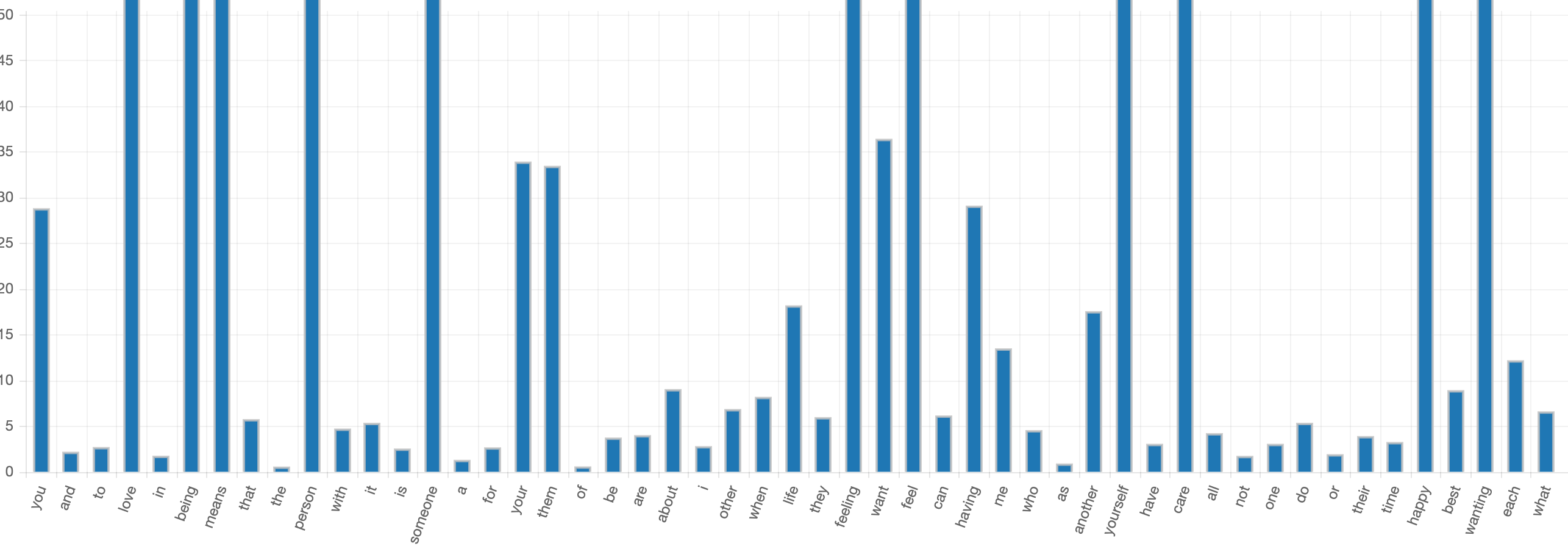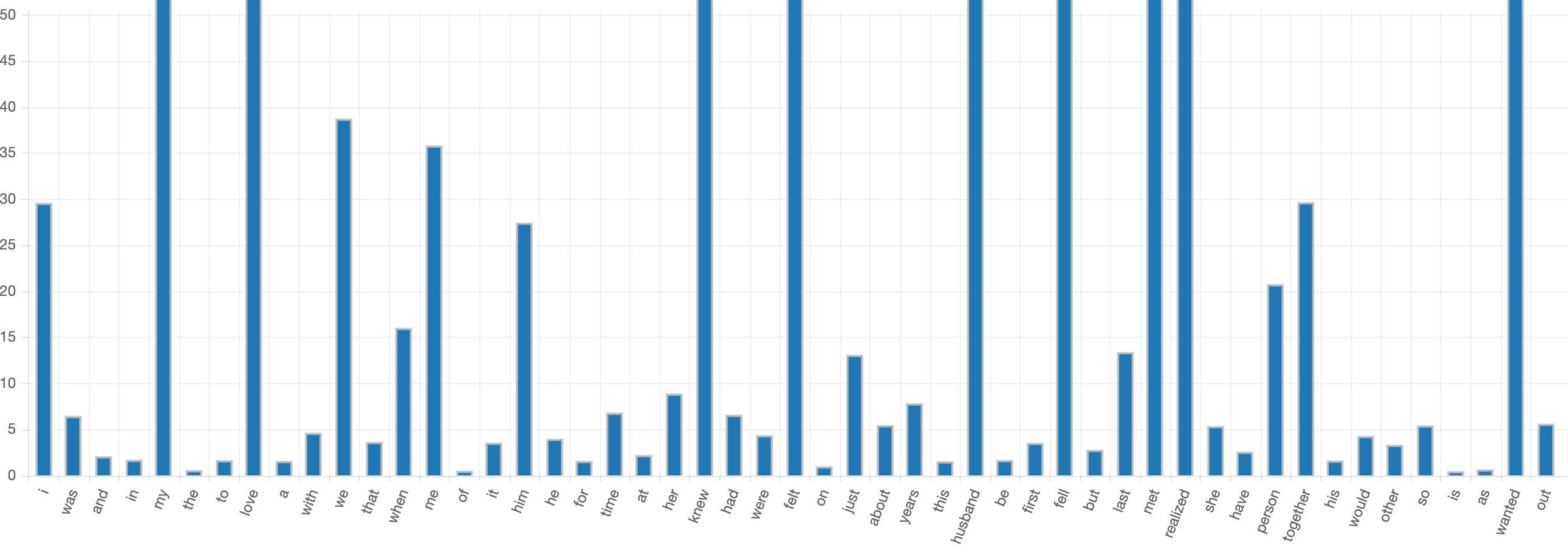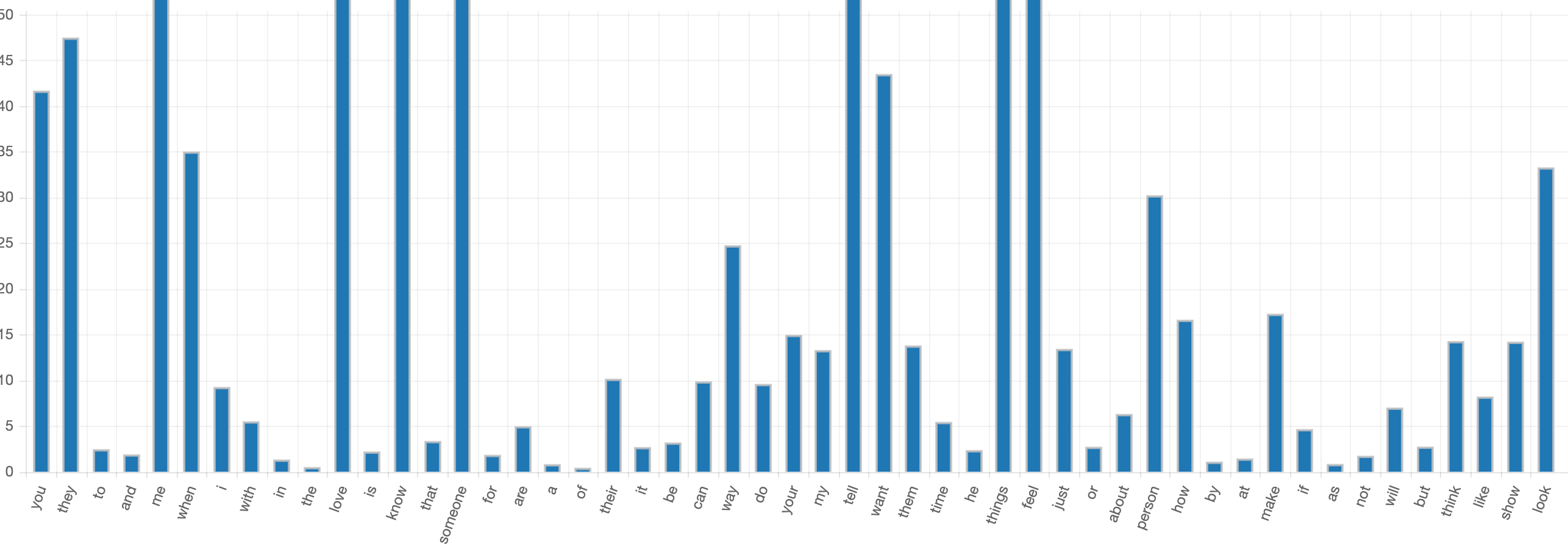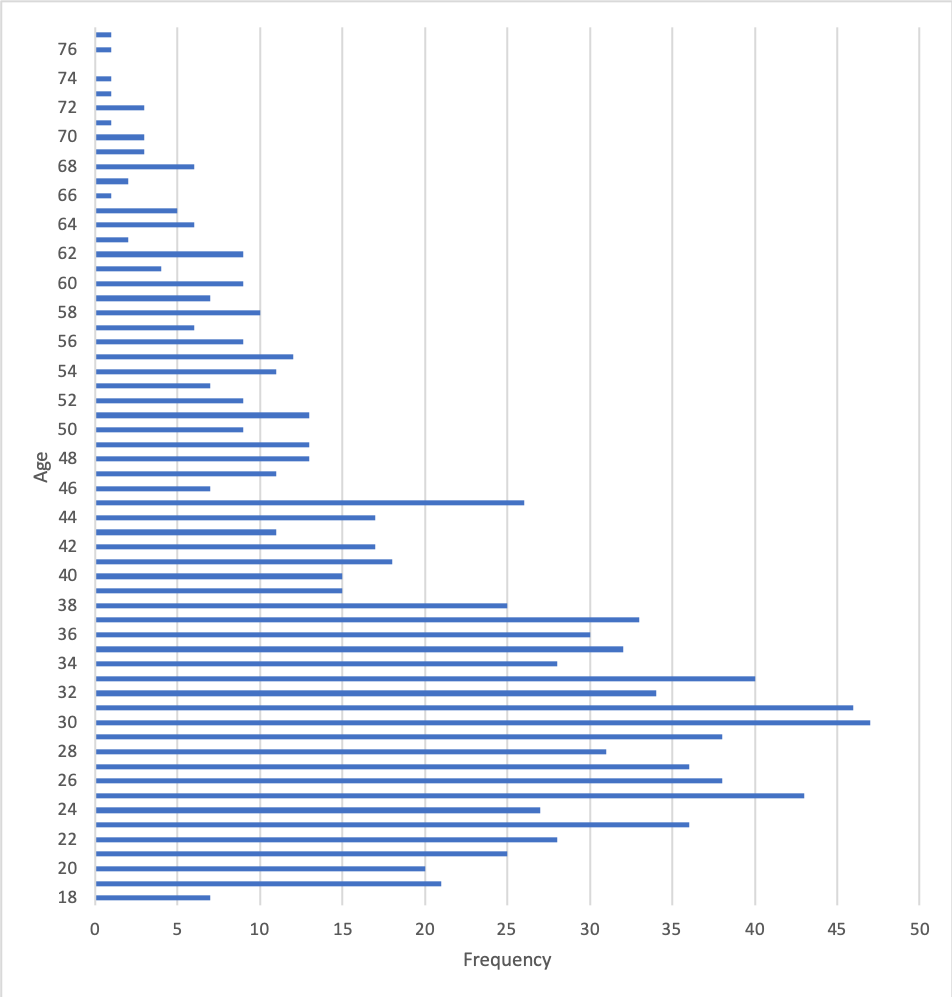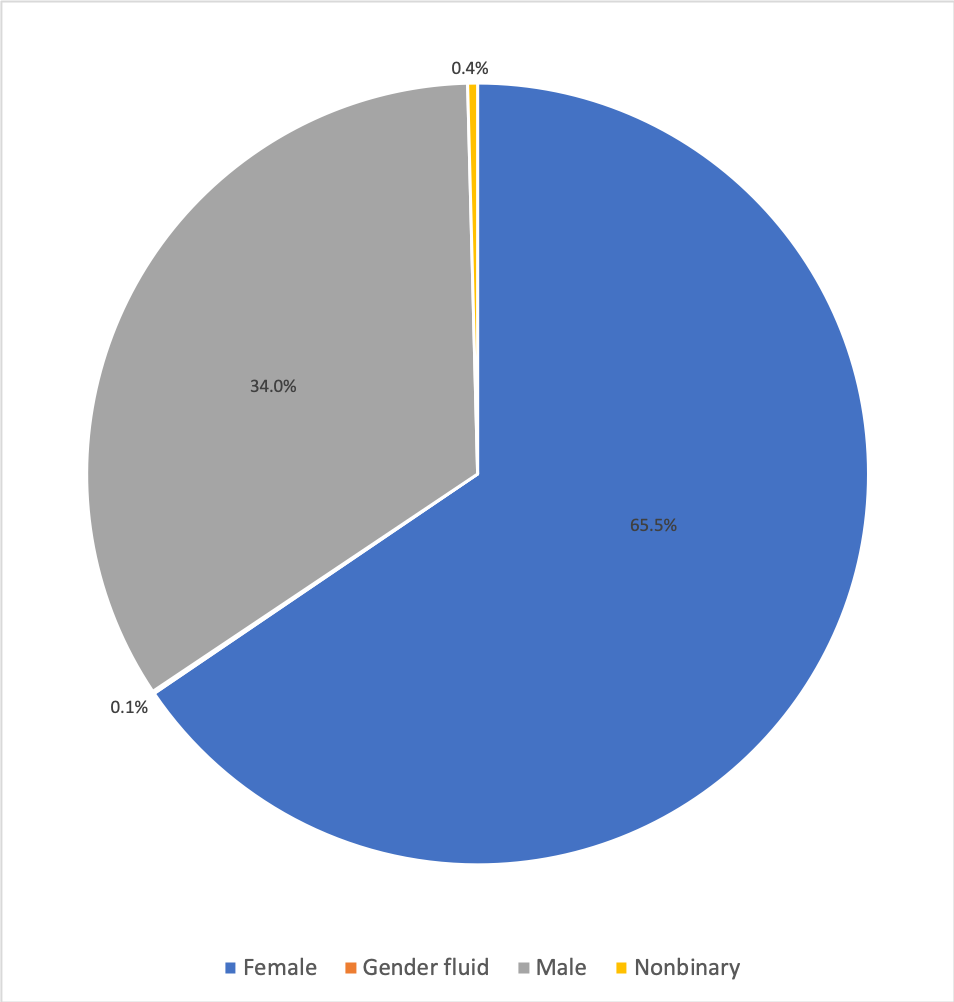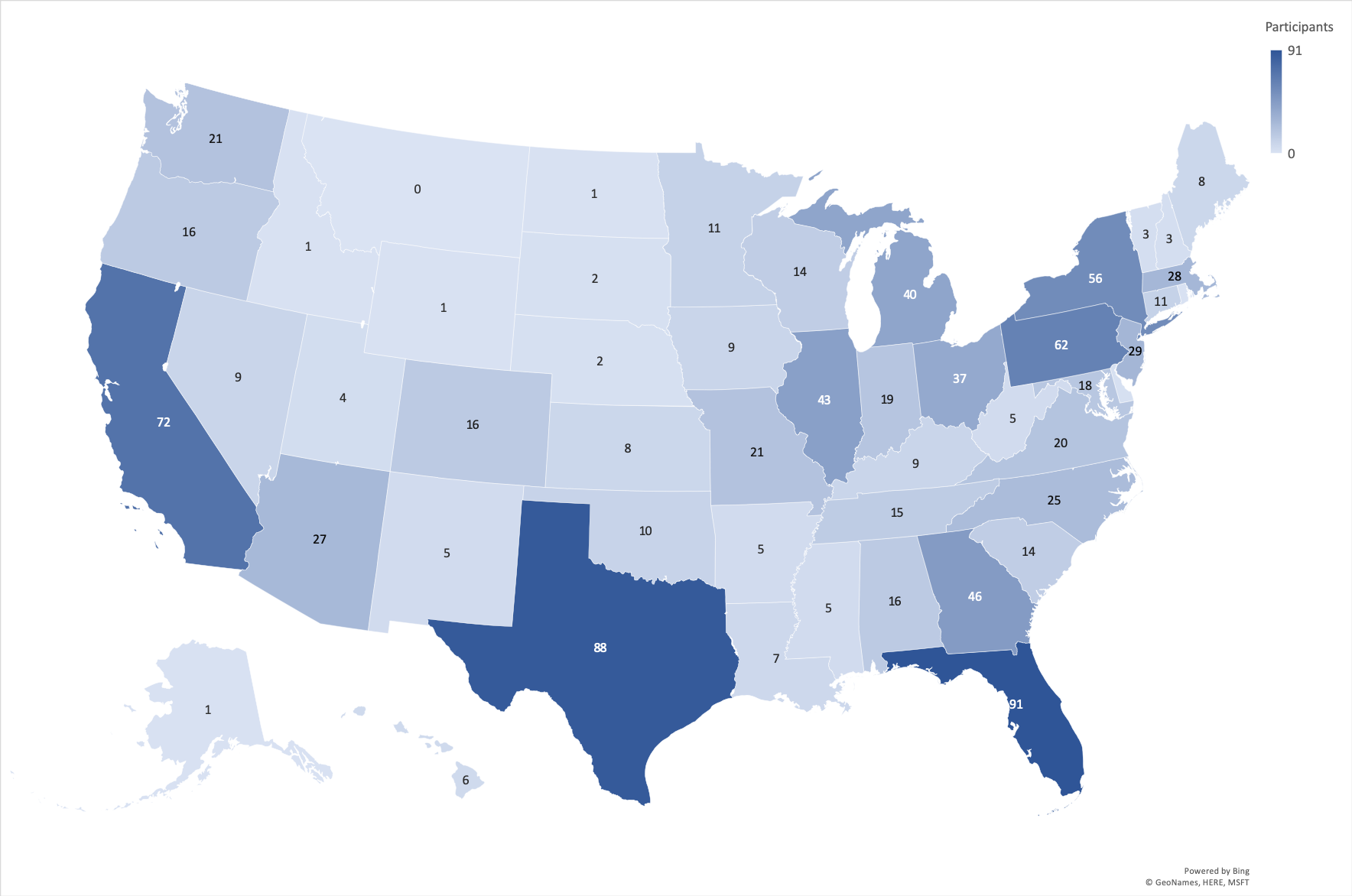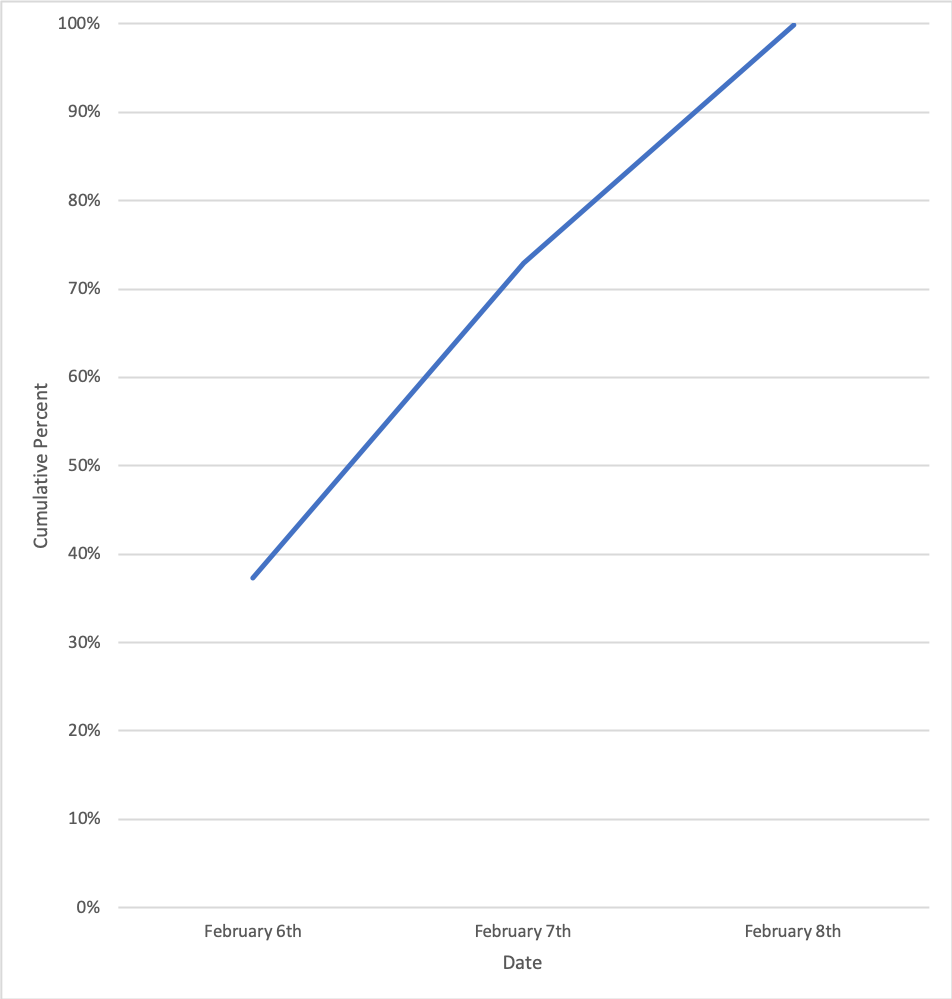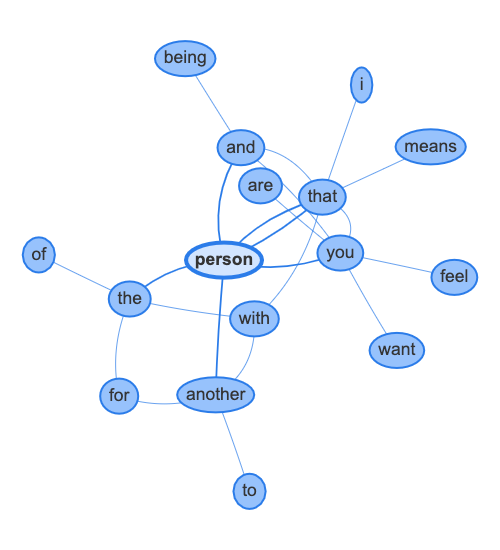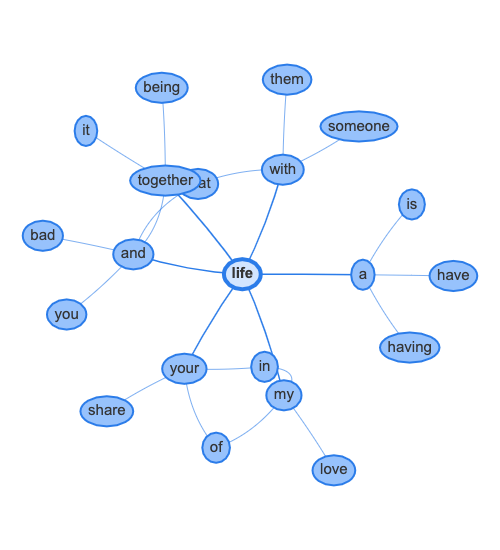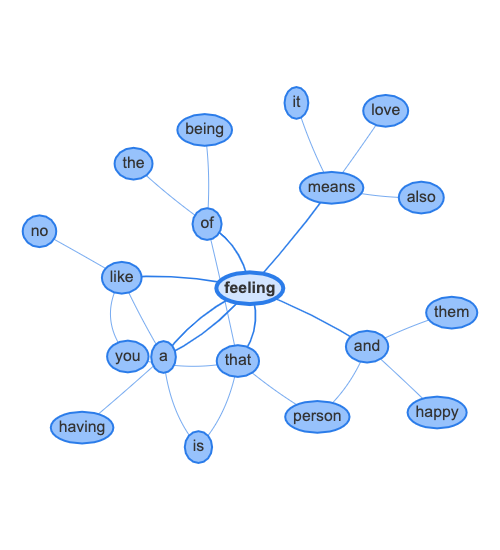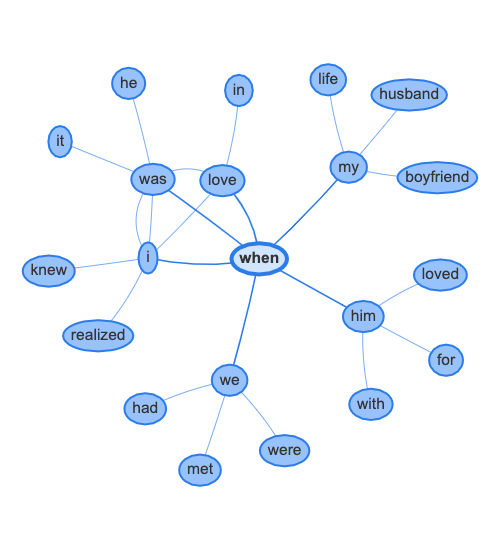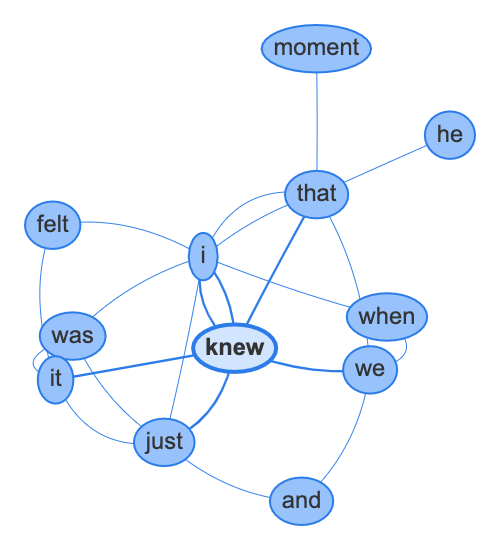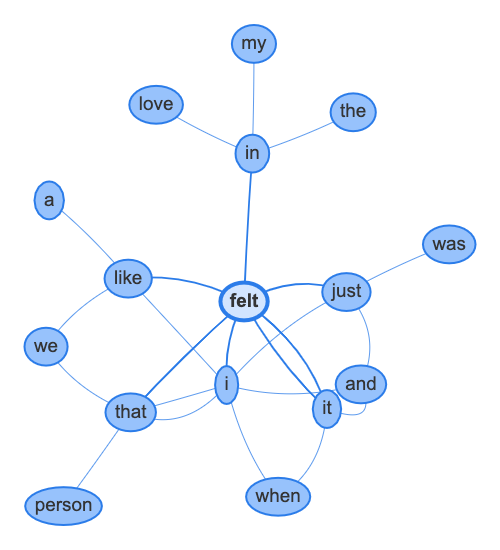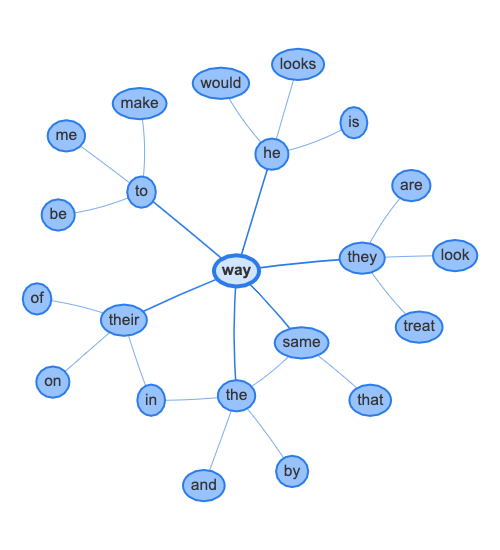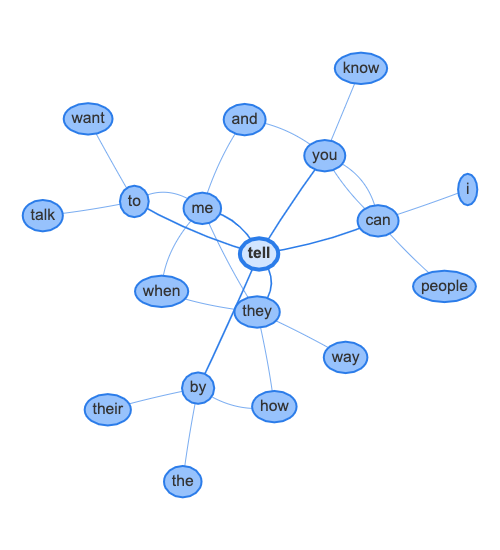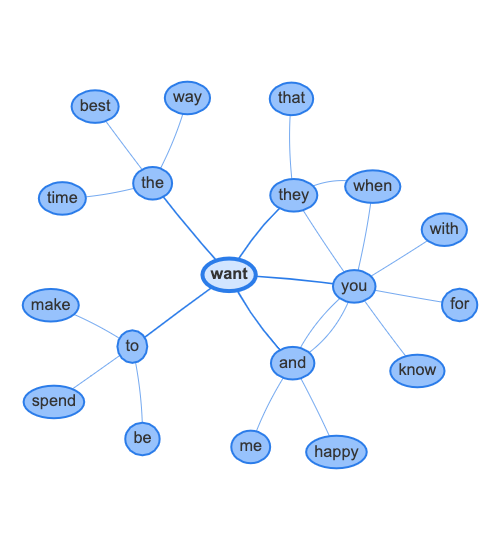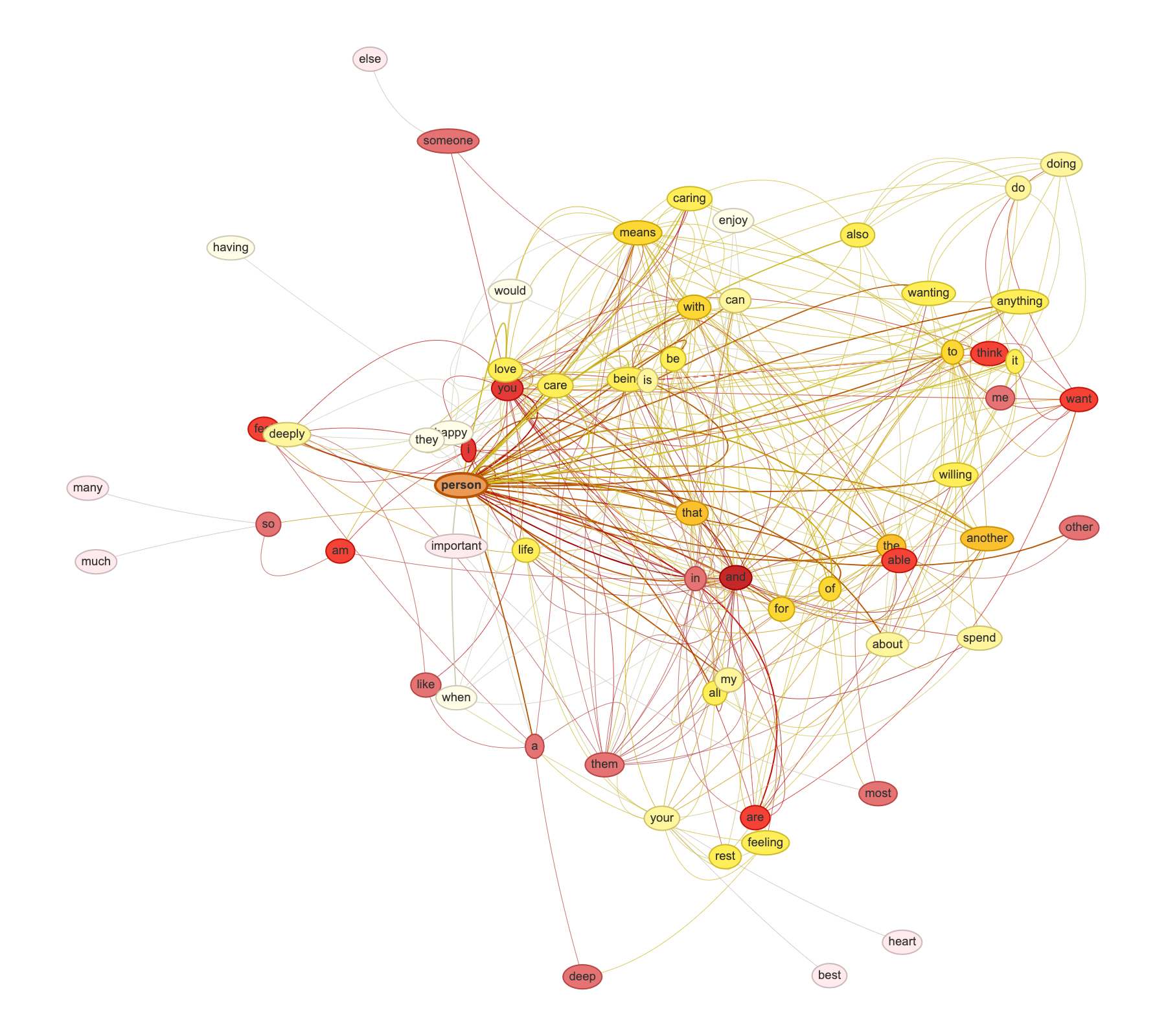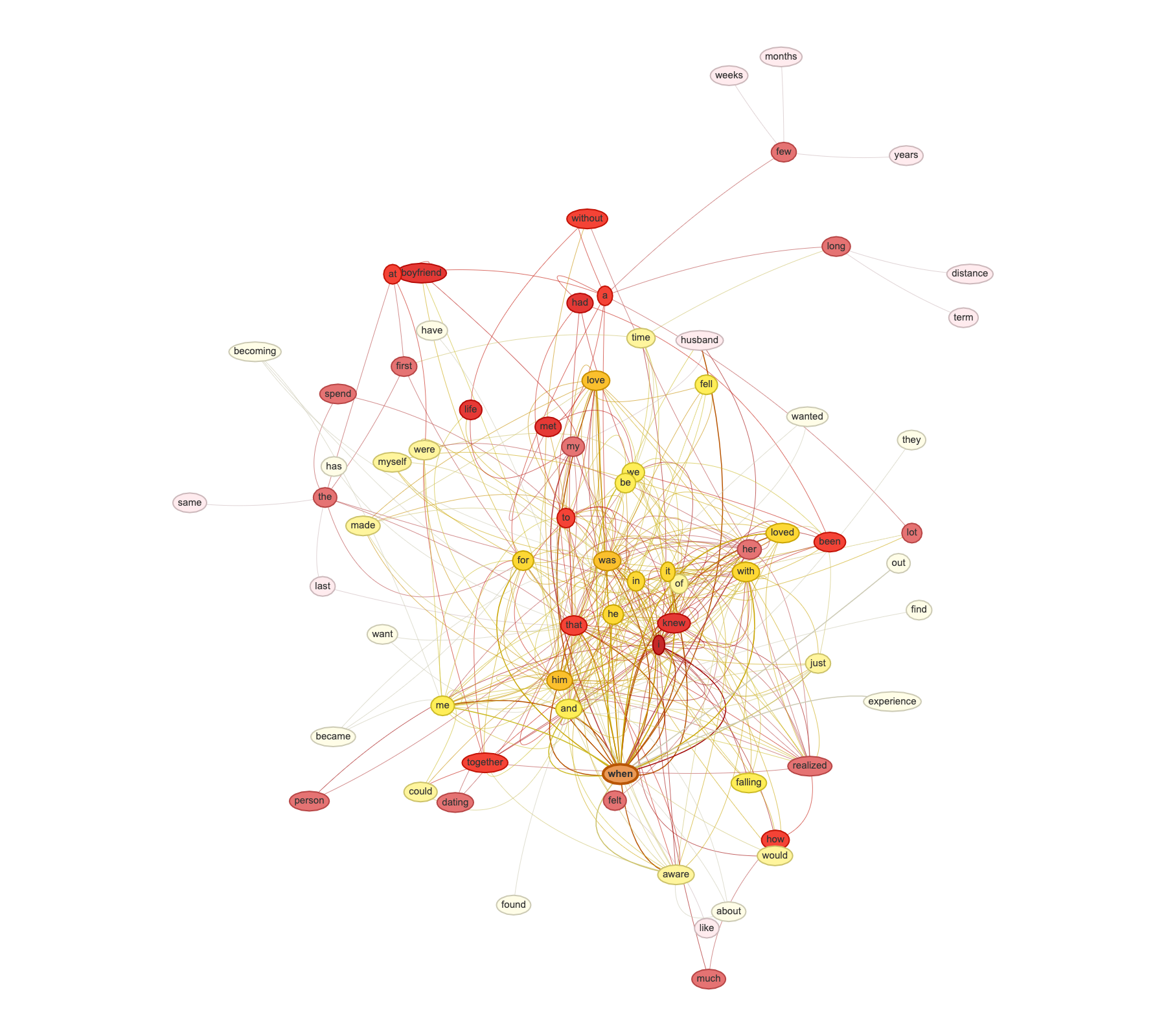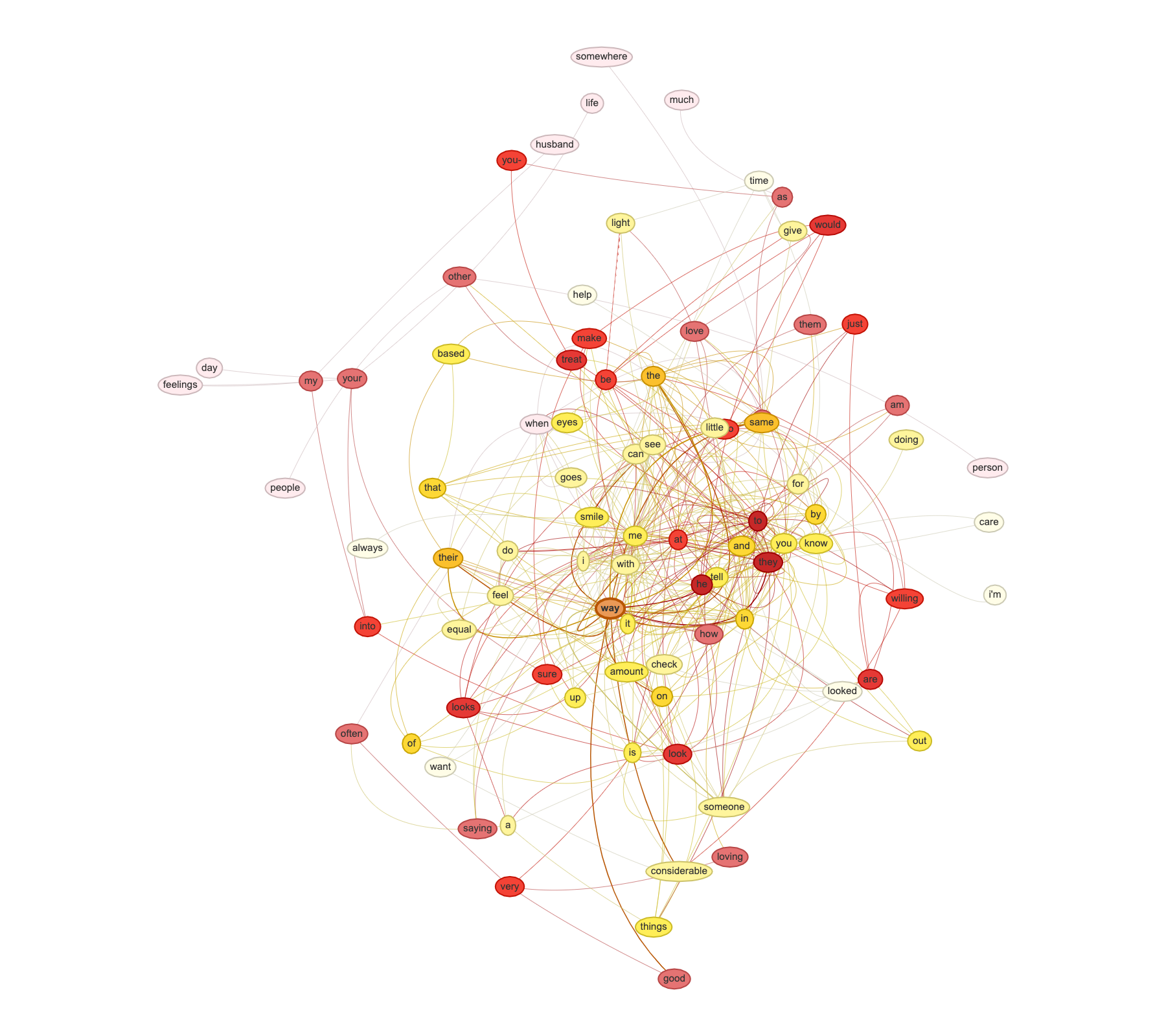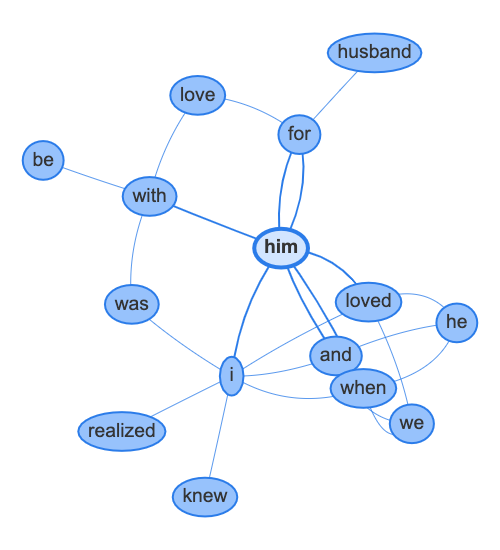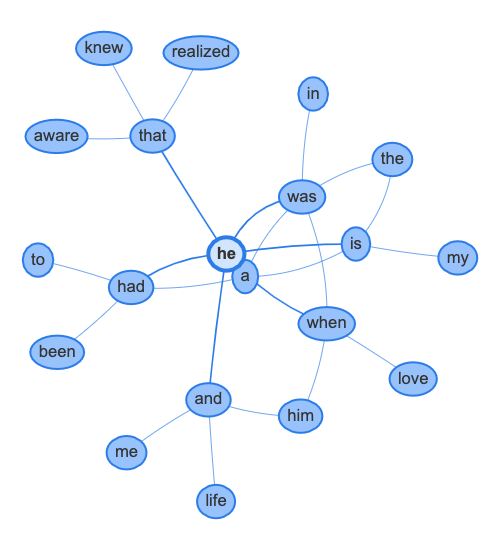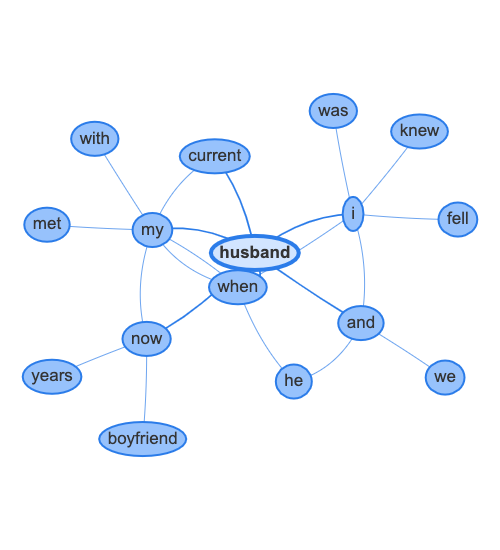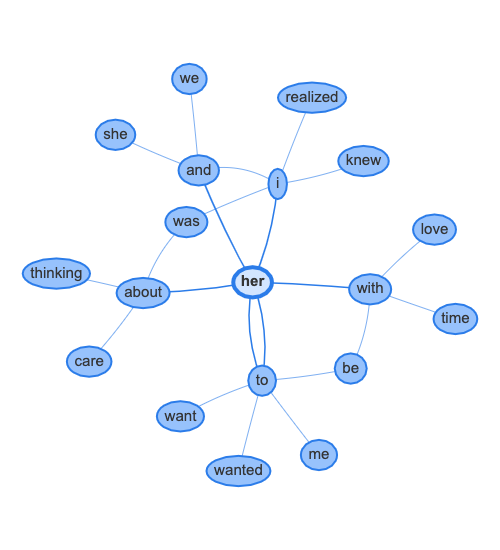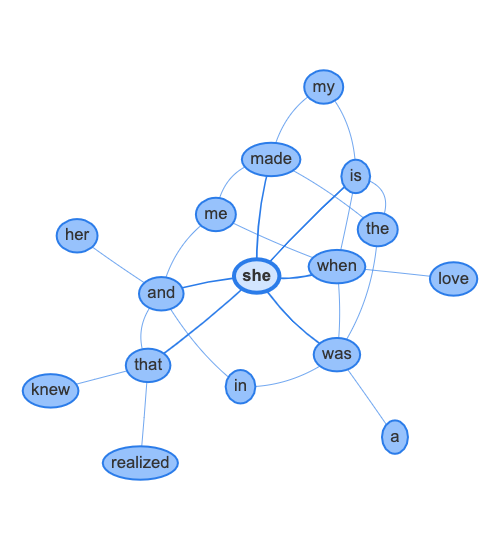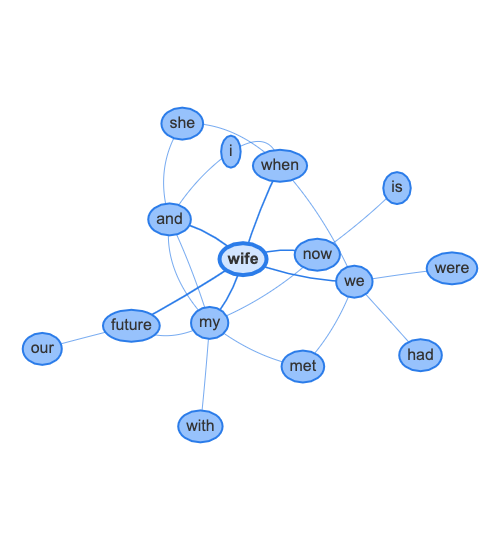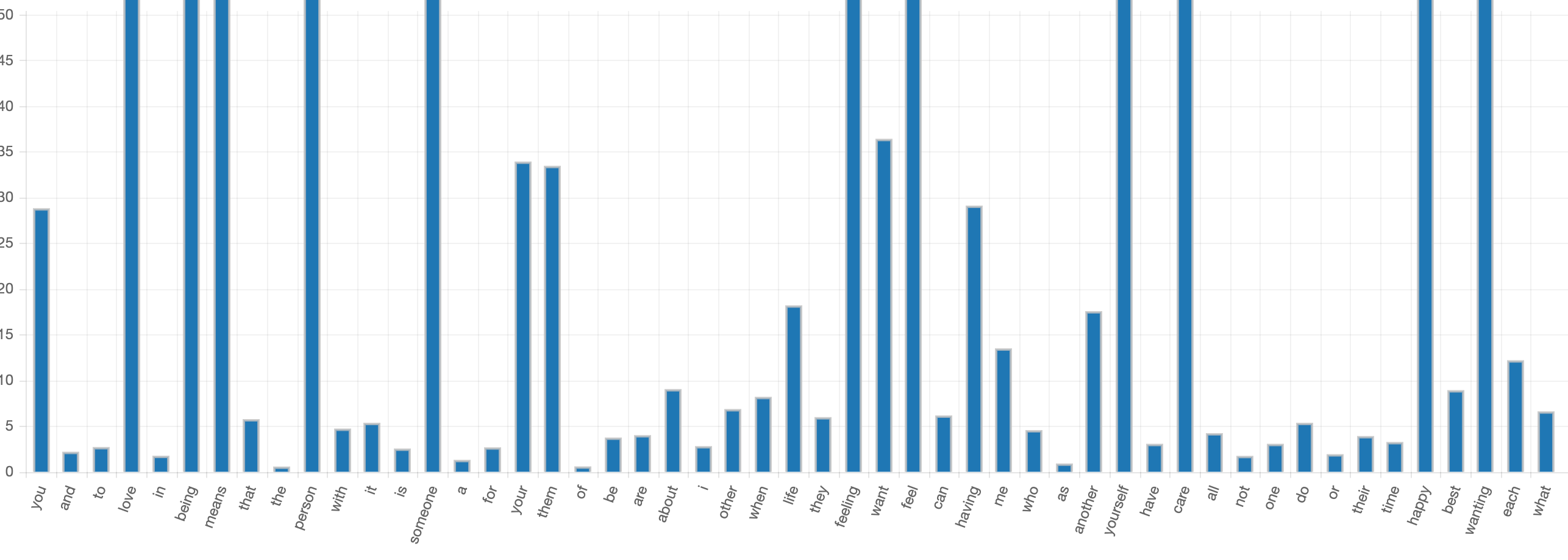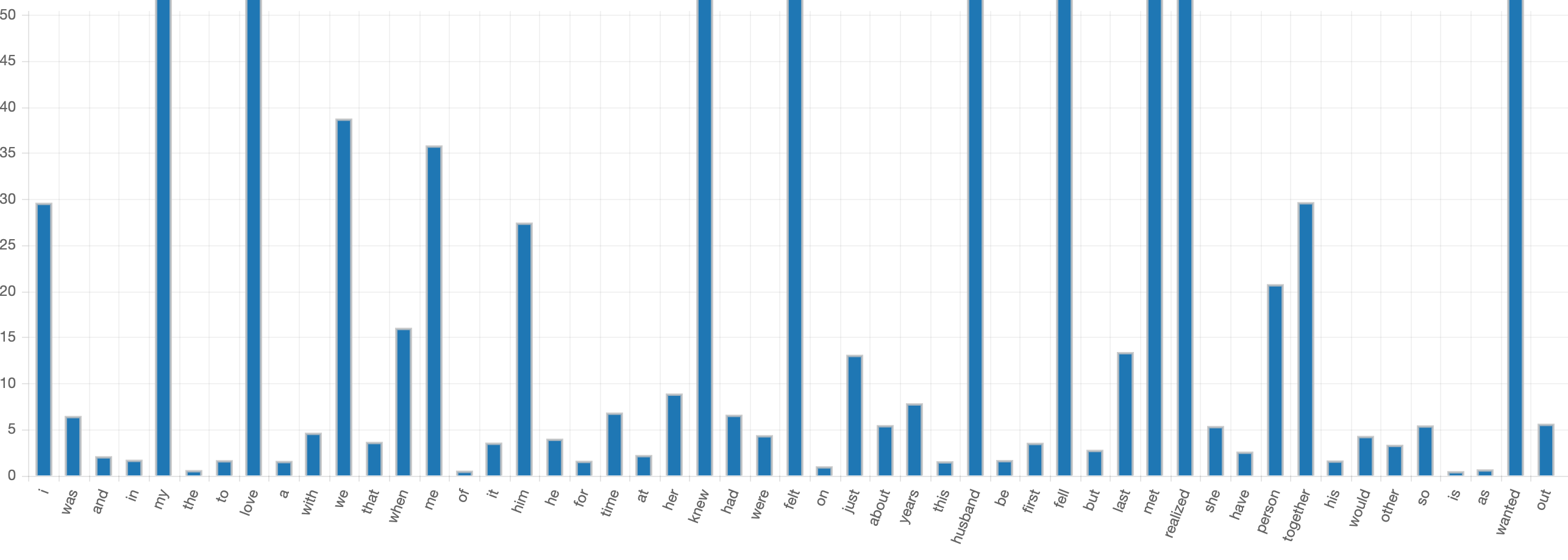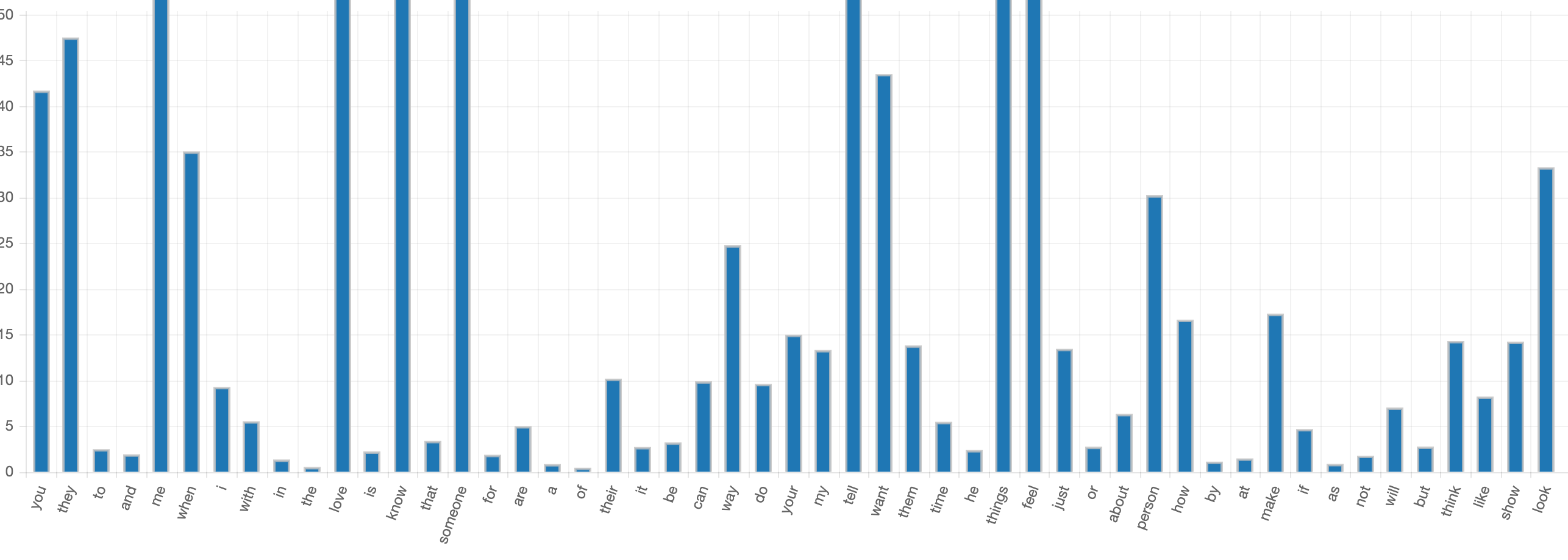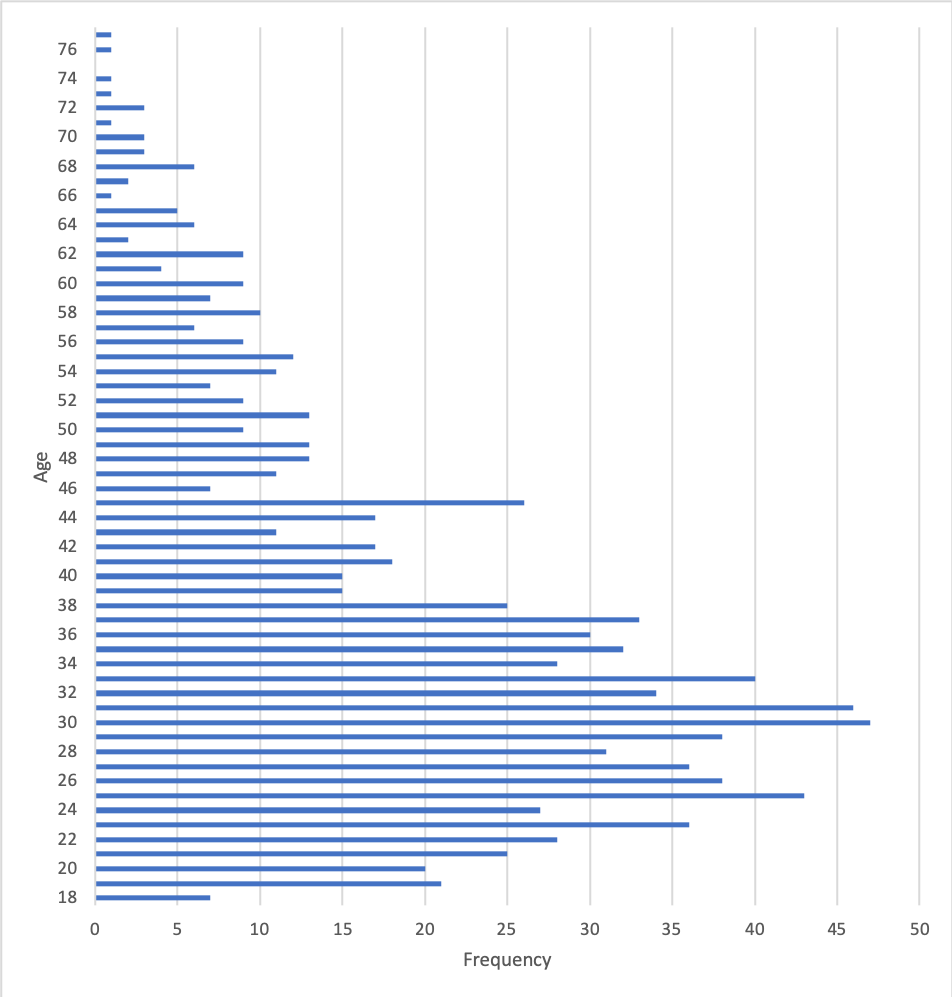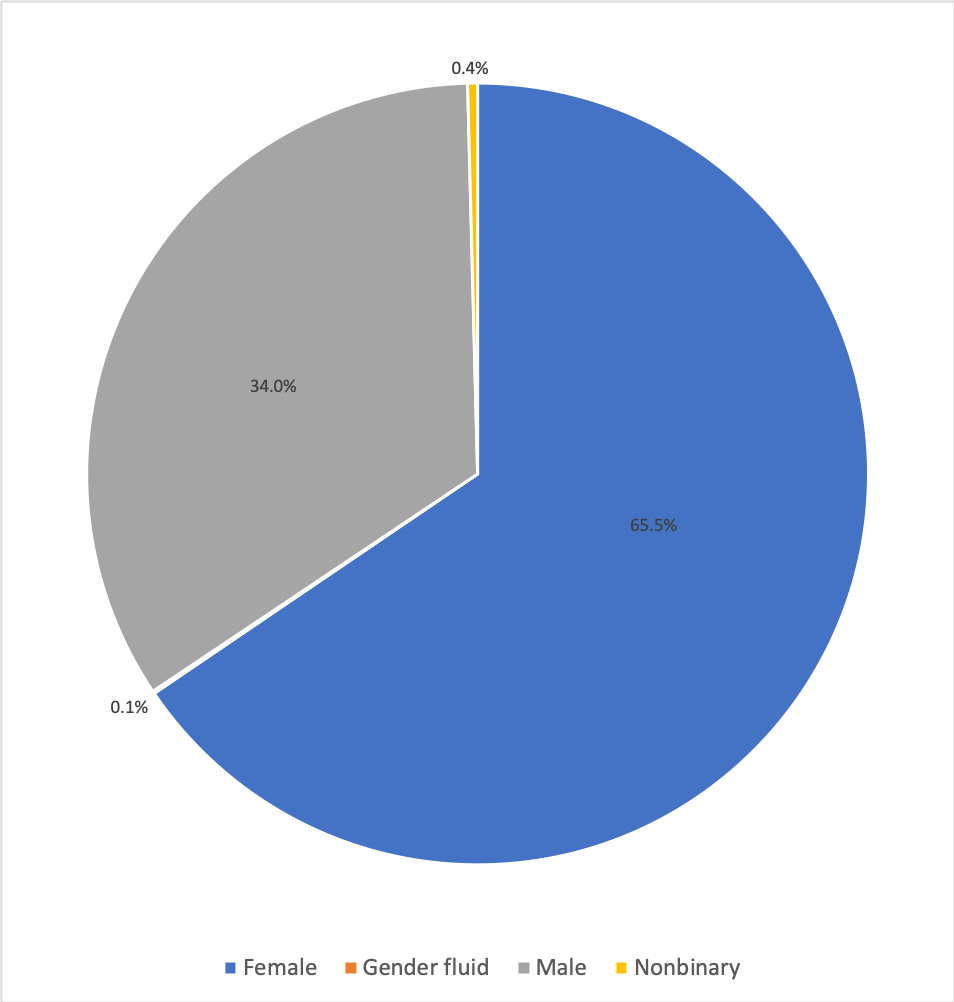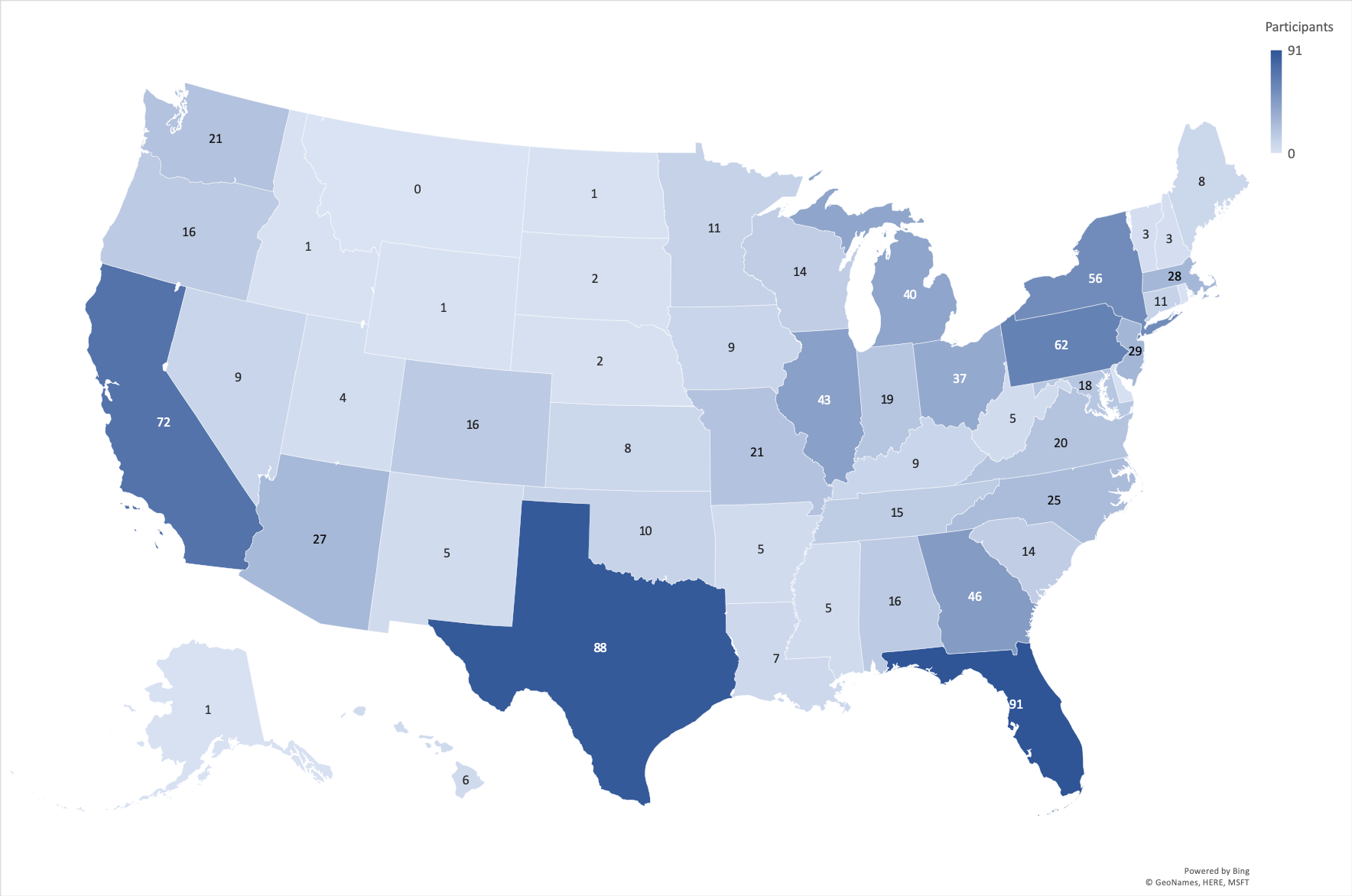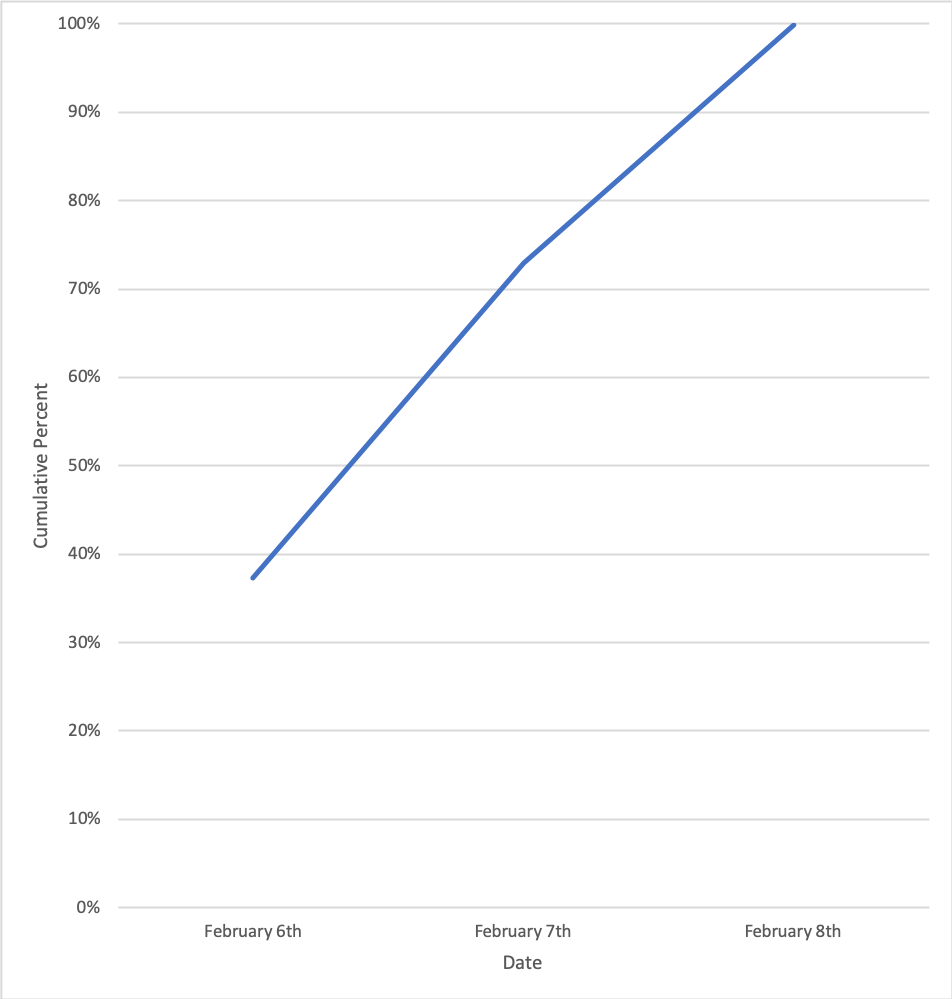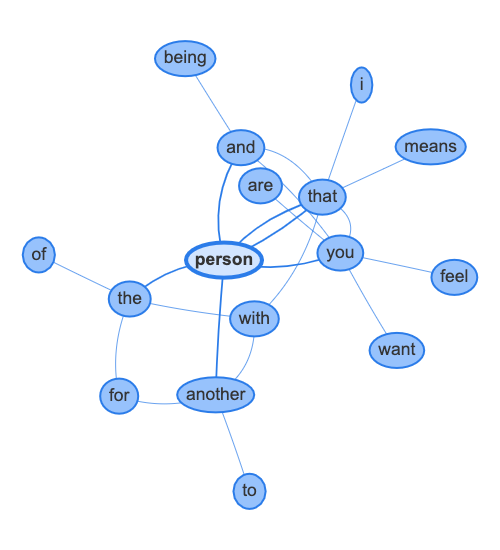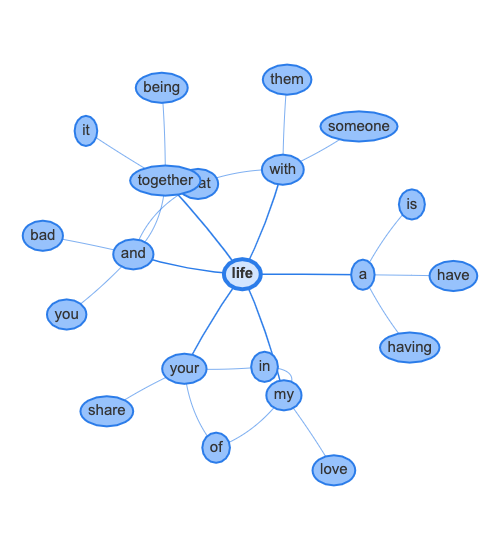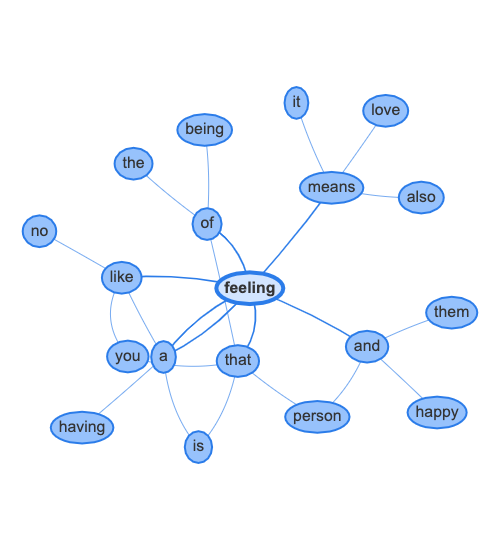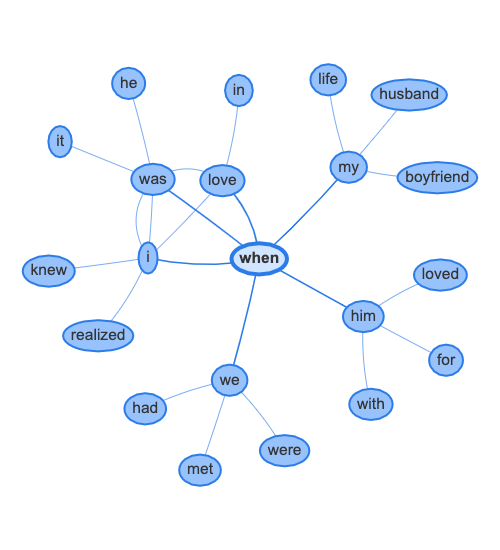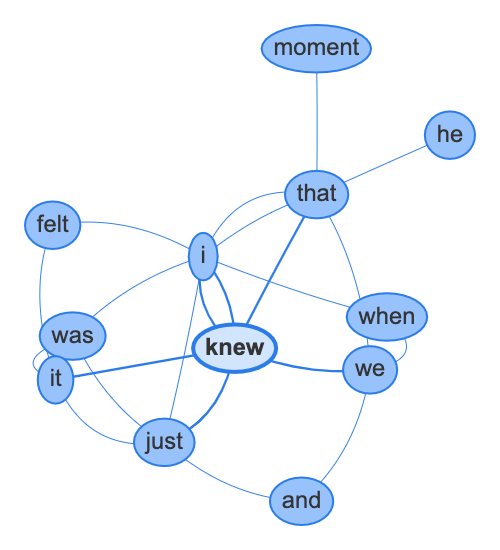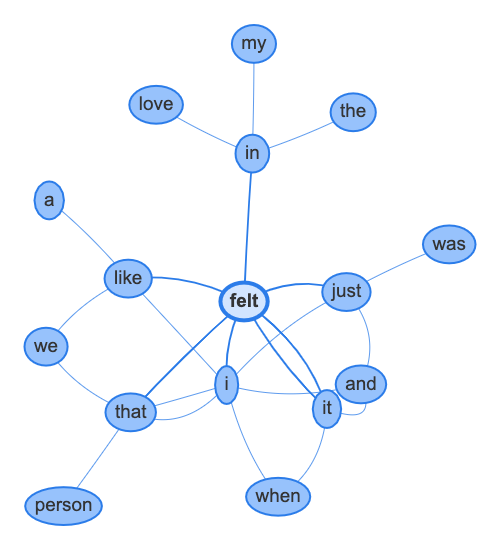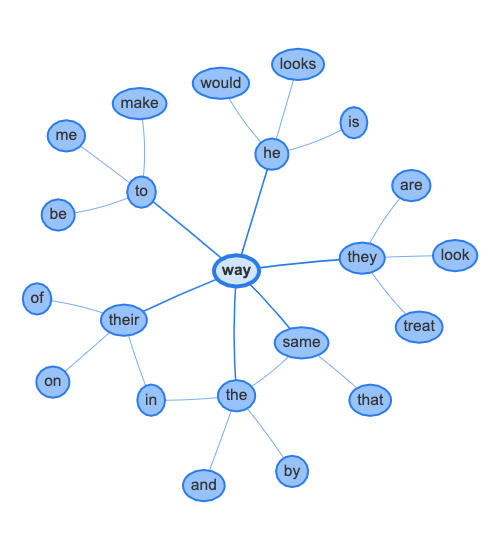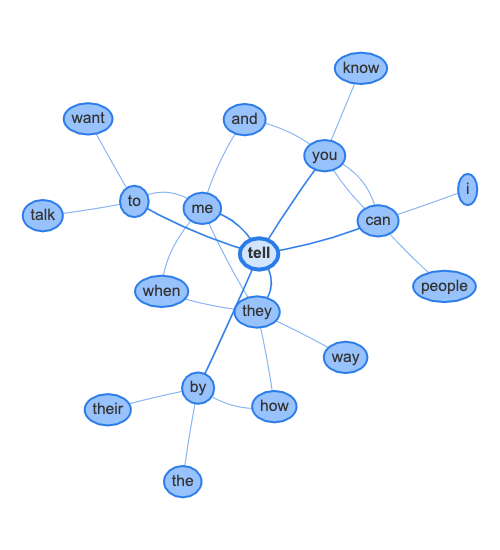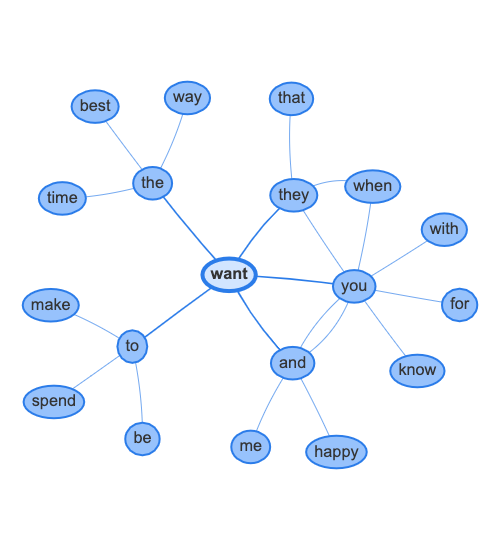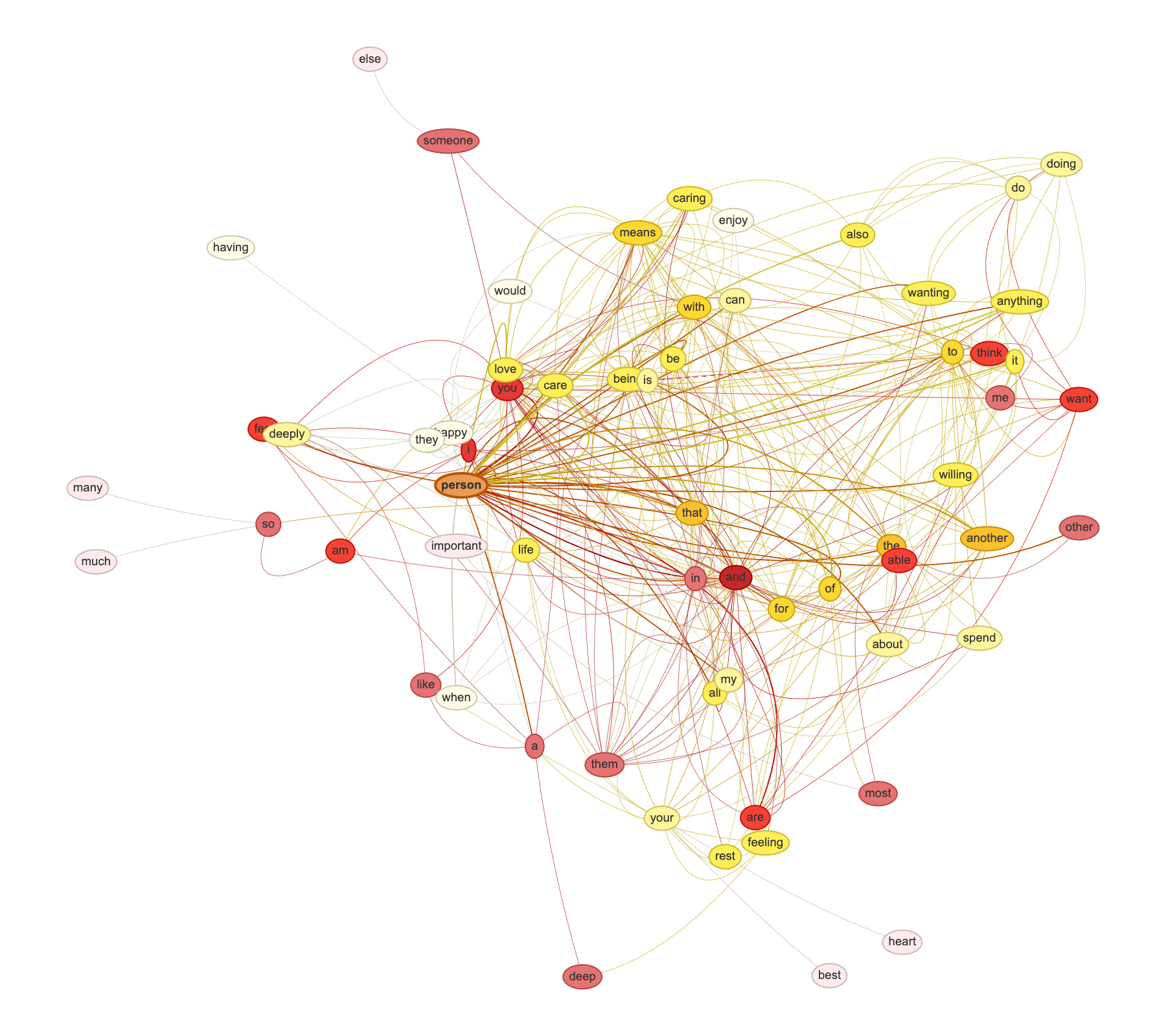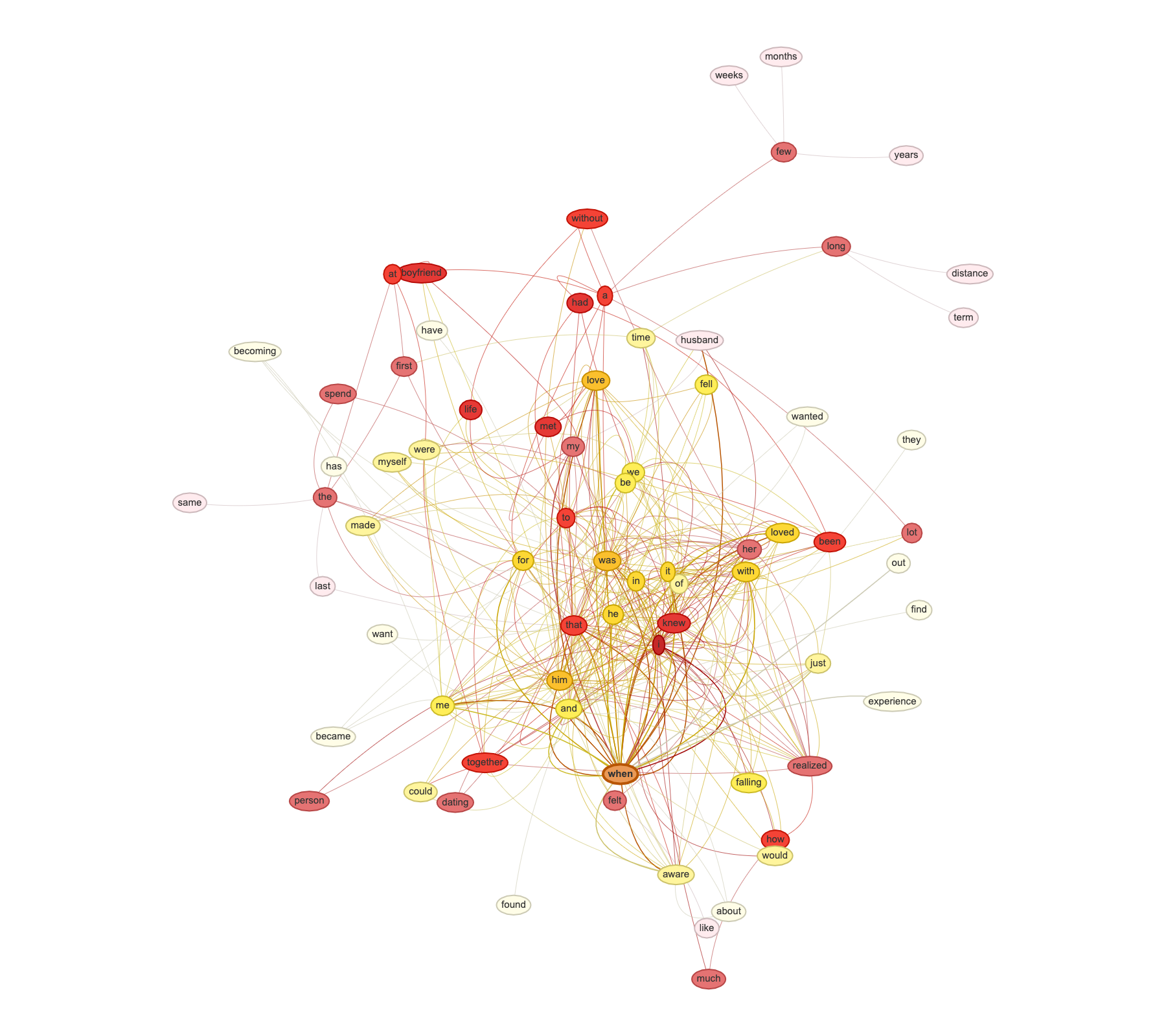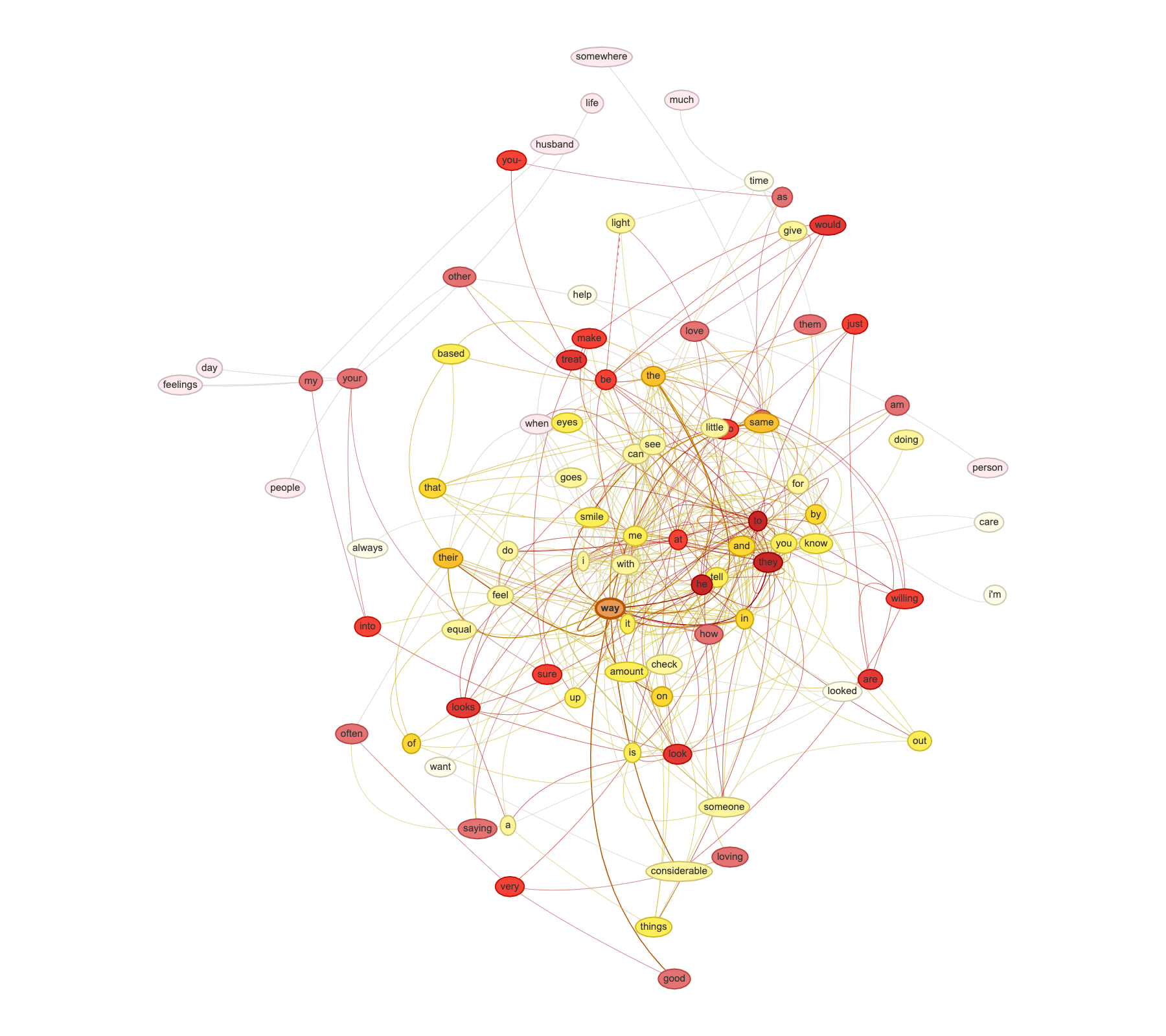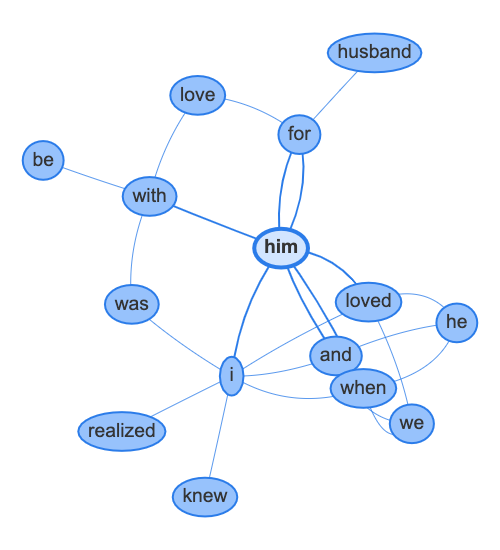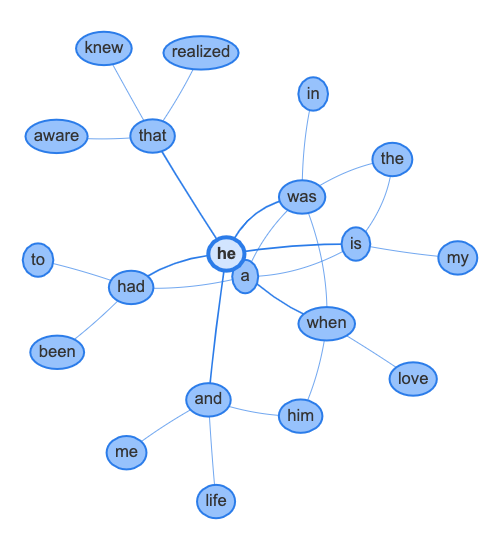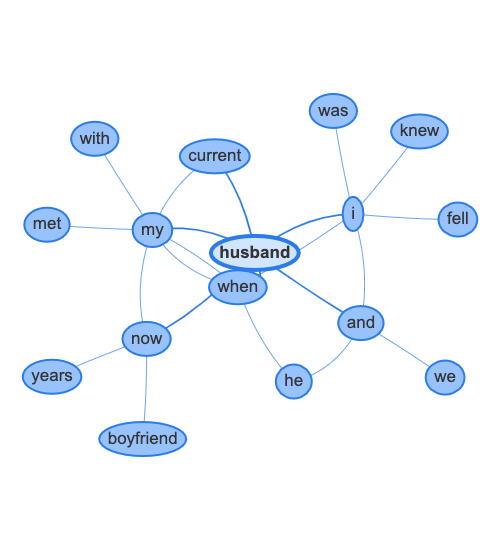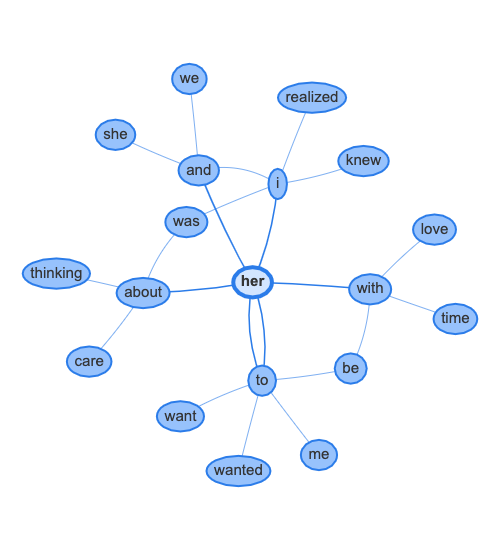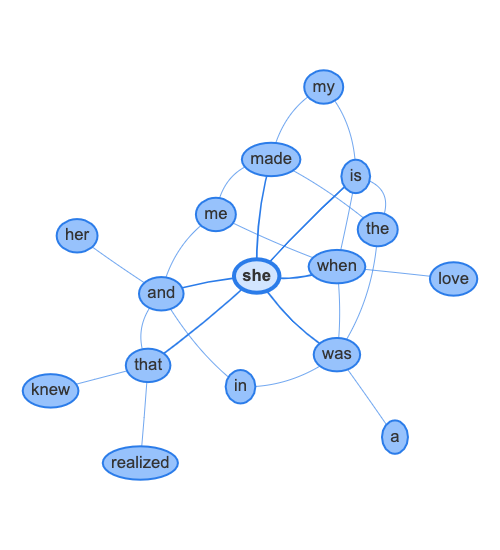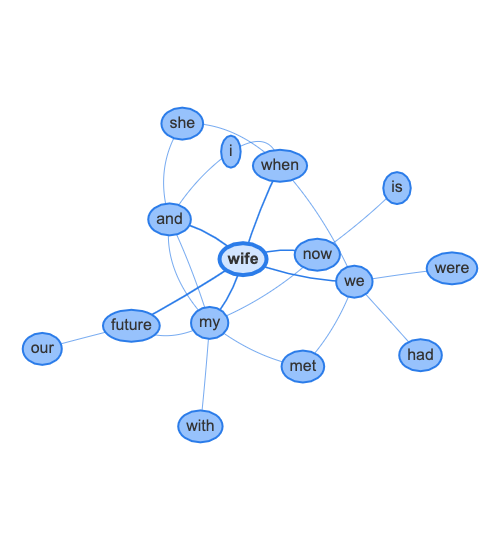Being in Love in the United States.
During February 6th - 9th, 2020, Raven's Eye conducted an online poll about experiences and perspectives on being in love among people located in the United States, via Amazon's Mechanical Turk1.
Our report.
This report presents the worldview derived from our findings, including: the foremost model statements, panorama, mood, viewpoints, brief elaborations on our model statements, exploration of the use of gendered pronouns in our responses, and this study's horizon. These findings are the result of a quantitative phenomenology performed in February, 2020, by the Raven's Eye team using our online natural language analysis software2. Examples of the worldviews on other topics may be found here.
Our attitude.
This survey analysis results from a quantitative phenomenology utilizing Raven's Eye. Our attitude is one that seeks to:
• reliably and validly understand people's thoughts according to both phenomenological and scientific processes, and
• create synthetic model statements that reproduce both the most popular themes in those thoughts, and the ways that participants express them.
What results are plain English statements that express the thoughts of the participants, in the way that they are ordered and structured by the participants themselves. We seek when possible to produce themes that may be generalized with confidence to various groups and populations.
Our survey.
In an online survey, we first asked participants acquired through Amazon's Mechanical Turk their age, gender and state of residence. Age and gender were formatted to allow free-responses, while state of residence was selected from a dropdown menu. Next, we asked participants to respond to the following three items over the course of 2-3 sentences each:
- In your own words, please tell us what does being in love mean to you?
- In your own words, please describe your last experience of becoming aware that you were in love.
- In your own words, please tell us, how do you know when someone is in love with you?
The main concepts utilized in our model statements were found at rates in excess of 15 times their typical use, and as such provide a measure of confidence in their association with the question posed3, 4. All such words in the model statements are emphasized in bold font, while the concepts around which the statements are created are also in blue text.
The worldview.
In your own words, please…

tell us, what does being in love mean to you?

describe your last experience of becoming aware that you were in love.

tell us, how do you know when someone is in love with you?
Foremost model statements.
Being in love means that person and you care deeply for each other.
Being in love means that you want to share your life with someone.
Being in love means feeling like you want to be with them all the time.
Foremost model statements.
I knew I was in love when I was dating, and met my (current) husband/wife.
I realized I was in love when I felt like I wanted to be together with him/her all the time.
I fell in love with my boyfriend/girlfriend when we were talking (on the phone).
Foremost model statements.
You know when someone is in love with you by the way they look at you.
You know when someone is in love with you when they tell you.
You know when someone is in love with you when they want to be with you all the time.
The panorama.
Revealing the worldview's panorama involves understanding the general content and form of the natural language data acquired in response to our free response item. To do this, we first identify the gists, or individual word forms that are relatively overrepresented in them3. We then consider the overall style of the response set through measures of its vocabulary and verbosity. These gists and this style information then give us a sense of the whole—or as we call it, the panorama—presented by the worldview.
-
In your own words, please tell us what does being in love mean to you?
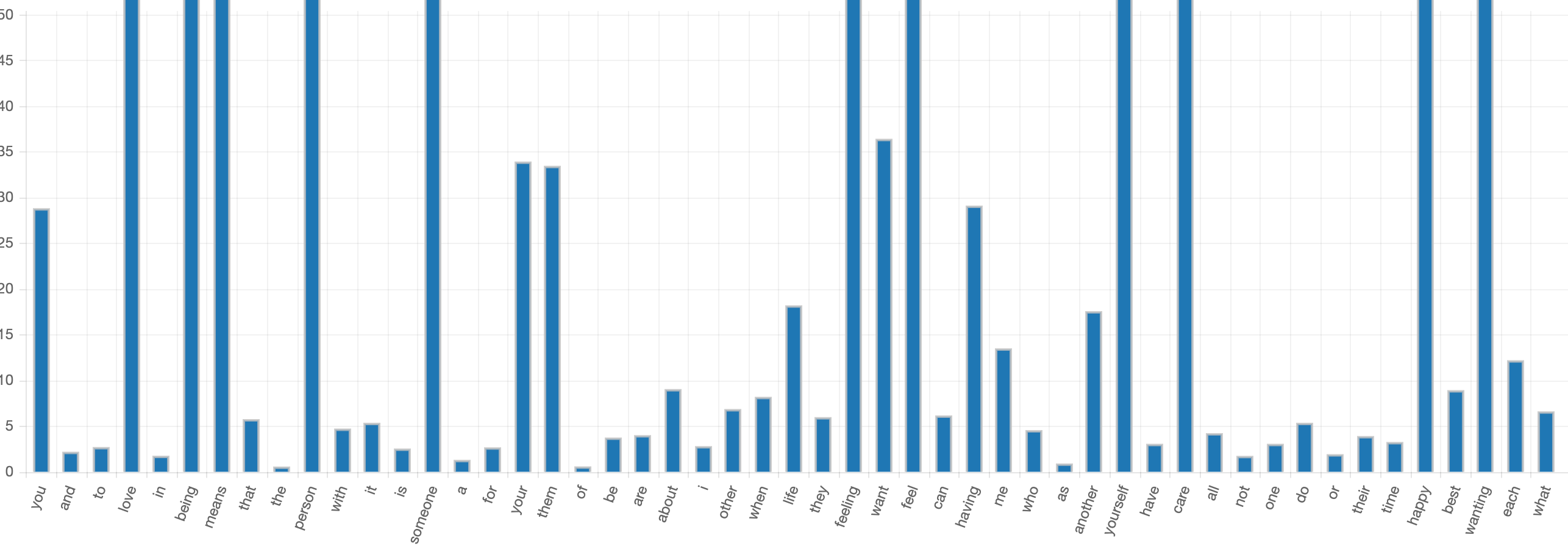
Figure 1. The fifty most frequent words in response to the item: In your own words, please tell us what does being in love mean to you? The vertical axis represents the number of times that a word is found to be relatively overrepresented in the response set.
As visualized in Figure 1, in addition to words related to the question (such as love, in, being, and means), concepts such as you, person, someone, your, them, life, feeling, want, feel, having, another, yourself, care, happy, and wanting are central to the messages of our respondents. The readability and grade-level scores indicate a simple sentence structure and low-average vocabulary, while the average response consists of just under 11 words over the course of 2-3 sentences, which indicates predominantly short sentences. Table 1 displays these measures of verbosity and vocabulary.
Measure
Score
Flesch Readability
73.31
Flesch-Kincaid Grade Level
6.56
Average Cell Word Count
10.83
Table 1. Measures of vocabulary and verbosity for responses to the item: In your own words, please tell us what does being in love mean to you?
-
In your own words, please describe your last experience of becoming aware that you were in love.
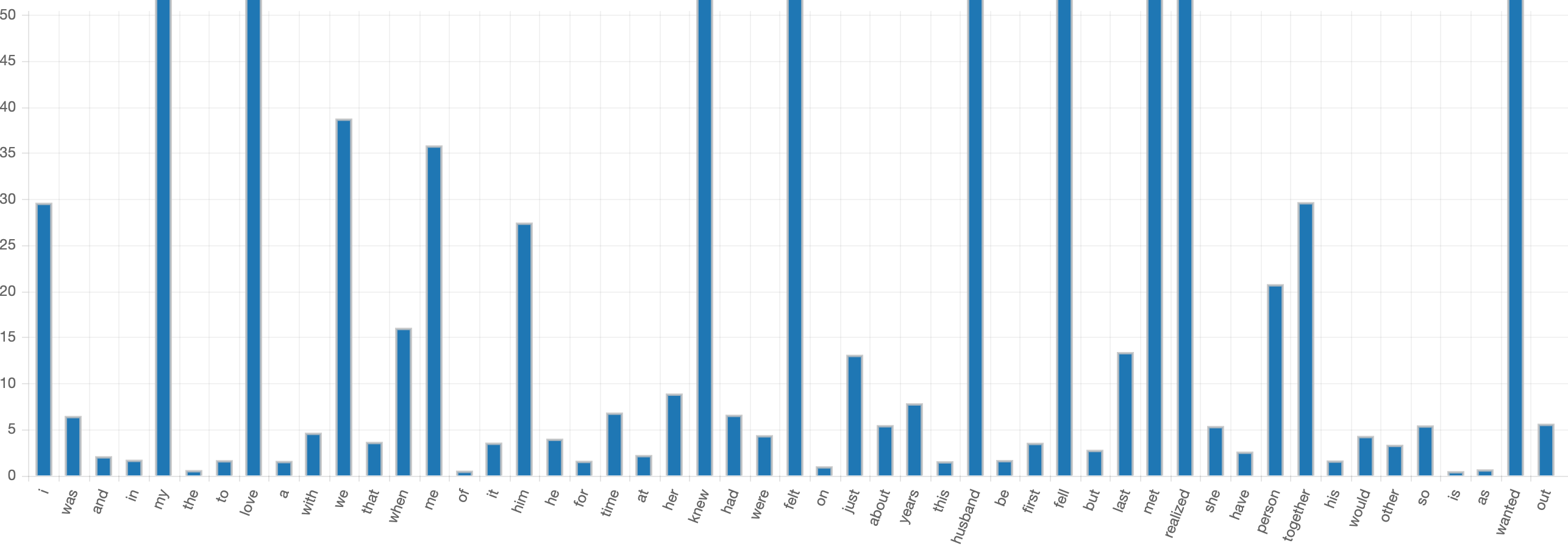
Figure 2. The fifty most frequent words in response to the item: In your own words, please describe your last experience of becoming aware that you were in love. The vertical axis represents the number of times that a word is found to be relatively overrepresented in the response set.
As visualized in Figure 2, in addition to words related to the question (such as I and love), concepts such as my, we, when, me, him, knew, felt, husband, fell, met, person, together, and wanted are central to the messages of our respondents. Similar to the responses to the item on being in love, the readability and grade-level scores for people's responses about becoming aware that they were in love indicate a simple sentence structure and low-average vocabulary. The responses to this item were a bit longer, with the average response to this item consisting of about 14 words over 2-3 sentences. Table 2 displays these measures of verbosity and vocabulary.
Measure
Score
Flesch Readability
79.59
Flesch-Kincaid Grade Level
6.13
Average Cell Word Count
14.43
Table 2. Measures of vocabulary and verbosity for responses to the item: In your own words, please describe your last experience of becoming aware that you were in love.
-
In your own words, please tell us, how do you know when someone is in love with you?
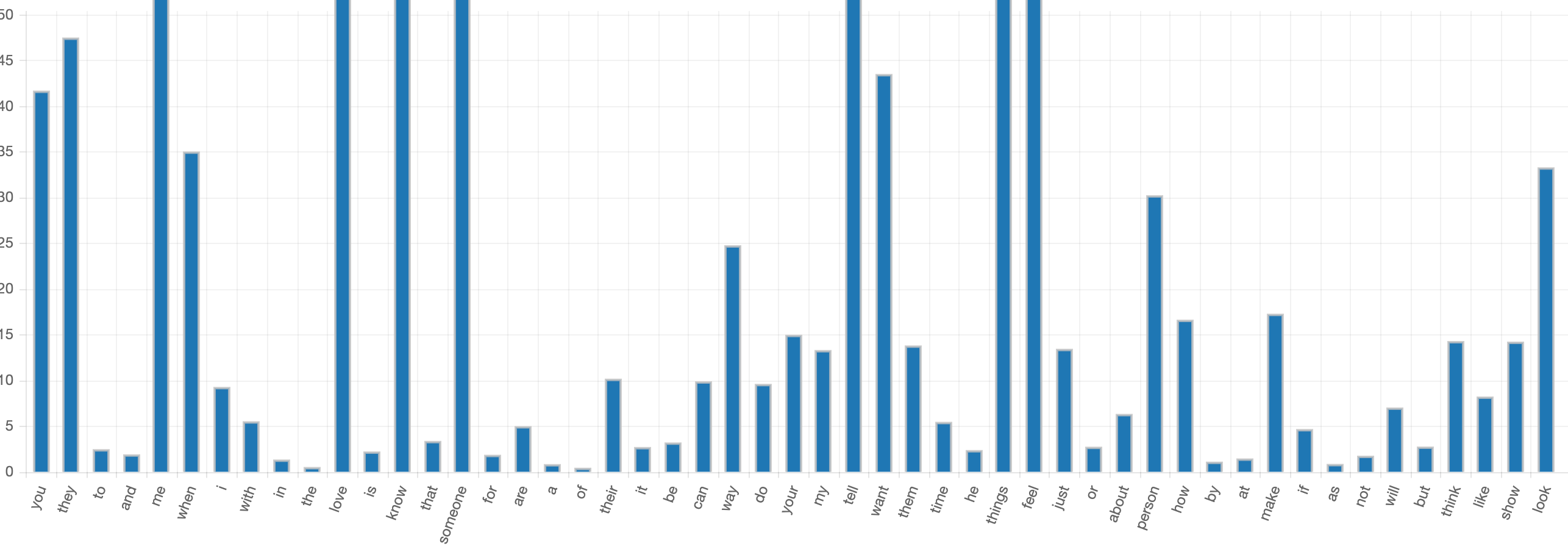
Figure 3. The fifty most frequent words in response to the item: In your own words, please tell us, how to do you know when someone is in love with you? The vertical axis represents the number of times that a word is found to be relatively overrepresented in the response set.
As visualized in Figure 3, in addition to words related to the question (such as you, when, love, know, and someone), concepts such as they, me, way, tell, want, things, feel, person, how, make, and look are central to the messages of our respondents. Similar to the responses to the first two items, the readability and grade-level scores for this item also indicate a simple sentence structure and low-average vocabulary. The responses to this item were shorter than the responses to the previous two items, with the average response to this item consisting of just over 9 words across 2-3 sentences. Table 2 displays these measures of verbosity and vocabulary.
Measure
Score
Flesch Readability
84.68
Flesch-Kincaid Grade Level
5.03
Average Cell Word Count
9.48
Table 3. Measures of vocabulary and verbosity for responses to the item: In your own words, please tell us, how to do you know when someone is in love with you?
The mood.
The foremost ranked few words of any dataset utilizing quantitative phenomenology reveal the general mood of that dataset. A mood comprises the general way in which a topic or event is approached or considered, i.e., whether it is self-reflective, object-oriented, or other-oriented. We discuss the mood for each of the three items separately, because they each display somewhat different moods.
What being in love means.
Becoming aware of being in love.
Know when someone is in love with you.
The primary aspect of mood in the item asking respondents what being in love means is other-oriented, as revealed by the words, "you," and "your." This indicates that the content is primarily oriented toward others. Since it is in the second-person, it could perhaps reflect a response to the questioner. The secondary aspect of mood for this item is relationally object-oriented and present-tense, as revealed by the words "and," "to," "that," "the," "with," "it," "is," "a," and "for," among others. That is, the language produced in response to this item is secondarily about objects, generally in the present tense. Prepositions such as "and," "to," "with," and, "for," are generally used to describe an object in relation to another object or person, and are therefore relational. The words, "is," and "are" reveal the present-tense A somewhat weakly present third aspect of mood for this item is self-reflective, as revealed by the words, "I," and "me."
The primary aspect of mood in the item asking respondents about when they became aware of being in love is self-reflective, as revealed by the words, "I," "my," "we," and "me." This indicates that the content is primarily about the self and its possessions in the past. The individual sense of self is most predominate in this item, but the collective self is also present (via "we"). The secondary aspect of mood for this item is relationally object-oriented and past-tense, as revealed by the words "was," "and," "in," "the," "to," "a," "with," and "that," among others. That is, the language produced in response to this item is secondarily about objects, generally in the past tense. Prepositions such as "and," "in," "to," and, "with," are generally used to describe an object in relation to another object or person, and are therefore relational. The words, "was," "had," and "were" reveal the past-tense. The third aspect of mood for this item is, other-oriented, as revealed by the words, "him," "he," and "her," among others. In addition to self-reflection and object evaluation, other people are also involved in the experience of becoming aware that one is in love.
The primary aspect of mood in the item asking respondents how you know when someone is in love with you is other-oriented, as revealed by the words, "you," "they," and "their." This indicates that the content is primarily other evaluative, although the use of both send-person and third-person pronouns indicates two different others being considered. The secondary aspect of mood for this item is relationally object-oriented and present tense, as revealed by the words "to," "and," "with," "in," "the," "is," that, and "for," among others. That is, the language produced in response to the this item is secondarily about objects in relation to each other. Prepositions such as "to," "and," "with," "in," and, "for," are generally used to describe an object in relation to another object or person, and are therefore relational. The word, "is," reveals the present-tense. The third aspect of mood for this item, is self-reflective, as revealed by the words, "me," "I," and "my." These words reveal that in addition to evaluations of the other person and objects, self-reflection is also involved in knowing when another person is in love with you,
While all three items invoke reflection on the self, other people, and environmental objects, their order of emphasis differs. The questions on what it means to be in love and how you know when someone is in love with you are both primarily other evaluative, while the question about becoming aware of being in love is primarily object-oriented. The tense used for the three questions varies in the same manner, with the item on becoming aware of being in love being about the past, and the other two items being present-tense. When combined with the low-average grade-level and reading ability scores and the relatively short average words-per-sentence in our responses, we conclude that response content is informally written and relatively concrete reflection about current and past experiences with other people.
The viewpoints.
Worldviews are determined by the people, places, and times that co-create them. Therefore, in order to more fully understand the worldview on the questions about love presented in this survey, we highlight those aspects that contextualize and influence our findings. We call these contextualizing and influencing aspects viewpoints. We consider these viewpoints according to their origin in human factors (kuturgeist), spatial or environmental factors (ortgeist), or time-based factors (zeitgeist).
Kulturgeist
Our participants were recruited from Amazon Mechanical Turk, and were paid $0.15 for completing our 6-question survey. A total of 1,041 responses were received. After eliminating non-compliant responses5, 980 were deemed eligible for inclusion.
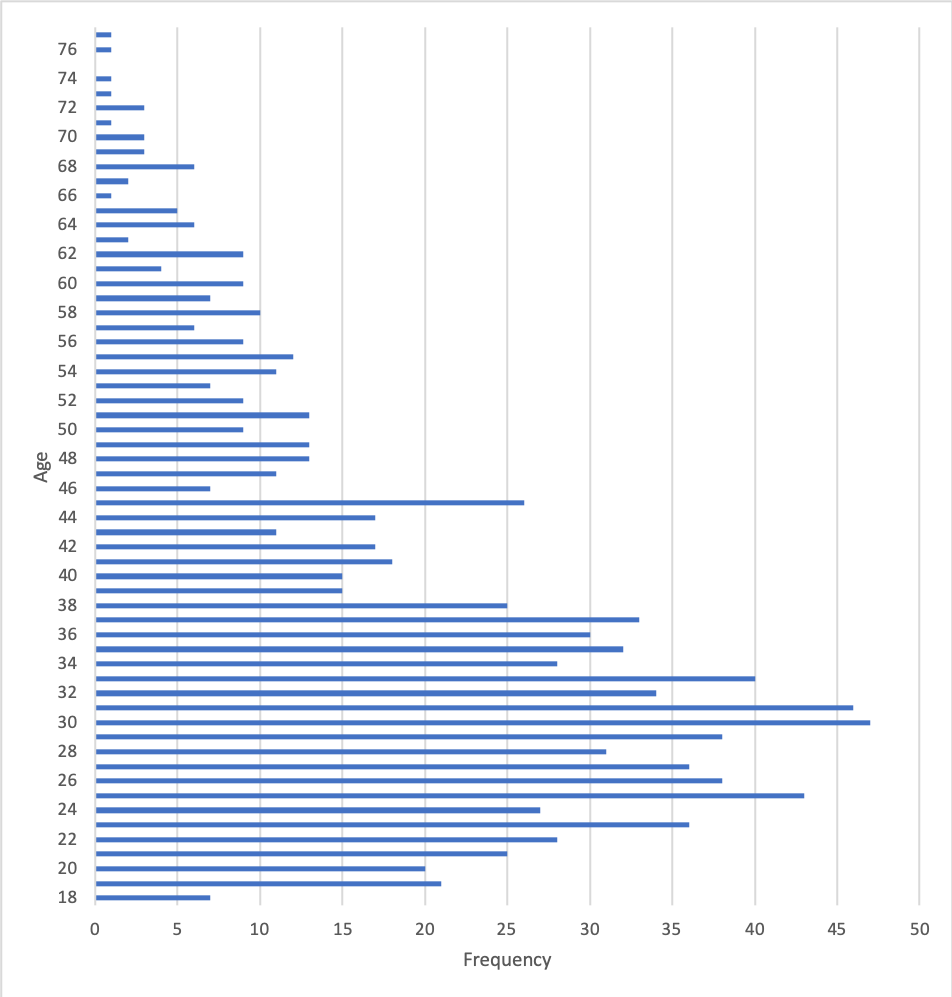
Figure 4. A frequency distribution of our participants' reported ages.
We asked participants, "how old are you?" As is depicted in Figure 4, the respondents included in our analysis were all adults, with an average age of 35.8 years old and a median age of 33 years old. This median age is 5.1 years younger than the 2018 US Census median age of 38.1. One participant did not respond to this question.
Comparing those below the median age to those above the median age did not result reveal differences in the overrepresentation of concepts that would necessitate modifications to the model statements reported herein, nor did these groups express substantial variation in the vocabulary or verbosity of responses.
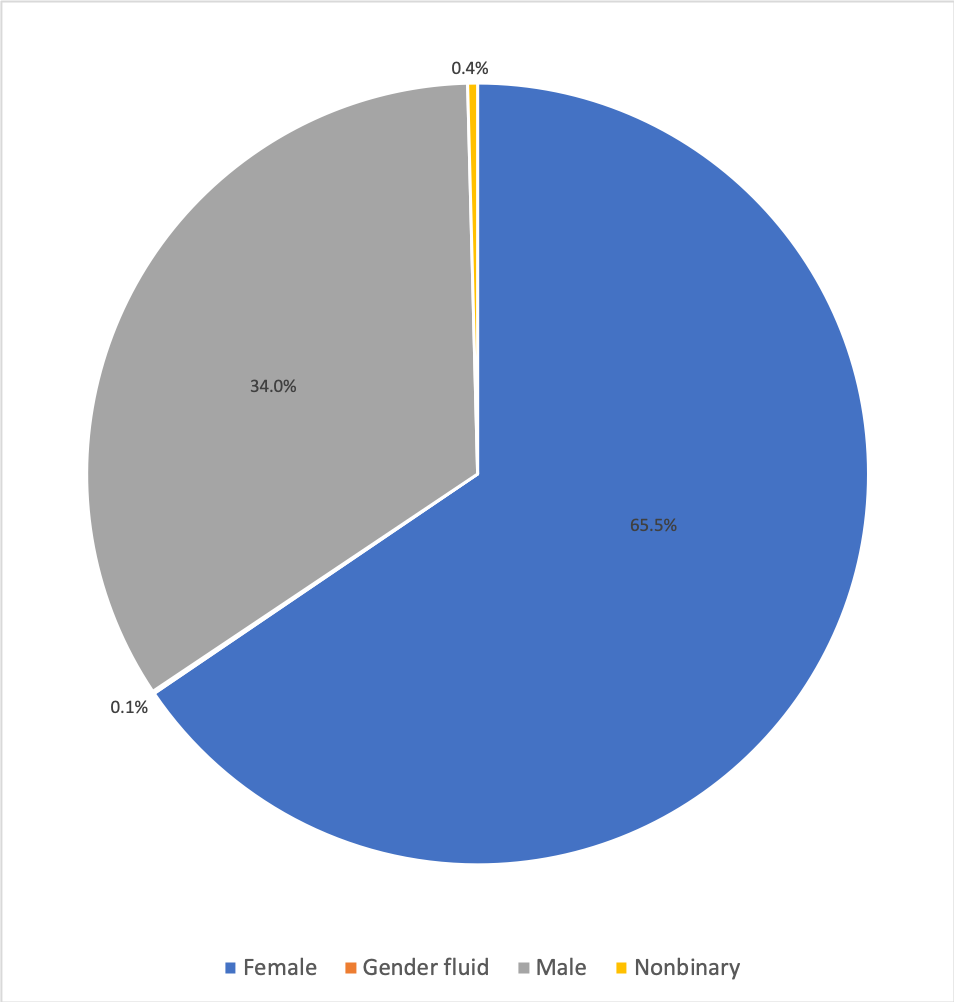
Figure 5. The proportion of responses received by reported gender/sex.
We asked participants, "what is your gender?" The majority of participants responded by stating their biological sex. We therefore utilized these terms as categorical labels, and grouped variants of "Female" and "Male" together. We grouped variant spellings of "Nonbinary," but did not include in this category the single participant who wrote, "Gender Fluid." As depicted in Figure 5, Females were more greatly represented than Males. Further comparison with US Census data indicates that these rates vary significantly from expected proportions in the US population (p<.01). Nonbinary individuals expressed a rate that is approximately equal to US population estimates.
With respect to the question about becoming aware that you were in love, females were more likely than others to use the male pronouns he and his, as well as the word husband, while males were more likely to use the pronouns she and her, and the word wife. Gender/sex did not produce variation in other content for this question, nor did it produce variation in any content in response to the other two open-ended items. Reported gender/sex did not substantially affect measures of verbosity or vocabulary.
Ortgeist
We asked participants, "In what state do you live?" The participants who took part in our study did so online through Amazon's Mechanical Turk. We limited our solicitation to those who were located in the United States of America, and as noted in bold above, requested that participants select the State in which they reside. We grouped States according to US Census Regions, and compared this to 2018 US Census population estimates. Doing so indicates that our sample varies from US population estimates in a significant manner. The West expressed a participation rate that is 5.5% below what would be expected given US Census estimates, and the Northeast expressed a participate rate that exceeds US Census estimates by 3.3%. The Midwest and South expressed participation rates that were within 1% of US Census population estimates. Eleven respondents did not select a state of residence. Figure 6 displays the number of participants reporting residence in each US State.
The regional residence of participants did not appear to substantially influence the content of the model statements in this report, nor did it meaningfully affect the vocabulary or verbosity of the responses.
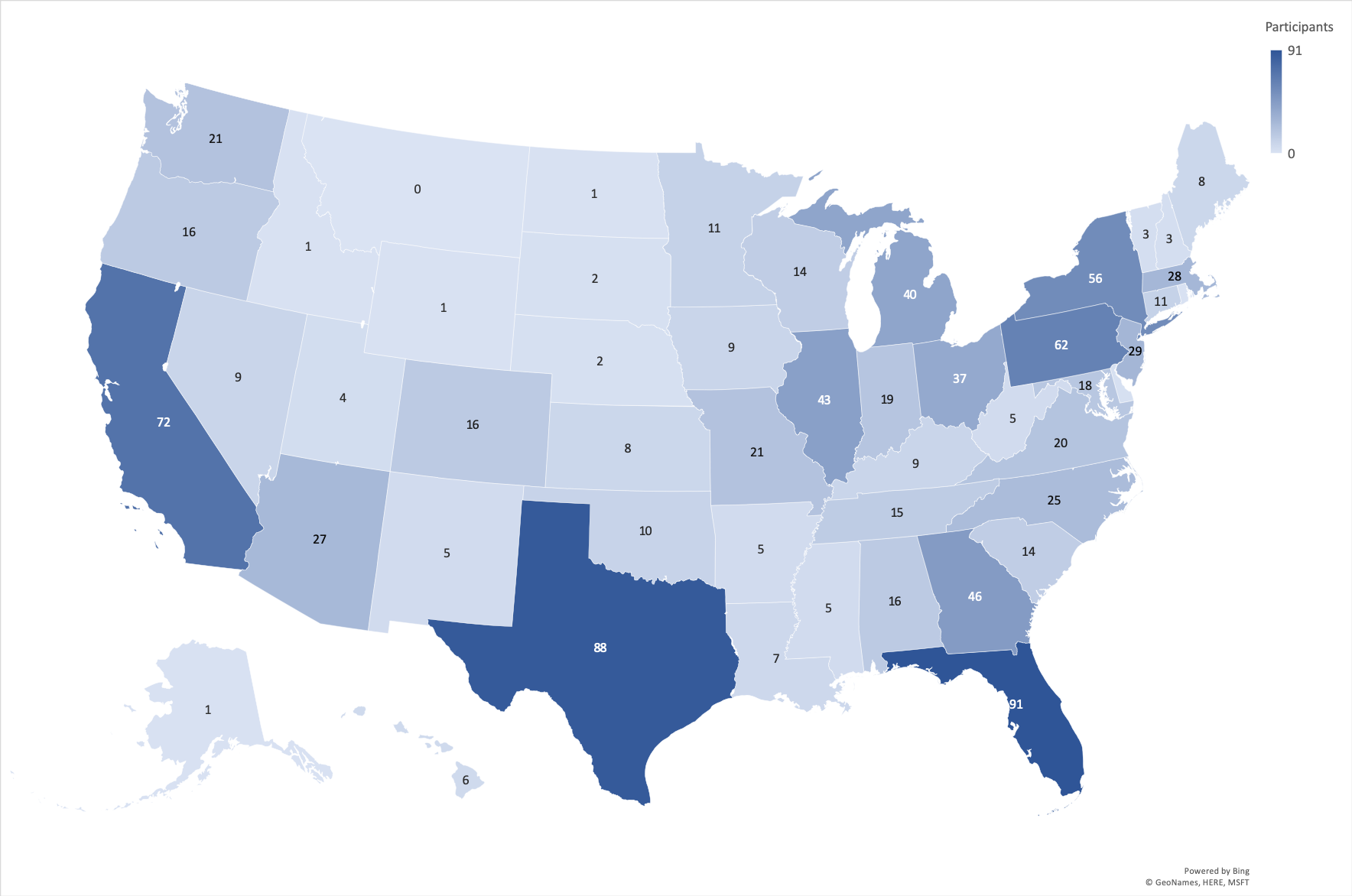
Figure 6. The geographic distribution of responses, according to the number of participants reporting residence in each US State.
Zeitgeist
This survey began on February 6th, 2020 at 3:16 p.m., PST and was continuously available until its conclusion on February 8th, 2020 at 11:49 p.m PST. Mechanical Turk automatically records and reports the time at which each response is submitted. Figure 7 reveals the distribution of completed surveys during the 56.5-hour period that the survey was available.
As with geography, the date of submission did not appear to influence the content or order of the model statements presented in this report, nor did it affect the vocabulary or verbosity of the responses.
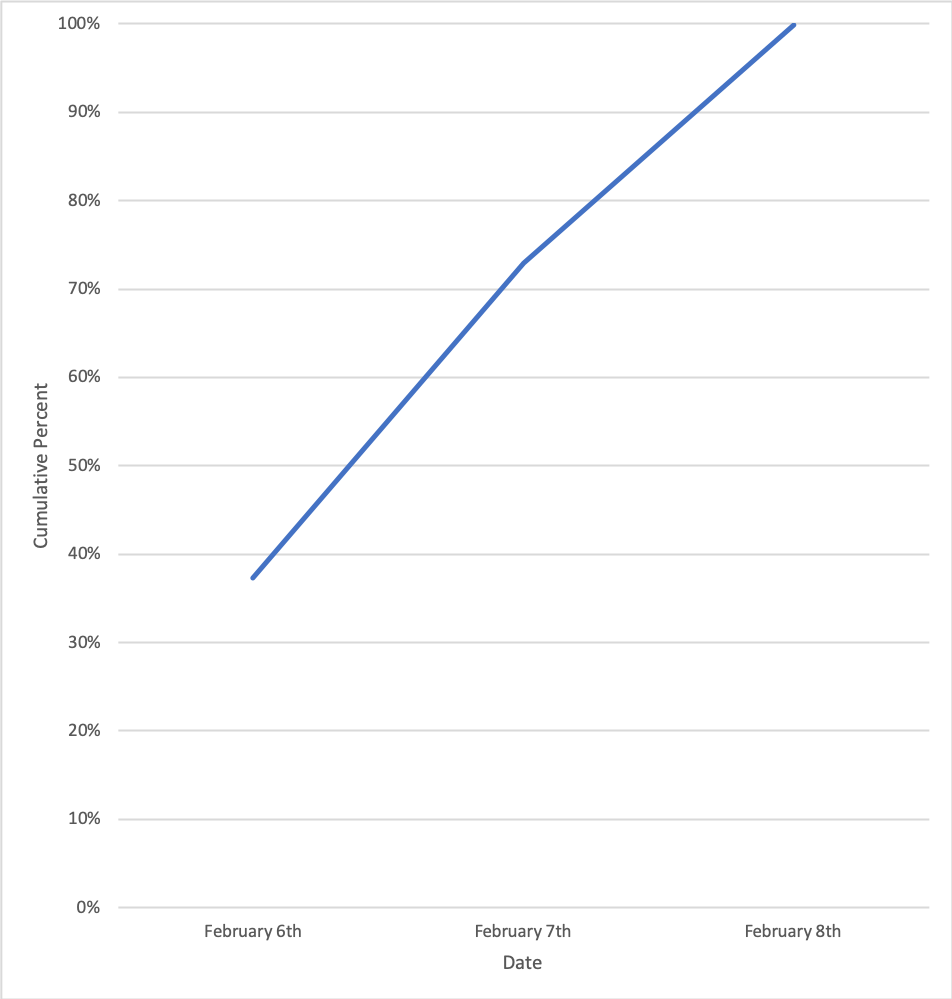
Figure 7. The cumulative percentage of responses received according to the date.
The parts.
The parts of a worldview consist of the major units of meaning in the responses. We asked our participants to respond in their own words to three distinct questions. We therefore partition our meaning units accordingly, resulting in three distinct parts of the worldview:
- A part containing the themes and model statements derived from what being in love means to them,
- A part containing the themes and model statements derived from their description of becoming aware that they were in love, and
- A part containing the themes and model statements derived from their perspectives on how they know when someone is in love with them.
The theme structure.
Themes are structured from word networks, which center on the most frequent and overrepresented non stimulus associated (e.g., love, being, means for the first open-ended item) and non-mood associated (e.g., you, your, and, that, the for the first open-ended item) concepts. To display greater thematic diversity for this demonstration, we exclude each of these concept's synonyms (such as someone and them, with respect to person). These networks are based on the frequency of actual association between words in the original dataset. They graphically display the most frequent ordered relations between concepts as they are expressed in the language of our participants.
Figures 8-10 present three such word networks for the most frequent overrepresented concepts (person, life, and feeling) used by respondents when asked to tell us what being in love means to them. Figures 11-13 present three such word networks for the most frequent overrepresented concepts (when, knew, and felt) used by respondents in their descriptions of becoming aware that they were in love. Finally, figures 14-16 present three such word networks for the most frequent overrepresented concepts (way, tell, and want) used by participants in their responses to how they know when someone is in love with them.
What being in love means.
Becoming aware of being in love.
Know when someone is in love with you.
-
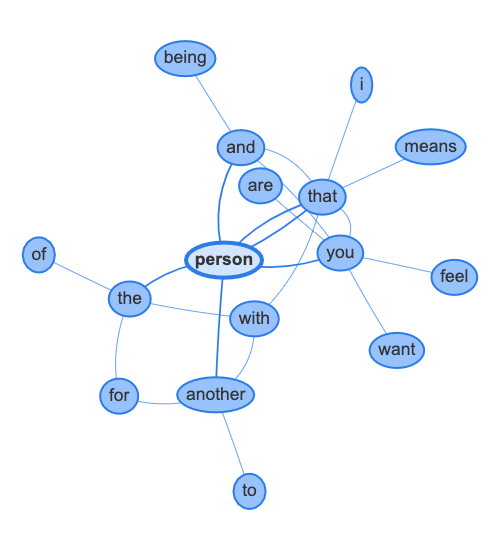
Figure 8. The word network for person.
-
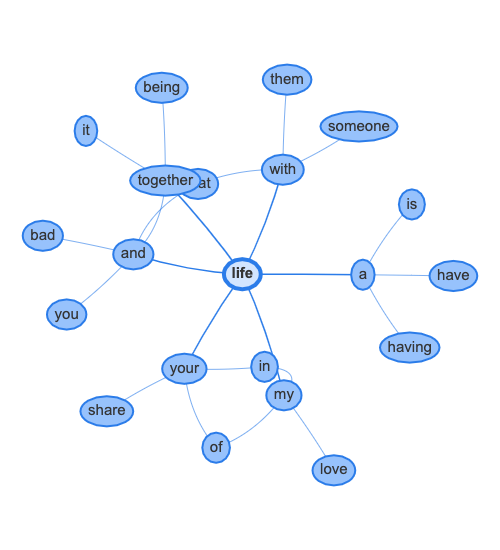
Figure 9. The word network for life.
-
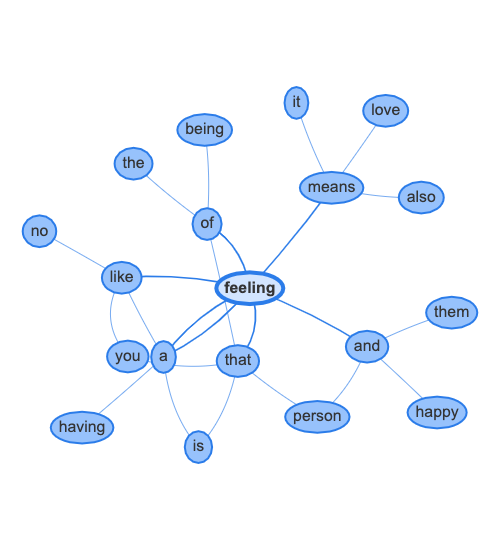
Figure 10. The word network for feeling.
The most frequent and overrepresented word not associated with the mood or question was person. As may be apparent from inspection of the networks presented in Figure 8, the concept person is most frequently immediately preceded by the words that, the, and another. The word that, in turn, is most frequently preceded by the word means, while the words the and another are most frequently preceded by the word for. The word with also precedes all three words: that, the, and another. The word person is most frequently followed immediately by the words: and, you, and that. These words are, in turn, often themselves followed by the words you, are, being, feel, want, and person, among others. From this it can be understood that the word person is being used as a primary referent to answer the question. In other words, the word person generally follows recapitulation of the question stem (e.g., being in love means…) and then is used as the thing around which the qualities of being in love are illuminated (e.g., being, are, feel, want).
Figure 9 reveals the next most overrepresented concept not associated with the stimulus question or mood: life. The word life is most frequently directly preceded by the words: your, my, and a. The most popular words preceding your and my are, in turn: in and of. The most popular words preceding the word a are have, is, and having, while the third most popular word preceding the word your is sharing. Together these words reveal a relational aspect of life, in which something is in, of, had, or shared with life. This relational aspect is further bolstered by examining the most popular words directly following the word life: with, and, and together. All three of these words are relational. By examining the words following in turn after the word with, the words them, and someone are most popular.
Figure 10 reveals another popular referent through which the question is answered: feeling. The most popular words preceding this word are: means, a, and and. Examining the words preceding these words, in turn, reveals the following most popular words: love, it, also, is, feeling, having, person, them, and happy. Feeling is most often immediately followed by the words: of, that, and like. These words, in turn, are followed by: the, being, that, person, you, is, a, and no. Constructing phrases from this network according to their word order produces examples such as: love means feeling like you; it means feeling that person; is a feeling like no; having a feeling of being; happy and feeling that you.
-
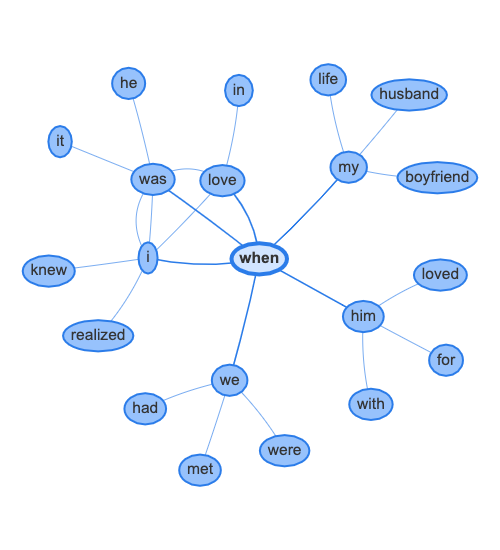
Figure 11. The word network for when.
-
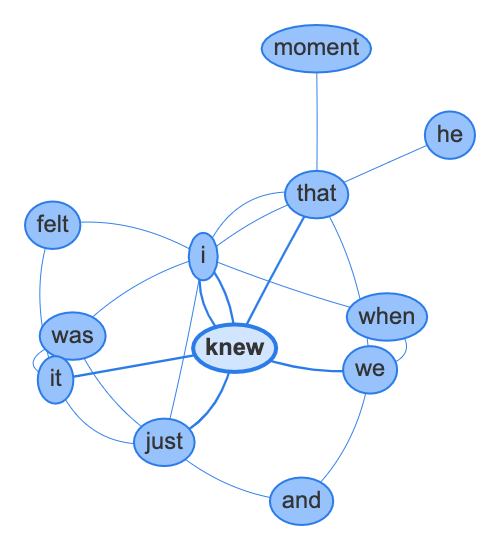
Figure 12. The word network for knew.
-
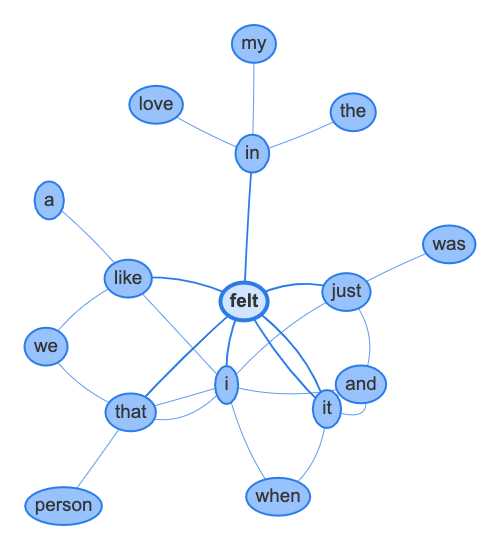
Figure 13. The word network for felt.
The most frequent and overrepresented word not associated with the mood or question was when. Figure 11 depicts the word network centering on this word. By putting the words preceding the word when in this network together according to the most popular order of placement in our participants responses, we arrive at such phrases as: in love when, it was when, with him when. As may be apparent, other phrases can also be constructed, such as: was love when, with him when, loved him when, for him when. Then, by putting the words following the word when in this network together according to the most popular order of placement in our participants responses, we arrive at such phrases as: when I was, when we were, when my husband. Other phrases can also be constructed, such as: when I knew, when I realized, when we had, when we met, when my life, when my boyfriend. Connecting the phrases preceding and following the word have reveal such combined phrases as: in love when I was, was love when we were, it was when we met, loved him when my husband.
The word network depicted in Figure 12 focuses on the word knew. Examining the most popular words preceding this word reveal its connection to the word when: when I knew, when we knew. Other phrases constructed from words preceding the word when include: that I knew, I just knew, and just knew, and we knew, that we knew. Examining the most popular words following the word knew reveal its relationship to the word felt: knew I felt, knew it felt. Other phrases contructed from the words following the word knew include: knew I was, knew that I, knew that he, knew that moment, knew it was, knew it just. Putting the preceding and following phrases together reveals such 5-word phrases as: when I knew I was, when I knew I felt, when I knew that I, that I knew that he, that I knew that moment, I just knew I was, I just knew that I, and just knew it felt, and we knew it was.
As may be apparent in Figure 13, creating phrases from the words surrounding the word felt reveal its connection to the moment or instance in which the participants became aware that they were in love, as well as to the object of that love, either self or other: when I felt like I, when it felt like we, that I felt in my, I just felt that we, I just felt in love, when I felt that person.
-
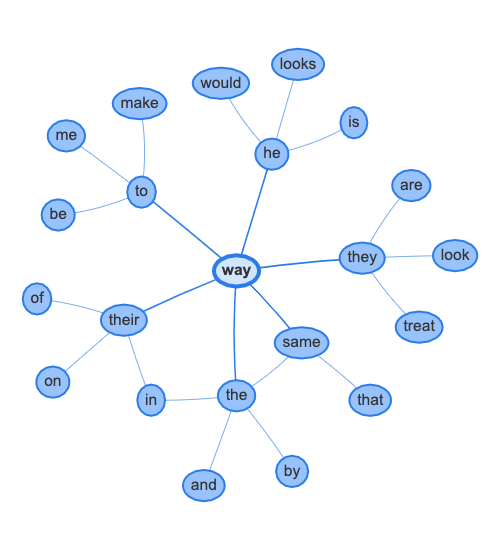
Figure 14. The word network for way.
-
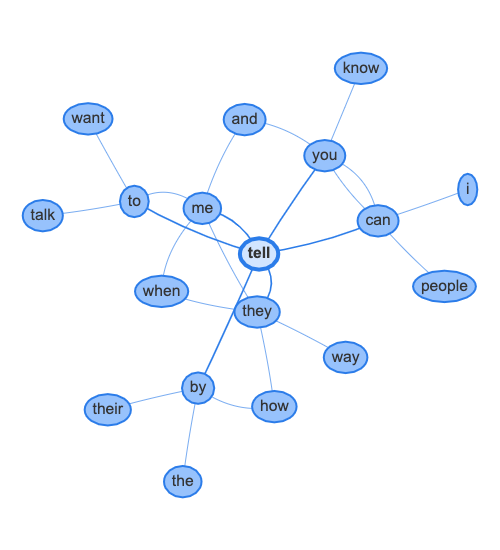
Figure 15. The word network for tell.
-
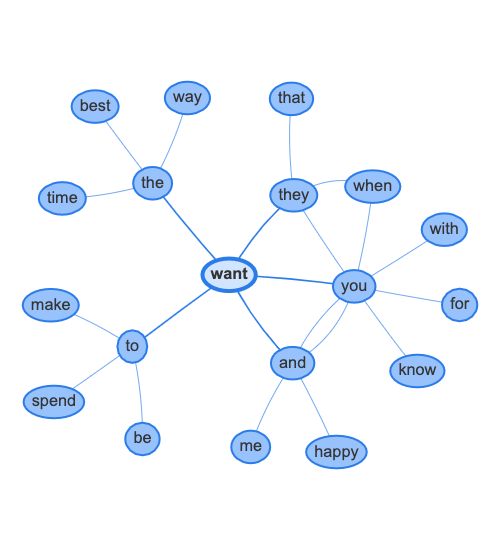
Figure 16. The word network for want.
The most frequent and overrepresented word not associated with the mood or question was way. Figure 14 depicts the word network centering on this word. By putting the words preceding the word way in this network together according to the most popular order of placement in our participants responses, we arrive at the phrases: by the way, in the way, and the way, of their way, in their way, the same way, that same way. Then, by putting the words following the word way in this network together according to the most popular order of placement in our participants responses, we arrive at the phrases: way they look, way they are, way they treat, way to make, way to be, way he is, way he looks, way he would. Connecting the phrases preceding and following the word way reveal the combined phrases (among others): by the way they look, by the way they are, by the way they treat, of their way to make, of their way to be, the same way he looks, the same way he would.
The word network depicted in Figure 15 focuses on the word tell. Examining the most popular words preceding this word reveal such phrases as: you can tell, I can tell, people can tell, when they tell, way they tell, how they tell, want to tell. Examining the most popular words following this word reveal such phrases as: tell you can, tell you and, tell you know, tell me and, tell me they, tell me when, tell by the, tell by how, tell by their. Common 5-word phrases that combine those words frequently preceding and following the word tell include: you can tell by the, I can tell by how, people can tell by their, when they tell me and, way they tell me when, me to tell by how, when they tell by how.
The word network depicted in Figure 16 focuses on the word want. Creating phrases from the most popular words preceding the word want results in: when they want, you they want, that they want, you and want, me and want, happy and want, with you want, for you want, when you want. Constructing phrases from the most popular words following the word want, in turn, results in creating: want to be, want to spend, want to make, want the way, want the time, want the best, want you and, want you know, want you when. Some 5-word phrases created by combining the most popular words preceding and following want include (among others): when they want to be, when they want to spend, when they want to make, when they want the best, when they want you and, you and want to make, happy and want you when, and want the time, when you want to be, when you want to spend,
Elaboration on the themes.
We can further elaborate on the themes so far presented to construct more detailed model statements. Doing so identifies ways that existing concepts connect with other concepts in the dataset. In this demonstration, we present such elaborations how we can do so by expanding the word network surrounding the first non-mood and non-stimulus related concept produced in response to each of our three parts: what being in loves means, becoming aware of being in love, and knowing when someone is in love with you.
Expanding the word networks.
What being in love means.
Becoming aware of being in love.
Know when someone is in love with you.
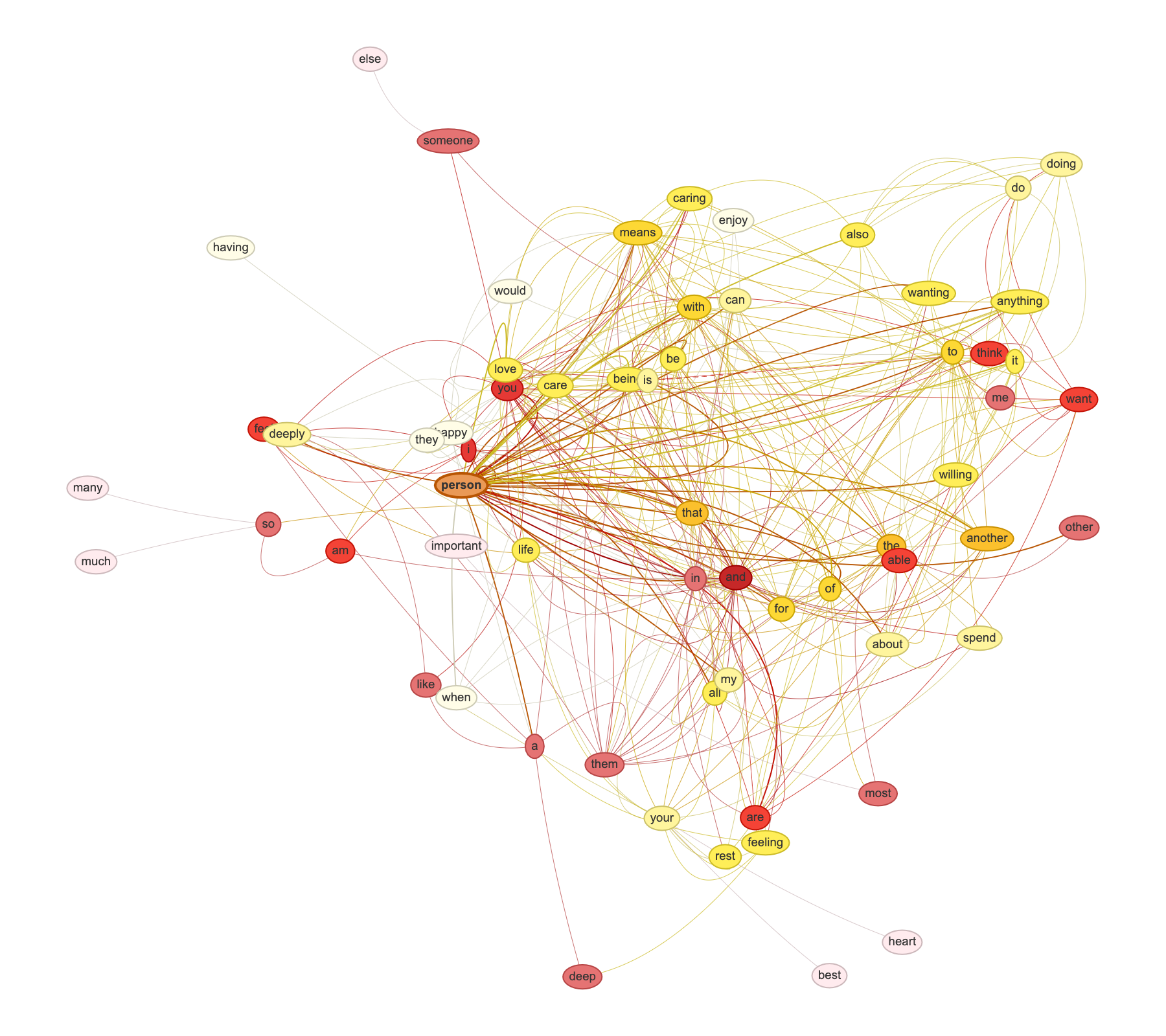
Figure 17. The word network for person.
In the expanded word networks presented in Figure 17, more elaboration becomes visible. In this figure, the target word person is depicted in orange, while the words following it are depicted in lighter shades of red for each word-level away from help they are located. Similarly, the words preceding the target word are depicted in lighter shades of yellow as they are found at an increasing number of words away from that word.
Comparing Figures 8 and 17, those words additionally associated with person become apparent, such as: able, about, am, anything, be, best, can, care, caring, deep, deeply, do, doing, else, enjoy, feel, feeling, happy, having, heart, important, life, like, love, many, most, much, rest, someone, spend, they, think, wanting, when, willing, would.
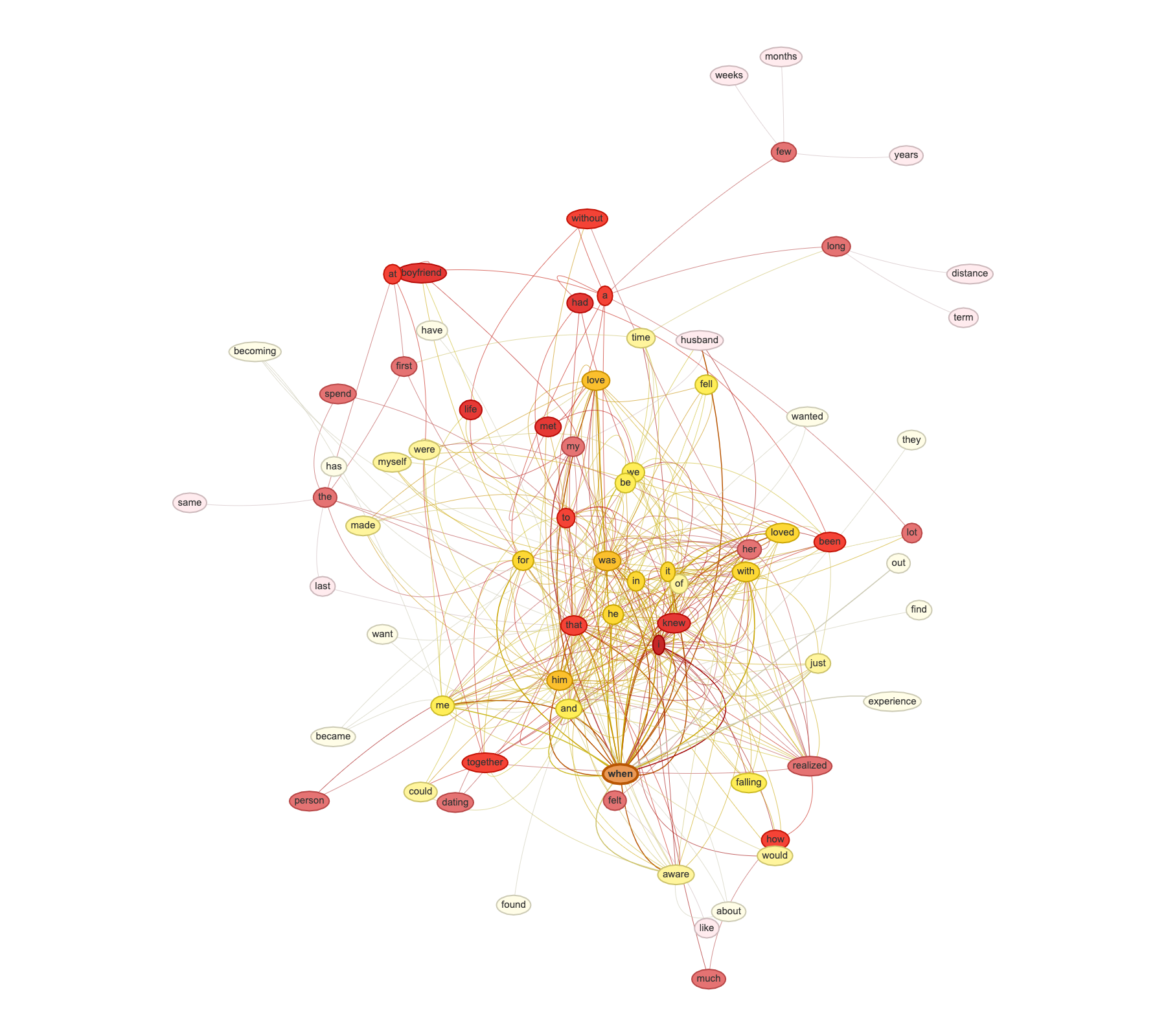
Figure 18. The word network for when.
In the expanded word networks presented in Figure 18, more elaboration becomes visible. In this figure, the target word when is depicted in orange, while the words following it are depicted in lighter shades of red for each word-level away from help they are located. Similarly, the words preceding the target word are depicted in lighter shades of yellow as they are found at an increasing number of words away from that word.
Comparing Figures 11 and 18, those words additionally associated with when become apparent, such as: about, at, aware, be, became, becoming, could, dating, distance, experience, falling, fell, felt, few, find, first, found, had, have, her, how, just, last, like, long, made, me, months, much, myself, person, same, spend, that, they, time, term, together, want, wanted, weeks, without, would, years

Figure 19. The word network for way.
In the expanded word networks presented in Figure 19, more elaboration becomes visible. In this figure, the target word way is depicted in orange, while the words following it are depicted in lighter shades of red for each word-level away from help they are located. Similarly, the words preceding the target word are depicted in lighter shades of yellow as they are found at an increasing number of words away from that word.
Comparing Figures 14 and 19, those words additionally associated with way become apparent, such as: always, amount, at, based, care, check, considerable, day, do, equal, eyes, feel, feelings, give, goes, good, help, I'm, into, just, know, life, light, little, looked, love, loving, much, my, often, other, people, person, saying, smile, someone, somewhere, sure, them, things, time, up, very, want, when, willing, you, your.
These expanded word networks elaborate on the actions, people, places, qualities, and things associated with each of the target words, and facilitate the construction of the foremost model statements listed at the beginning of this worldview for each open-ended question posed to our participants.
Essentializing themes.
As we noted in the section on gender when discussing the viewpoints in our panorama, self-identified females and males varied between their use of pronouns and social roles, most predominately when answering the question about becoming aware that they were in love. Specifically, females were more likely than males to use the pronouns "him," and, "he," and the social roles "husband" in their responses to this question. Similarly, males were more likely than females to use the pronouns "her," and, "she," and the social roles "wife." Such divergence can be examined as to its influence on themes and model statements, by comparing the relationships between these different pronouns, social roles, and other concepts during their actual use by participants. In doing so, those phrases that are convergent or universal can be identified to create an essential form of the theme that spans diversity in self-identified gender.
Females.
-
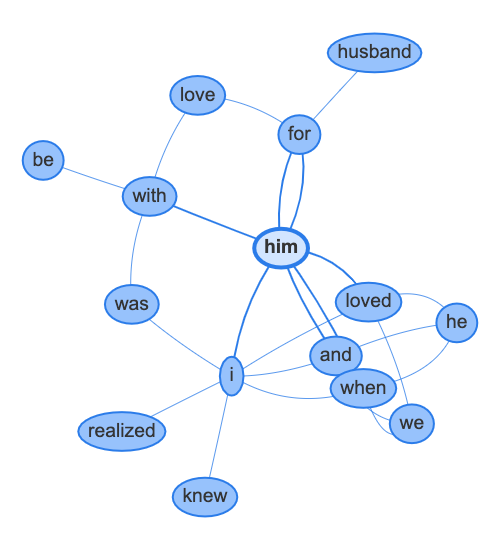
Figure 20. The word network surrounding him.
-
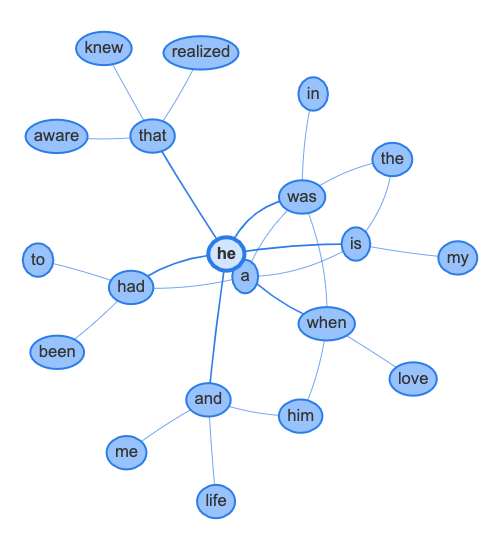
Figure 21. The word network surrounding the word he.
-
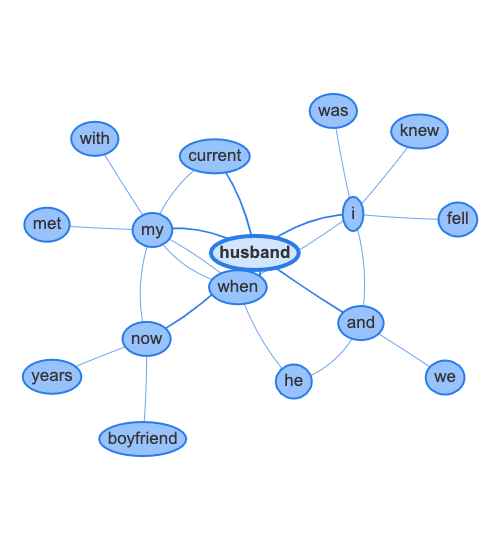
Figure 22. The word network surrounding the word husband.
Males.
-
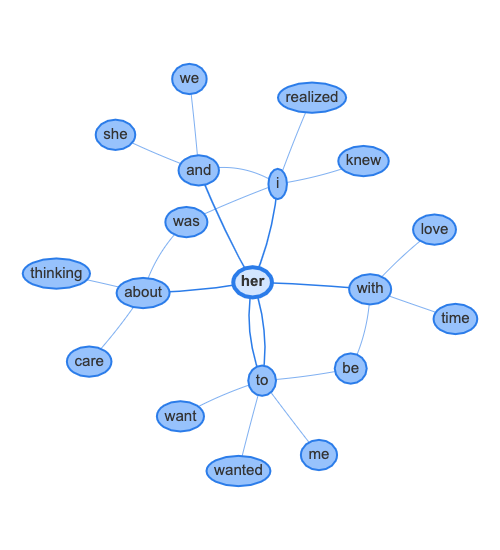
Figure 23. The word network surrounding the word her.
-
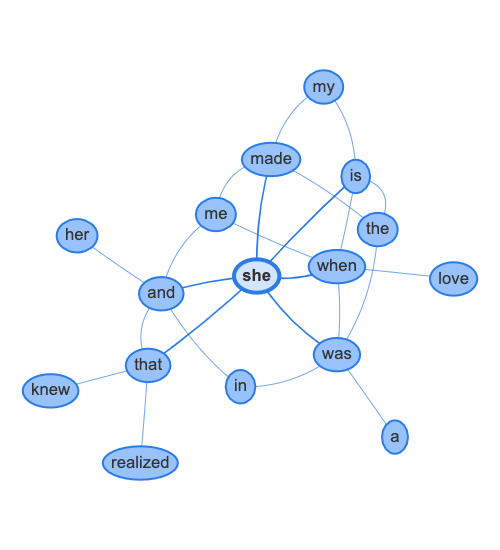
Figure 24. The word network surrounding the word she.
-
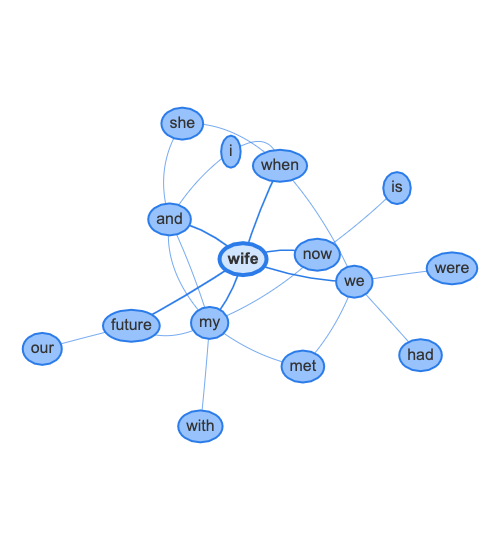
Figure 25. The word network surrounding the word wife.
The word networks for "him" and, "her," are depicted in Figures 20 and 23, respectively. Comparing the words associated with each target word reveals general similarity. Both him and her are most preceded by the phrase "love with" and most followed by the phrases "and I" (or "and she", or "and we"), and "I was" (or, "I knew," or "I realized"), in that unitary order. As long as our model statements follow these orders, then, there is no need to modify their structure based on gender, other than adopting a gender neutral pronoun. If we wanted, on the other hand, to explore diversity across reported genders, then we could also include statements constructed based on the non-shared words that appear (such as by including the phrase "love for," before the word, "him," among females-specific model statements, or "thinking about," or "care about", before the word, "her," in male-specific model statements).
Figures 21 and 24 depict the word networks for "he" and, "she," respectively. Comparing the words associated with each target word again reveals general similarity between the words associated with these pronouns. Both he and she are most preceded by the phrase "me and" and most followed by the phrases "was in" (or "was the", or "was a"). Both he and she are also both secondarily preceded by the phrase, "love when." As with "her," and, "him," long as our model statements include these phrases, there is no need to modify their structure based on gender, other than adopting a gender neutral pronoun. If diversity in model statements is desired, it could be represented by including somewhat less popular statements constructed based on the non-shared words that appear (such as by including the phrase "him when," before the word, "he," among females-specific model statements, or "is the," after the word, "she," in male-specific model statements).
Finally, figures 22 and 25 depict the word networks for "husband" and, "wife," respectively. As with the two previous examples, comparing the words associated with each target word again reveals a general similarity in the most popular words used with these social roles. Both husband and wife are most preceded by the phrase "with my" and most followed by the phrases "and I." Both husband and wife are directly preceded by the word now, and both are directly followed by the word when. As with the two previously discussed pronouns, as long as our model statements include these phrases, there is no need to modify their structure based on gender (other than perhaps adopting a gender neutral social role, such as, "partner," which is found more frequently in our responses than, "spouse"). Gender diversity in model statements could be represented by including somewhat less popular statements constructed based on the non-shared words that appear in these networks.
The interpretation.
Given the foremost model statements, panorama, and mood of the natural language analyzed in this survey, we find its contents to consist primarily of informal self-reflective and other evaluative descriptions of experiences related to being in love, becoming aware of being in love, and how participants come to know when someone else is in love with them. Being in love involves caring about another person, sharing your life with them, and feeling like you want to spend all of your time with them. Becoming aware of being in love primarily involves self-reflective thought (knowing) and feeling, and appears to be a somewhat spontaneous realization about a person with whom one typically dating or in a friendship. Knowing when someone else is in love with you primarily involves evaluating the actions, verbalizations, and desires of another person, and is often concerned with the manner in which they appraise you, direct communication of love for you, or desiring to be in your presence as much as possible.
The questions on being in love and knowing when someone is in love with you produced tendencies to recite a portion of the question itself when participants began their responses. However, the item asking asking participants to describe their last experience becoming aware that they were in love did not tend to do this as frequently—though some indeed did recite a portion of the item in response, it was not as popular of a tendency as found in the two questions. This could be the result of differences in wording: the two questions began with, "tell us," while the item on becoming aware of being in love began with "describe." It could also be an artifact of the the way the items were structured: the items on being in love and knowing when someone is in love with you were caste as questions, while the item asking participants to describe their last experience becoming aware that they were in love was not.
The phrasing in our foremost model statements do not vary in their content across the people, places, and time involved in our survey. Even though there is proportional disparity in female and male participation, because our model statements employ the most popular use of dually-gendered pronouns and social roles, and the phrasing surrounding these pronouns and social roles is functionally equivalent, such disproportionality does not therefore matter to the results reported herein. We can, therefore, generalize these foremost model statements to Americans similar to those participating in our survey.
The horizon.
Our results are bounded by the people, places, and time in which they were produced. For example, our participants were drawn from Amazon Mechanical Turk workers located in the United States. As such, they may have certain characteristics or experiences that vary from that expressed by the typical person in this nation. These characteristics or experiences may, in turn, systematically relate to variation in thoughts about a given topic.
However, there is an increasing tendency among American researchers in the social sciences to utilize Mechanical Turk workers to complete surveys intended for generalization to the U.S. population. Current studies comparing the demographics of Mechanical Turk workers to the background US population indicate that they may be somewhat younger, more educated, less racially diverse, and less affluent than the general US population.
We utilized a high threshold for creating a model statement around a concept in our report. In order for a model statement to be created around a given concept, that concept must have been expressed at a rate that exceeded 15 times its typical rate of use in everyday English3. This cut-off threshold of 15 makes it such that our confidence estimate for our results exceeds the total possible population of available Mechanical Turk workers in the United States at any given time4.
We are, therefore, quite confident that our results can be generally applied to this population, at least at this point in history. Generalization beyond Mechanical Turk workers to Americans at-large would then depend on whether or not the aforementioned differences between in affluence, age, education, and race influence the foremost model statements produced by this survey. Given: (a) the current research on variation in perspectives on love; (b) that we found no need to vary the content of the foremost model statements based on age, gender, location, or time of submission; and (c) that we utilized such a high cut-off threshold to construct a model statement around a given concept, we believe that our model statements can be applied to the general population in the United States at this point in history.
The worldview.
In your own words, please…

tell us, what does being in love mean to you?
Foremost model statements.
Being in love means that person and you care deeply for each other.
Being in love means that you want to share your life with someone.
Being in love means feeling like you want to be with them all the time.

describe your last experience of becoming aware that you were in love.
Foremost model statements.
I knew I was in love when I was dating, and met my (current) husband/wife.
I realized I was in love when I felt like I wanted to be together with him/her all the time.
I fell in love with my boyfriend/girlfriend when we were talking (on the phone).

tell us, how do you know when someone is in love with you?
Foremost model statements.
You know when someone is in love with you by the way they look at you.
You know when someone is in love with you when they tell you.
You know when someone is in love with you when they want to be with you all the time.
The panorama.
Revealing the worldview's panorama involves understanding the general content and form of the natural language data acquired in response to our free response item. To do this, we first identify the gists, or individual word forms that are relatively overrepresented in them3. We then consider the overall style of the response set through measures of its vocabulary and verbosity. These gists and this style information then give us a sense of the whole—or as we call it, the panorama—presented by the worldview.
-
In your own words, please tell us what does being in love mean to you?
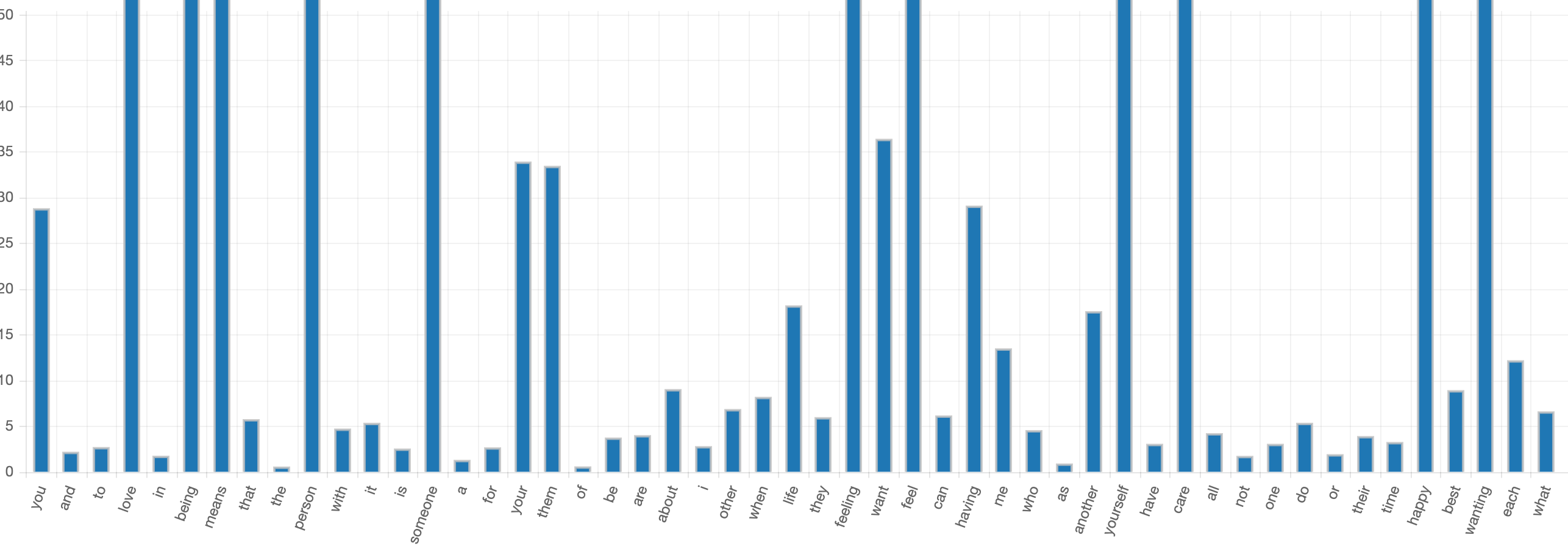
Figure 1. The fifty most frequent words in response to the item: In your own words, please tell us what does being in love mean to you? The vertical axis represents the number of times that a word is found to be relatively overrepresented in the response set.
As visualized in Figure 1, in addition to words related to the question (such as love, in, being, and means), concepts such as you, person, someone, your, them, life, feeling, want, feel, having, another, yourself, care, happy, and wanting are central to the messages of our respondents. The readability and grade-level scores indicate a simple sentence structure and low-average vocabulary, while the average response consists of just under 11 words over the course of 2-3 sentences, which indicates predominantly short sentences. Table 1 displays these measures of verbosity and vocabulary.
Measure
Score
Flesch Readability
73.31
Flesch-Kincaid Grade Level
6.56
Average Cell Word Count
10.83
Table 1. Measures of vocabulary and verbosity for responses to the item: In your own words, please tell us what does being in love mean to you?
-
In your own words, please describe your last experience of becoming aware that you were in love.
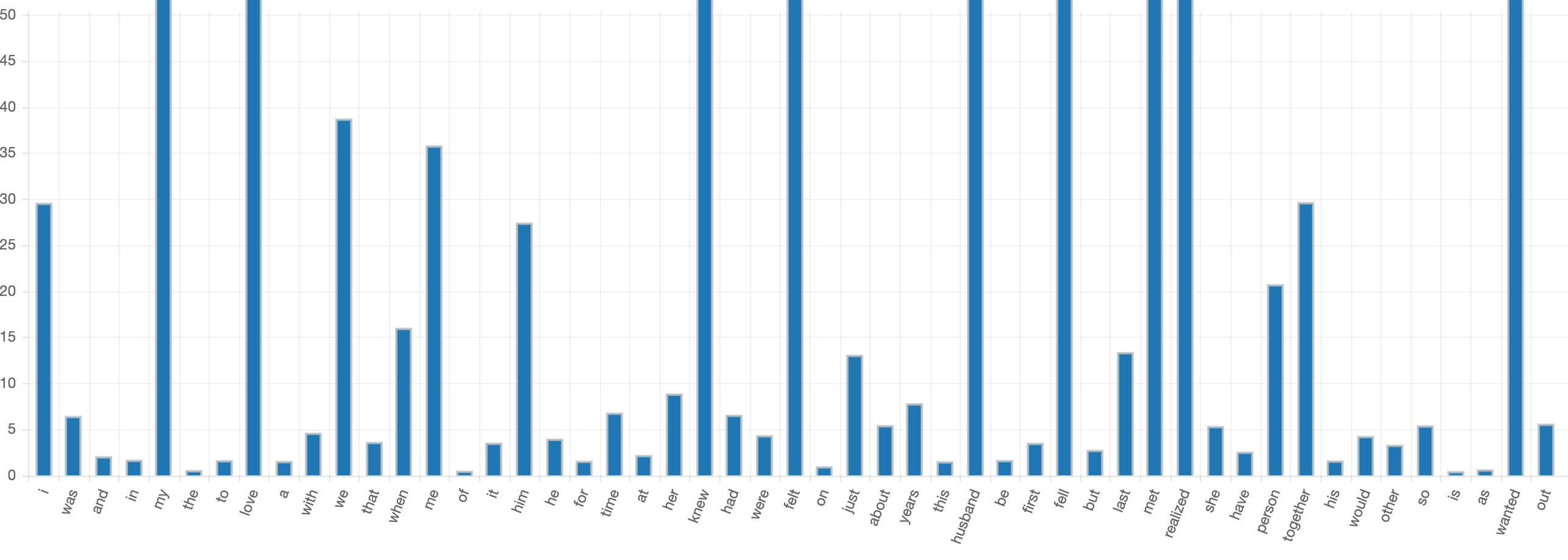
Figure 2. The fifty most frequent words in response to the item: In your own words, please describe your last experience of becoming aware that you were in love. The vertical axis represents the number of times that a word is found to be relatively overrepresented in the response set.
As visualized in Figure 2, in addition to words related to the question (such as I and love), concepts such as my, we, when, me, him, knew, felt, husband, fell, met, person, together, and wanted are central to the messages of our respondents. Similar to the responses to the item on being in love, the readability and grade-level scores for people's responses about becoming aware that they were in love indicate a simple sentence structure and low-average vocabulary. The responses to this item were a bit longer, with the average response to this item consisting of about 14 words over 2-3 sentences. Table 2 displays these measures of verbosity and vocabulary.
Measure
Score
Flesch Readability
79.59
Flesch-Kincaid Grade Level
6.13
Average Cell Word Count
14.43
Table 2. Measures of vocabulary and verbosity for responses to the item: In your own words, please describe your last experience of becoming aware that you were in love.
-
In your own words, please tell us, how do you know when someone is in love with you?
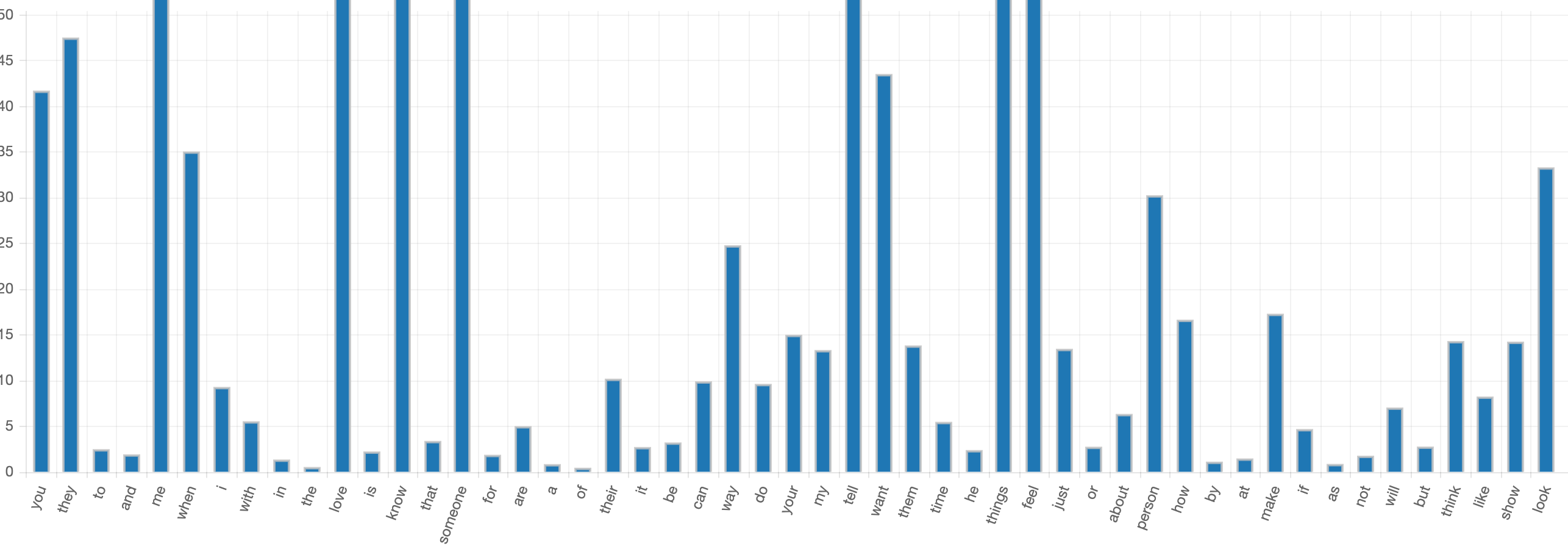
Figure 3. The fifty most frequent words in response to the item: In your own words, please tell us, how to do you know when someone is in love with you? The vertical axis represents the number of times that a word is found to be relatively overrepresented in the response set.
As visualized in Figure 3, in addition to words related to the question (such as you, when, love, know, and someone), concepts such as they, me, way, tell, want, things, feel, person, how, make, and look are central to the messages of our respondents. Similar to the responses to the first two items, the readability and grade-level scores for this item also indicate a simple sentence structure and low-average vocabulary. The responses to this item were shorter than the responses to the previous two items, with the average response to this item consisting of just over 9 words across 2-3 sentences. Table 2 displays these measures of verbosity and vocabulary.
Measure
Score
Flesch Readability
84.68
Flesch-Kincaid Grade Level
5.03
Average Cell Word Count
9.48
Table 3. Measures of vocabulary and verbosity for responses to the item: In your own words, please tell us, how to do you know when someone is in love with you?
The mood.
The foremost ranked few words of any dataset utilizing quantitative phenomenology reveal the general mood of that dataset. A mood comprises the general way in which a topic or event is approached or considered, i.e., whether it is self-reflective, object-oriented, or other-oriented. We discuss the mood for each of the three items separately, because they each display somewhat different moods.
What being in love means.
The primary aspect of mood in the item asking respondents what being in love means is other-oriented, as revealed by the words, "you," and "your." This indicates that the content is primarily oriented toward others. Since it is in the second-person, it could perhaps reflect a response to the questioner. The secondary aspect of mood for this item is relationally object-oriented and present-tense, as revealed by the words "and," "to," "that," "the," "with," "it," "is," "a," and "for," among others. That is, the language produced in response to this item is secondarily about objects, generally in the present tense. Prepositions such as "and," "to," "with," and, "for," are generally used to describe an object in relation to another object or person, and are therefore relational. The words, "is," and "are" reveal the present-tense A somewhat weakly present third aspect of mood for this item is self-reflective, as revealed by the words, "I," and "me."
Becoming aware of being in love.
The primary aspect of mood in the item asking respondents about when they became aware of being in love is self-reflective, as revealed by the words, "I," "my," "we," and "me." This indicates that the content is primarily about the self and its possessions in the past. The individual sense of self is most predominate in this item, but the collective self is also present (via "we"). The secondary aspect of mood for this item is relationally object-oriented and past-tense, as revealed by the words "was," "and," "in," "the," "to," "a," "with," and "that," among others. That is, the language produced in response to this item is secondarily about objects, generally in the past tense. Prepositions such as "and," "in," "to," and, "with," are generally used to describe an object in relation to another object or person, and are therefore relational. The words, "was," "had," and "were" reveal the past-tense. The third aspect of mood for this item is, other-oriented, as revealed by the words, "him," "he," and "her," among others. In addition to self-reflection and object evaluation, other people are also involved in the experience of becoming aware that one is in love.
Know when someone is in love with you.
The primary aspect of mood in the item asking respondents how you know when someone is in love with you is other-oriented, as revealed by the words, "you," "they," and "their." This indicates that the content is primarily other evaluative, although the use of both send-person and third-person pronouns indicates two different others being considered. The secondary aspect of mood for this item is relationally object-oriented and present tense, as revealed by the words "to," "and," "with," "in," "the," "is," that, and "for," among others. That is, the language produced in response to the this item is secondarily about objects in relation to each other. Prepositions such as "to," "and," "with," "in," and, "for," are generally used to describe an object in relation to another object or person, and are therefore relational. The word, "is," reveals the present-tense. The third aspect of mood for this item, is self-reflective, as revealed by the words, "me," "I," and "my." These words reveal that in addition to evaluations of the other person and objects, self-reflection is also involved in knowing when another person is in love with you,
While all three items invoke reflection on the self, other people, and environmental objects, their order of emphasis differs. The questions on what it means to be in love and how you know when someone is in love with you are both primarily other evaluative, while the question about becoming aware of being in love is primarily object-oriented. The tense used for the three questions varies in the same manner, with the item on becoming aware of being in love being about the past, and the other two items being present-tense. When combined with the low-average grade-level and reading ability scores and the relatively short average words-per-sentence in our responses, we conclude that response content is informally written and relatively concrete reflection about current and past experiences with other people.
The viewpoints.
Worldviews are determined by the people, places, and times that co-create them. Therefore, in order to more fully understand the worldview on the questions about love presented in this survey, we highlight those aspects that contextualize and influence our findings. We call these contextualizing and influencing aspects viewpoints. We consider these viewpoints according to their origin in human factors (kuturgeist), spatial or environmental factors (ortgeist), or time-based factors (zeitgeist).
Kulturgeist
Our participants were recruited from Amazon Mechanical Turk, and were paid $0.15 for completing our 6-question survey. A total of 1,041 responses were received. After eliminating non-compliant responses5, 980 were deemed eligible for inclusion.
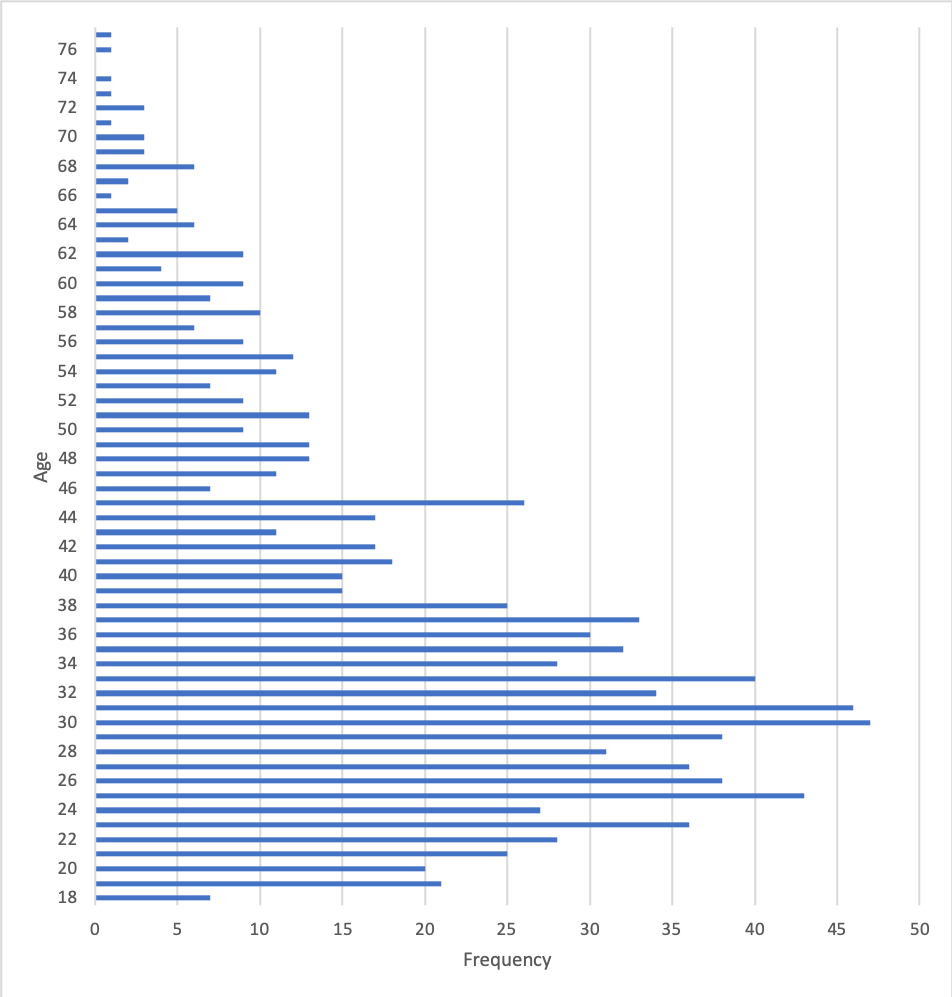
Figure 4. A frequency distribution of our participants' reported ages.
We asked participants, "how old are you?" As is depicted in Figure 4, the respondents included in our analysis were all adults, with an average age of 35.8 years old and a median age of 33 years old. This median age is 5.1 years younger than the 2018 US Census median age of 38.1. One participant did not respond to this question.
Comparing those below the median age to those above the median age did not result reveal differences in the overrepresentation of concepts that would necessitate modifications to the model statements reported herein, nor did these groups express substantial variation in the vocabulary or verbosity of responses.

Figure 5. The proportion of responses received by reported gender/sex.
We asked participants, "what is your gender?" The majority of participants responded by stating their biological sex. We therefore utilized these terms as categorical labels, and grouped variants of "Female" and "Male" together. We grouped variant spellings of "Nonbinary," but did not include in this category the single participant who wrote, "Gender Fluid." As depicted in Figure 5, Females were more greatly represented than Males. Further comparison with US Census data indicates that these rates vary significantly from expected proportions in the US population (p<.01). Nonbinary individuals expressed a rate that is approximately equal to US population estimates.
With respect to the question about becoming aware that you were in love, females were more likely than others to use the male pronouns he and his, as well as the word husband, while males were more likely to use the pronouns she and her, and the word wife. Gender/sex did not produce variation in other content for this question, nor did it produce variation in any content in response to the other two open-ended items. Reported gender/sex did not substantially affect measures of verbosity or vocabulary.
Ortgeist
We asked participants, "In what state do you live?" The participants who took part in our study did so online through Amazon's Mechanical Turk. We limited our solicitation to those who were located in the United States of America, and as noted in bold above, requested that participants select the State in which they reside. We grouped States according to US Census Regions, and compared this to 2018 US Census population estimates. Doing so indicates that our sample varies from US population estimates in a significant manner. The West expressed a participation rate that is 5.5% below what would be expected given US Census estimates, and the Northeast expressed a participate rate that exceeds US Census estimates by 3.3%. The Midwest and South expressed participation rates that were within 1% of US Census population estimates. Eleven respondents did not select a state of residence. Figure 6 displays the number of participants reporting residence in each US State.
The regional residence of participants did not appear to substantially influence the content of the model statements in this report, nor did it meaningfully affect the vocabulary or verbosity of the responses.
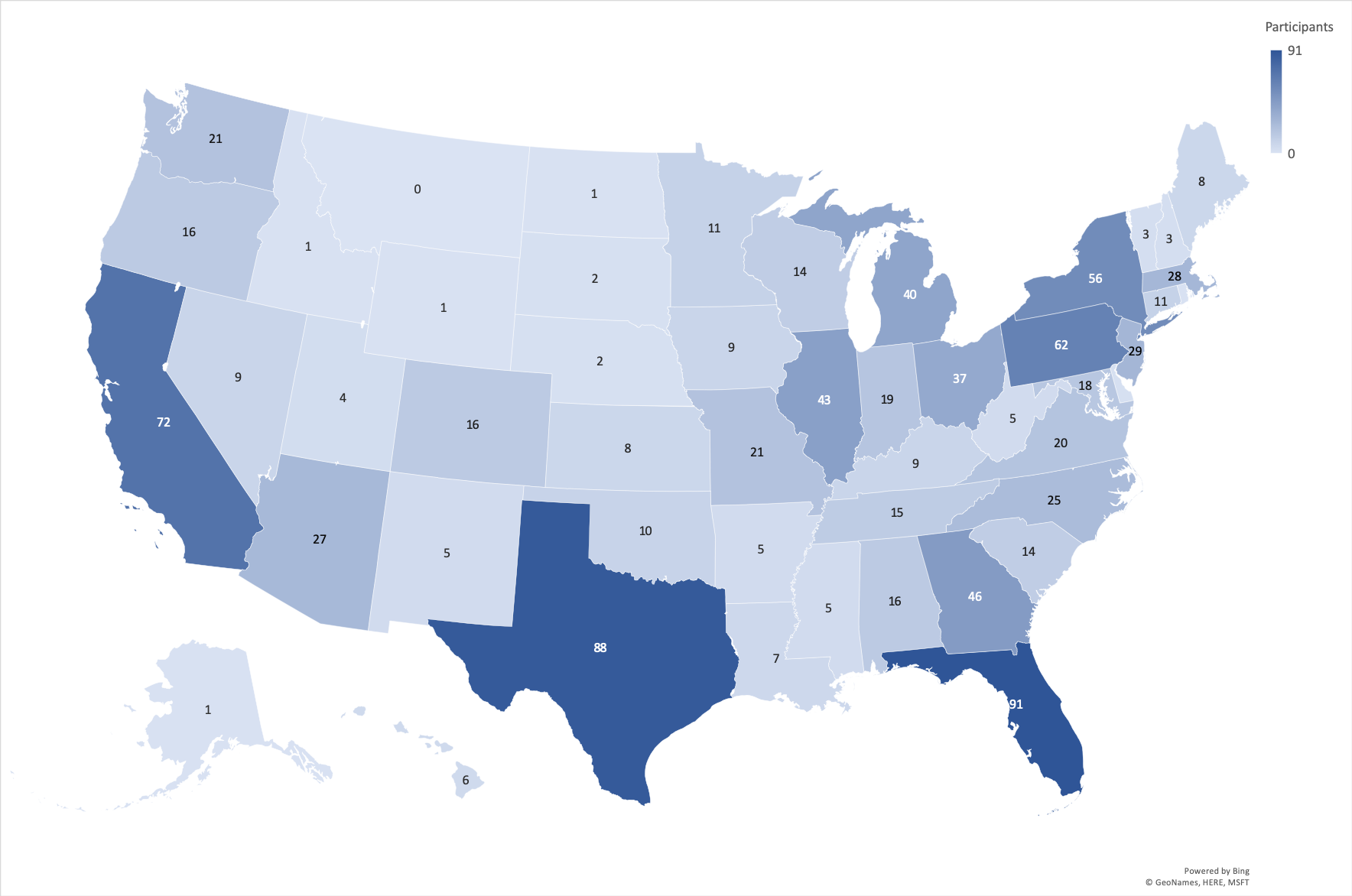
Figure 6. The geographic distribution of responses, according to the number of participants reporting residence in each US State.
Zeitgeist
This survey began on February 6th, 2020 at 3:16 p.m., PST and was continuously available until its conclusion on February 8th, 2020 at 11:49 p.m PST. Mechanical Turk automatically records and reports the time at which each response is submitted. Figure 7 reveals the distribution of completed surveys during the 56.5-hour period that the survey was available.
As with geography, the date of submission did not appear to influence the content or order of the model statements presented in this report, nor did it affect the vocabulary or verbosity of the responses.
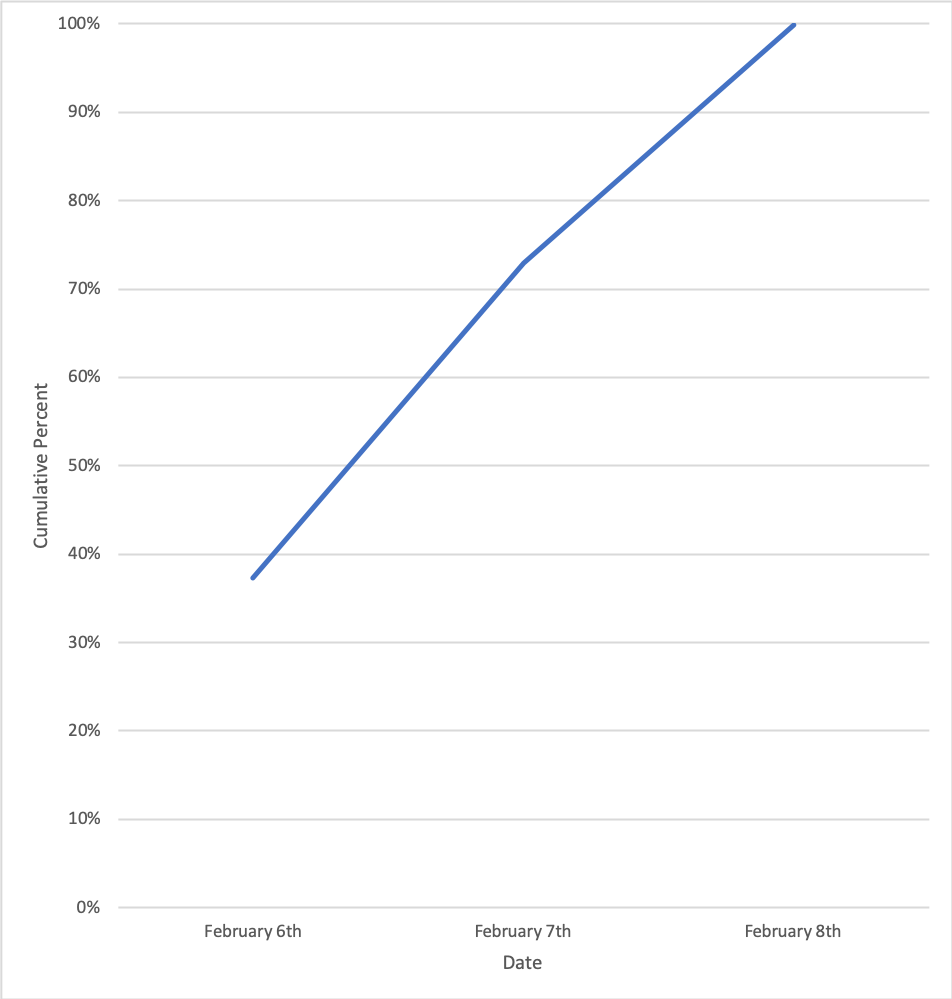
Figure 7. The cumulative percentage of responses received according to the date.
The parts.
The parts of a worldview consist of the major units of meaning in the responses. We asked our participants to respond in their own words to three distinct questions. We therefore partition our meaning units accordingly, resulting in three distinct parts of the worldview:
- A part containing the themes and model statements derived from what being in love means to them,
- A part containing the themes and model statements derived from their description of becoming aware that they were in love, and
- A part containing the themes and model statements derived from their perspectives on how they know when someone is in love with them.
The theme structure.
Themes are structured from word networks, which center on the most frequent and overrepresented non stimulus associated (e.g., love, being, means for the first open-ended item) and non-mood associated (e.g., you, your, and, that, the for the first open-ended item) concepts. To display greater thematic diversity for this demonstration, we exclude each of these concept's synonyms (such as someone and them, with respect to person). These networks are based on the frequency of actual association between words in the original dataset. They graphically display the most frequent ordered relations between concepts as they are expressed in the language of our participants.
Figures 8-10 present three such word networks for the most frequent overrepresented concepts (person, life, and feeling) used by respondents when asked to tell us what being in love means to them. Figures 11-13 present three such word networks for the most frequent overrepresented concepts (when, knew, and felt) used by respondents in their descriptions of becoming aware that they were in love. Finally, figures 14-16 present three such word networks for the most frequent overrepresented concepts (way, tell, and want) used by participants in their responses to how they know when someone is in love with them.
What being in love means.
-
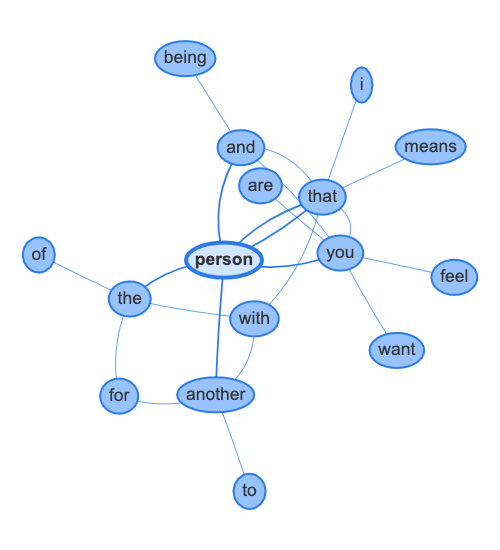
Figure 8. The word network for person.
-
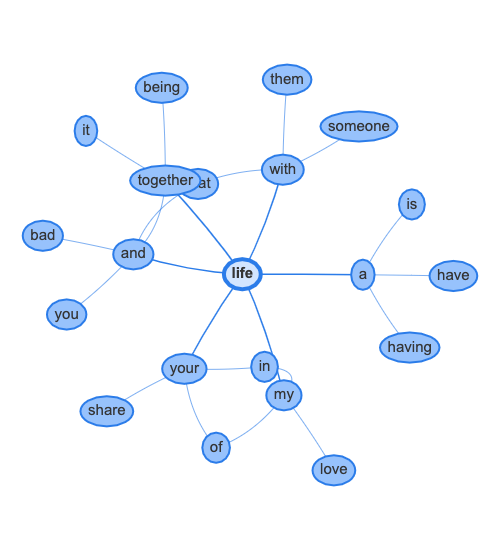
Figure 9. The word network for life.
-
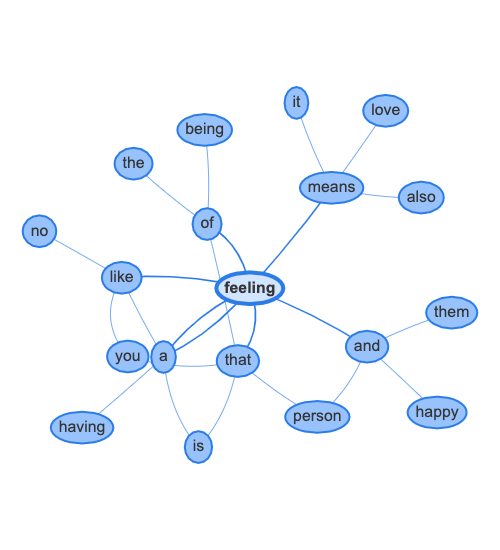
Figure 10. The word network for feeling.
The most frequent and overrepresented word not associated with the mood or question was person. As may be apparent from inspection of the networks presented in Figure 8, the concept person is most frequently immediately preceded by the words that, the, and another. The word that, in turn, is most frequently preceded by the word means, while the words the and another are most frequently preceded by the word for. The word with also precedes all three words: that, the, and another. The word person is most frequently followed immediately by the words: and, you, and that. These words are, in turn, often themselves followed by the words you, are, being, feel, want, and person, among others. From this it can be understood that the word person is being used as a primary referent to answer the question. In other words, the word person generally follows recapitulation of the question stem (e.g., being in love means…) and then is used as the thing around which the qualities of being in love are illuminated (e.g., being, are, feel, want).
Figure 9 reveals the next most overrepresented concept not associated with the stimulus question or mood: life. The word life is most frequently directly preceded by the words: your, my, and a. The most popular words preceding your and my are, in turn: in and of. The most popular words preceding the word a are have, is, and having, while the third most popular word preceding the word your is sharing. Together these words reveal a relational aspect of life, in which something is in, of, had, or shared with life. This relational aspect is further bolstered by examining the most popular words directly following the word life: with, and, and together. All three of these words are relational. By examining the words following in turn after the word with, the words them, and someone are most popular.
Figure 10 reveals another popular referent through which the question is answered: feeling. The most popular words preceding this word are: means, a, and and. Examining the words preceding these words, in turn, reveals the following most popular words: love, it, also, is, feeling, having, person, them, and happy. Feeling is most often immediately followed by the words: of, that, and like. These words, in turn, are followed by: the, being, that, person, you, is, a, and no. Constructing phrases from this network according to their word order produces examples such as: love means feeling like you; it means feeling that person; is a feeling like no; having a feeling of being; happy and feeling that you.
Becoming aware of being in love.
-
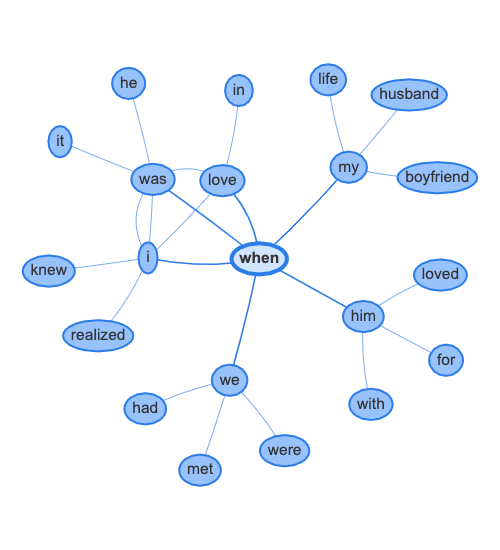
Figure 11. The word network for when.
-
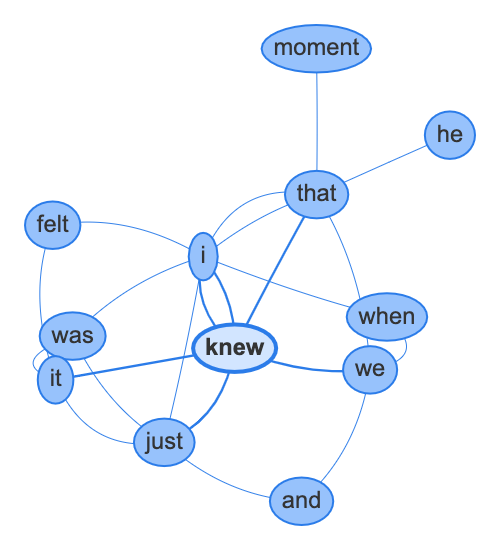
Figure 12. The word network for knew.
-
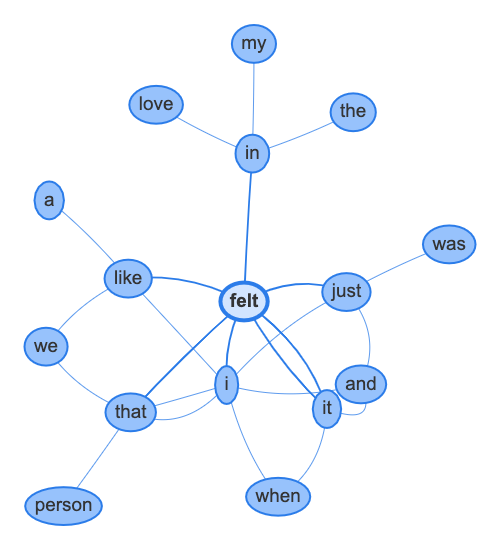
Figure 13. The word network for felt.
The most frequent and overrepresented word not associated with the mood or question was when. Figure 11 depicts the word network centering on this word. By putting the words preceding the word when in this network together according to the most popular order of placement in our participants responses, we arrive at such phrases as: in love when, it was when, with him when. As may be apparent, other phrases can also be constructed, such as: was love when, with him when, loved him when, for him when. Then, by putting the words following the word when in this network together according to the most popular order of placement in our participants responses, we arrive at such phrases as: when I was, when we were, when my husband. Other phrases can also be constructed, such as: when I knew, when I realized, when we had, when we met, when my life, when my boyfriend. Connecting the phrases preceding and following the word have reveal such combined phrases as: in love when I was, was love when we were, it was when we met, loved him when my husband.
The word network depicted in Figure 12 focuses on the word knew. Examining the most popular words preceding this word reveal its connection to the word when: when I knew, when we knew. Other phrases constructed from words preceding the word when include: that I knew, I just knew, and just knew, and we knew, that we knew. Examining the most popular words following the word knew reveal its relationship to the word felt: knew I felt, knew it felt. Other phrases contructed from the words following the word knew include: knew I was, knew that I, knew that he, knew that moment, knew it was, knew it just. Putting the preceding and following phrases together reveals such 5-word phrases as: when I knew I was, when I knew I felt, when I knew that I, that I knew that he, that I knew that moment, I just knew I was, I just knew that I, and just knew it felt, and we knew it was.
As may be apparent in Figure 13, creating phrases from the words surrounding the word felt reveal its connection to the moment or instance in which the participants became aware that they were in love, as well as to the object of that love, either self or other: when I felt like I, when it felt like we, that I felt in my, I just felt that we, I just felt in love, when I felt that person.
Know when someone is in love with you.
-
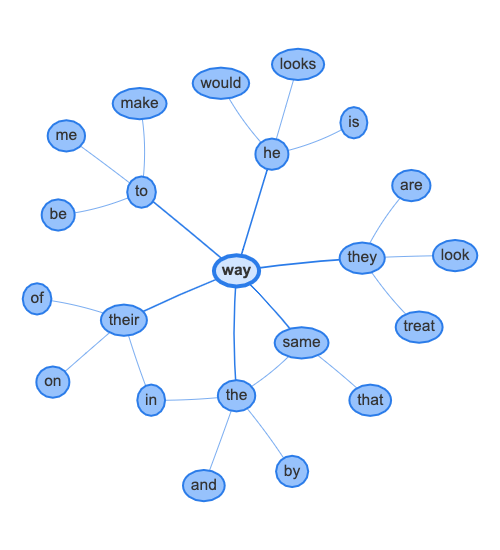
Figure 14. The word network for way.
-
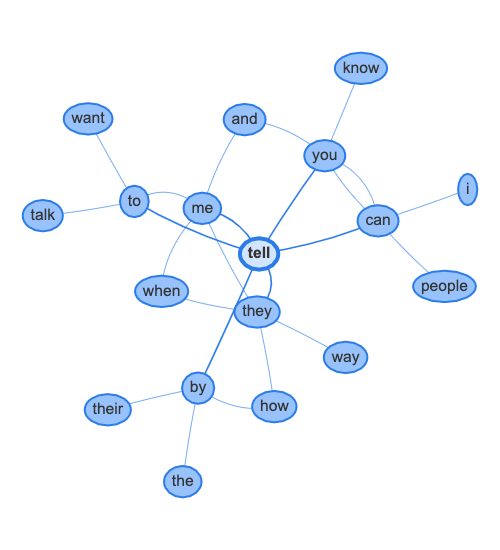
Figure 15. The word network for tell.
-
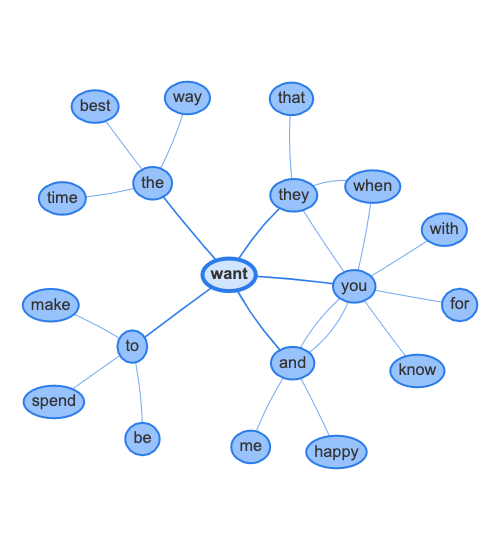
Figure 16. The word network for want.
The most frequent and overrepresented word not associated with the mood or question was way. Figure 14 depicts the word network centering on this word. By putting the words preceding the word way in this network together according to the most popular order of placement in our participants responses, we arrive at the phrases: by the way, in the way, and the way, of their way, in their way, the same way, that same way. Then, by putting the words following the word way in this network together according to the most popular order of placement in our participants responses, we arrive at the phrases: way they look, way they are, way they treat, way to make, way to be, way he is, way he looks, way he would. Connecting the phrases preceding and following the word way reveal the combined phrases (among others): by the way they look, by the way they are, by the way they treat, of their way to make, of their way to be, the same way he looks, the same way he would.
The word network depicted in Figure 15 focuses on the word tell. Examining the most popular words preceding this word reveal such phrases as: you can tell, I can tell, people can tell, when they tell, way they tell, how they tell, want to tell. Examining the most popular words following this word reveal such phrases as: tell you can, tell you and, tell you know, tell me and, tell me they, tell me when, tell by the, tell by how, tell by their. Common 5-word phrases that combine those words frequently preceding and following the word tell include: you can tell by the, I can tell by how, people can tell by their, when they tell me and, way they tell me when, me to tell by how, when they tell by how.
The word network depicted in Figure 16 focuses on the word want. Creating phrases from the most popular words preceding the word want results in: when they want, you they want, that they want, you and want, me and want, happy and want, with you want, for you want, when you want. Constructing phrases from the most popular words following the word want, in turn, results in creating: want to be, want to spend, want to make, want the way, want the time, want the best, want you and, want you know, want you when. Some 5-word phrases created by combining the most popular words preceding and following want include (among others): when they want to be, when they want to spend, when they want to make, when they want the best, when they want you and, you and want to make, happy and want you when, and want the time, when you want to be, when you want to spend,
Elaboration on the themes.
We can further elaborate on the themes so far presented to construct more detailed model statements. Doing so identifies ways that existing concepts connect with other concepts in the dataset. In this demonstration, we present such elaborations how we can do so by expanding the word network surrounding the first non-mood and non-stimulus related concept produced in response to each of our three parts: what being in loves means, becoming aware of being in love, and knowing when someone is in love with you.
Expanding the word networks.
What being in love means.
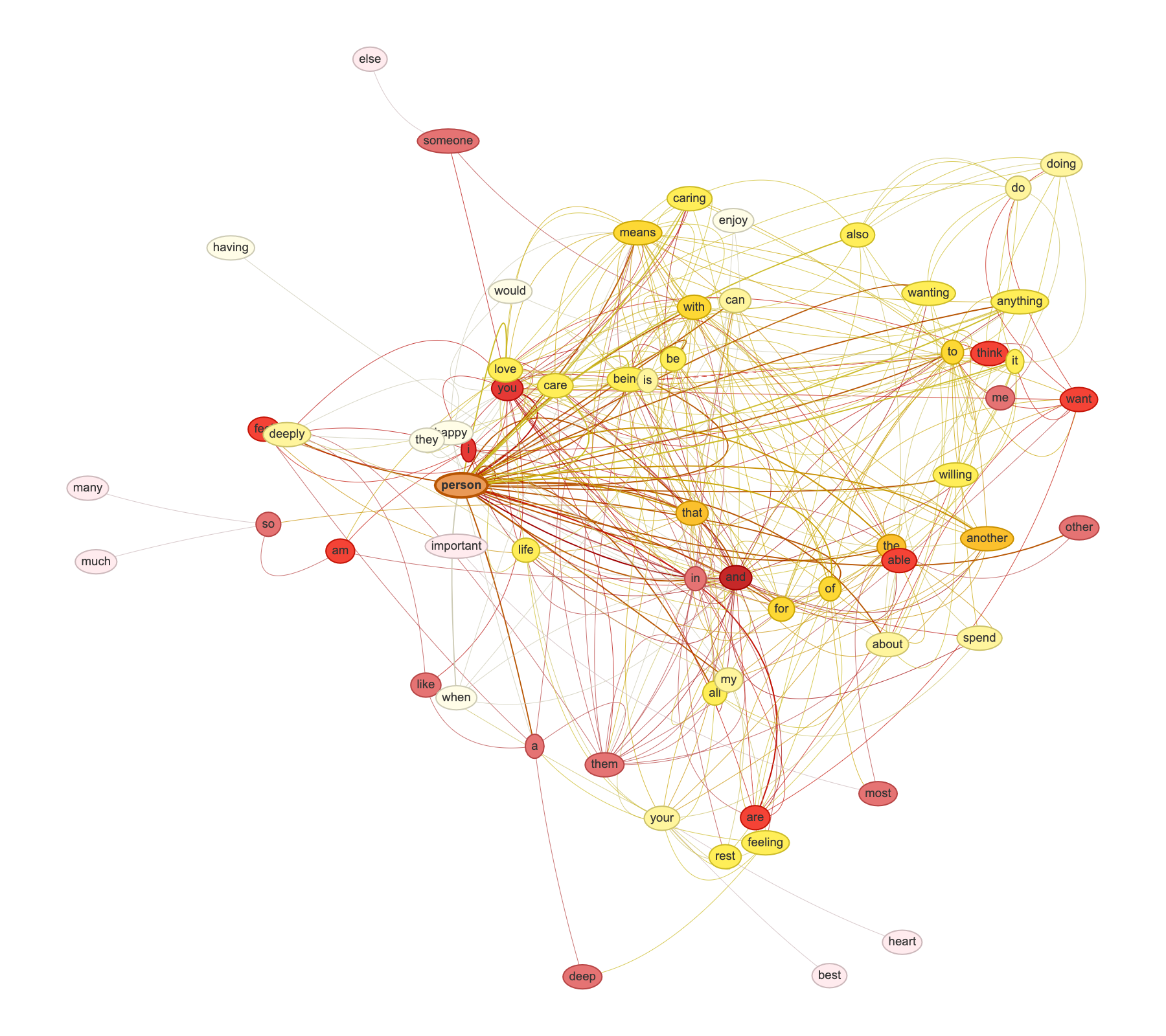
Figure 17. The word network for person.
In the expanded word networks presented in Figure 17, more elaboration becomes visible. In this figure, the target word person is depicted in orange, while the words following it are depicted in lighter shades of red for each word-level away from help they are located. Similarly, the words preceding the target word are depicted in lighter shades of yellow as they are found at an increasing number of words away from that word.
Comparing Figures 8 and 17, those words additionally associated with person become apparent, such as: able, about, am, anything, be, best, can, care, caring, deep, deeply, do, doing, else, enjoy, feel, feeling, happy, having, heart, important, life, like, love, many, most, much, rest, someone, spend, they, think, wanting, when, willing, would.
Becoming aware of being in love.
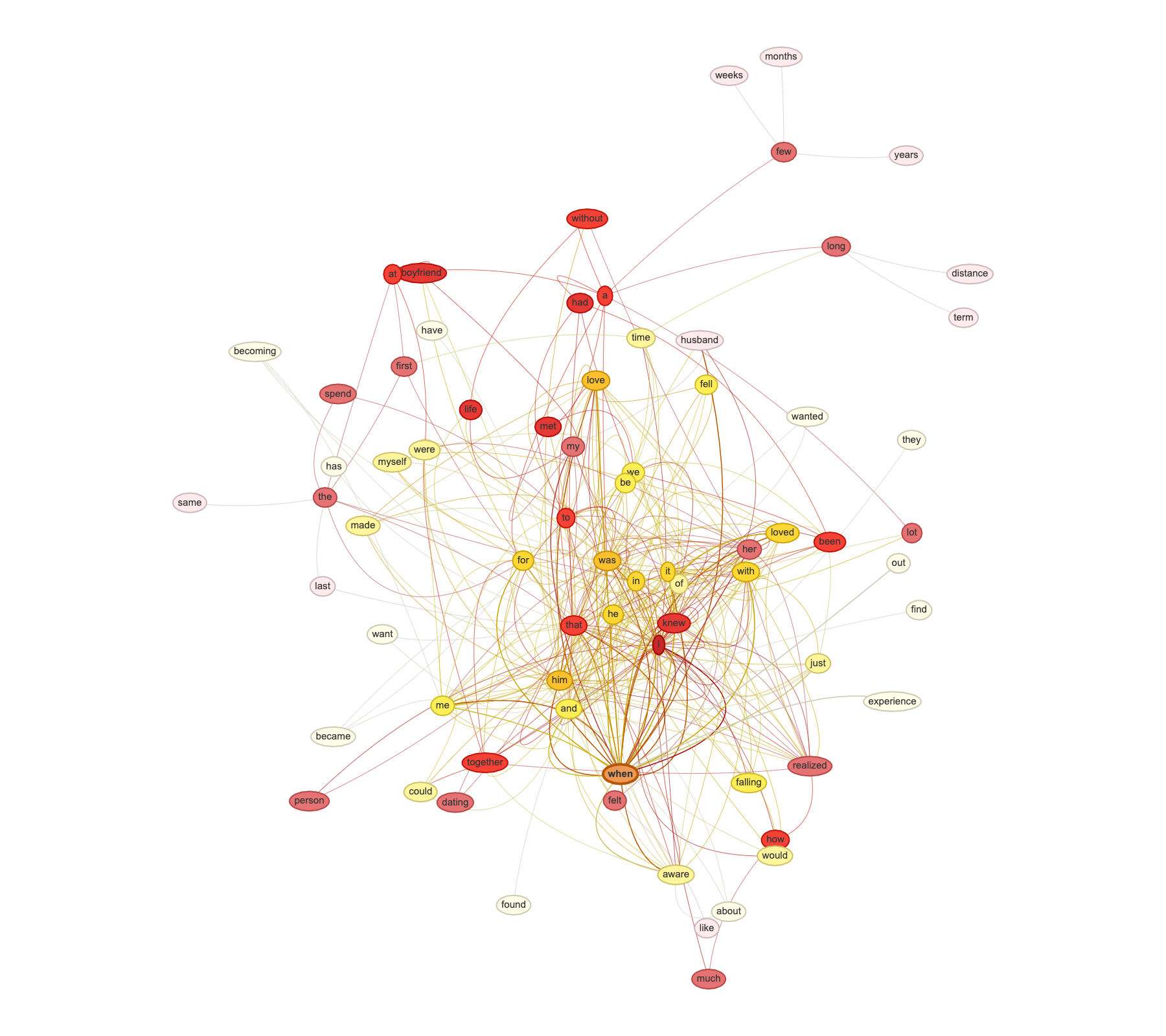
Figure 18. The word network for when.
In the expanded word networks presented in Figure 18, more elaboration becomes visible. In this figure, the target word when is depicted in orange, while the words following it are depicted in lighter shades of red for each word-level away from help they are located. Similarly, the words preceding the target word are depicted in lighter shades of yellow as they are found at an increasing number of words away from that word.
Comparing Figures 11 and 18, those words additionally associated with when become apparent, such as: about, at, aware, be, became, becoming, could, dating, distance, experience, falling, fell, felt, few, find, first, found, had, have, her, how, just, last, like, long, made, me, months, much, myself, person, same, spend, that, they, time, term, together, want, wanted, weeks, without, would, years
Know when someone is in love with you.
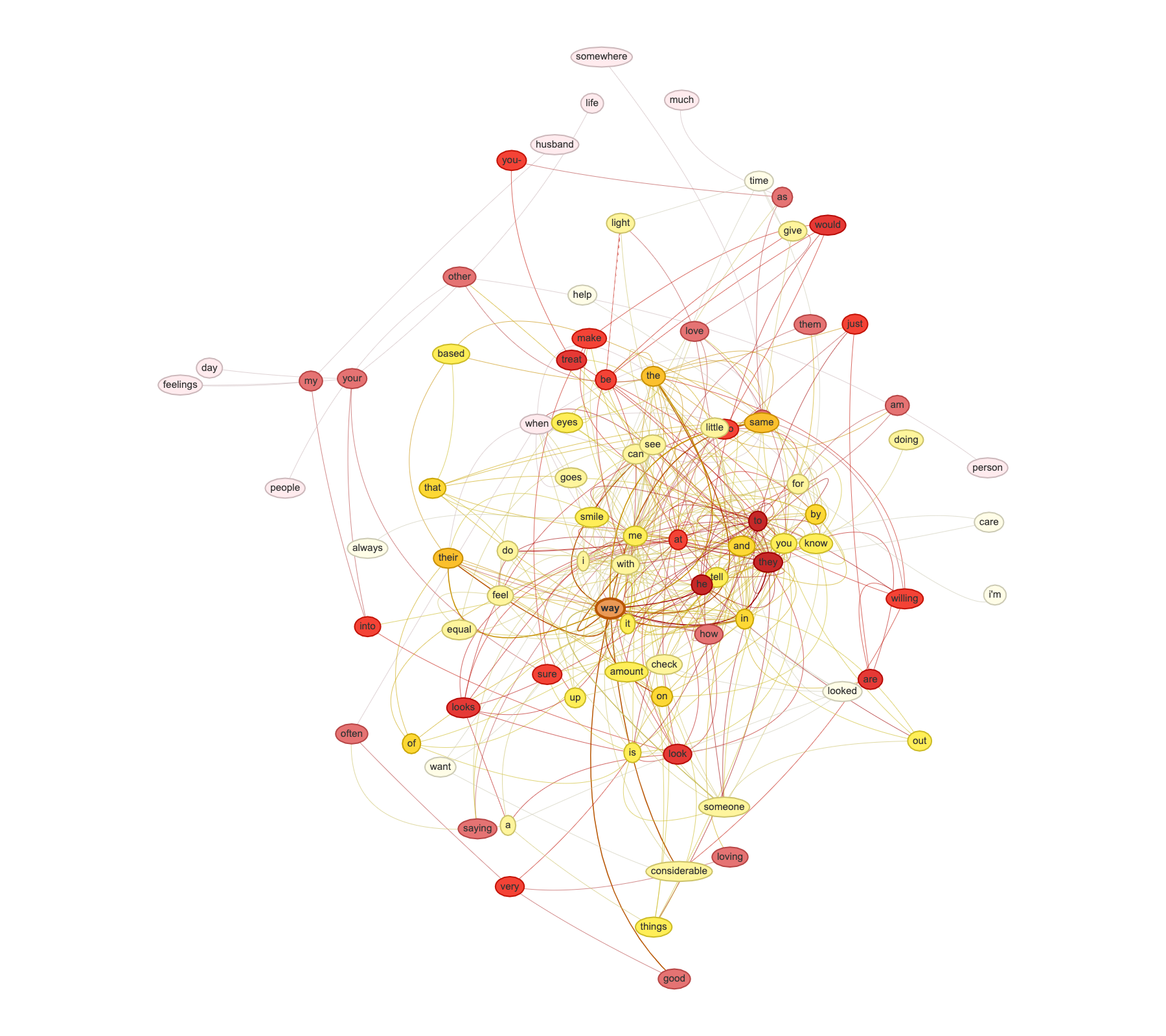
Figure 19. The word network for way.
In the expanded word networks presented in Figure 19, more elaboration becomes visible. In this figure, the target word way is depicted in orange, while the words following it are depicted in lighter shades of red for each word-level away from help they are located. Similarly, the words preceding the target word are depicted in lighter shades of yellow as they are found at an increasing number of words away from that word.
Comparing Figures 14 and 19, those words additionally associated with way become apparent, such as: always, amount, at, based, care, check, considerable, day, do, equal, eyes, feel, feelings, give, goes, good, help, I'm, into, just, know, life, light, little, looked, love, loving, much, my, often, other, people, person, saying, smile, someone, somewhere, sure, them, things, time, up, very, want, when, willing, you, your.
These expanded word networks elaborate on the actions, people, places, qualities, and things associated with each of the target words, and facilitate the construction of the foremost model statements listed at the beginning of this worldview for each open-ended question posed to our participants.
Essentializing themes.
As we noted in the section on gender when discussing the viewpoints in our panorama, self-identified females and males varied between their use of pronouns and social roles, most predominately when answering the question about becoming aware that they were in love. Specifically, females were more likely than males to use the pronouns "him," and, "he," and the social roles "husband" in their responses to this question. Similarly, males were more likely than females to use the pronouns "her," and, "she," and the social roles "wife." Such divergence can be examined as to its influence on themes and model statements, by comparing the relationships between these different pronouns, social roles, and other concepts during their actual use by participants. In doing so, those phrases that are convergent or universal can be identified to create an essential form of the theme that spans diversity in self-identified gender.
Females.
-
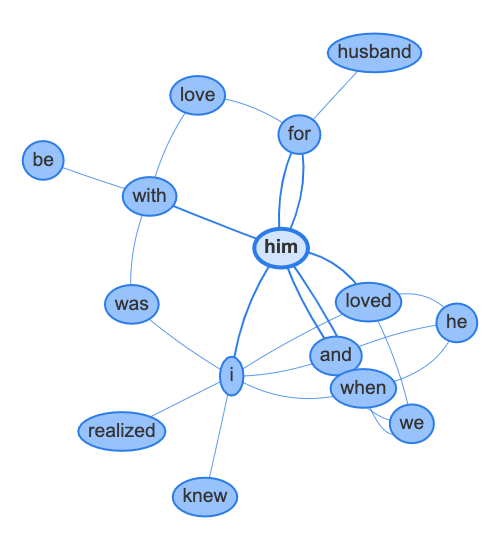
Figure 20. The word network surrounding him.
-
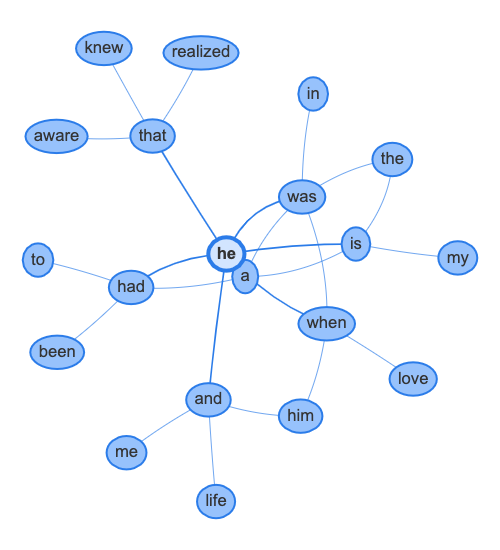
Figure 21. The word network surrounding the word he.
-
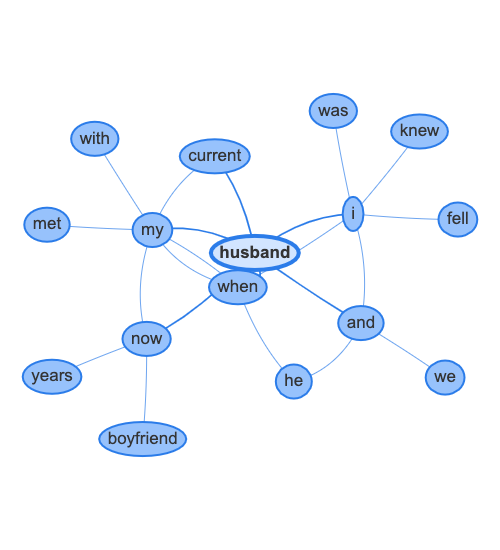
Figure 22. The word network surrounding the word husband.
Males.
-
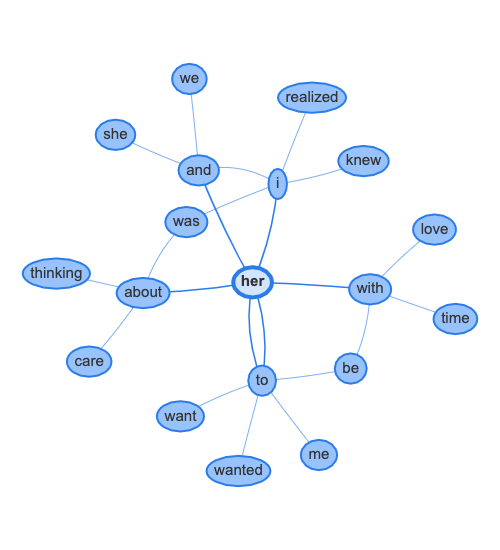
Figure 23. The word network surrounding the word her.
-
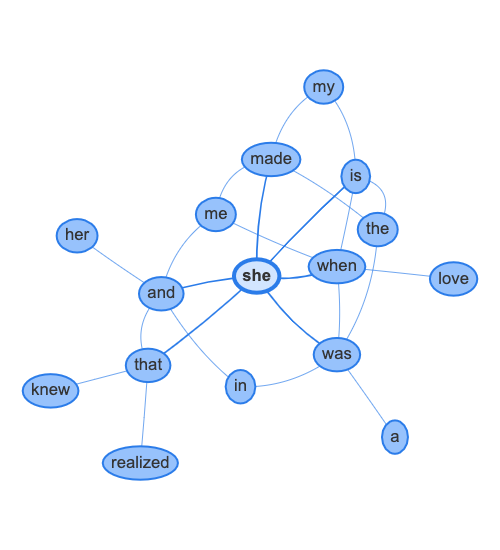
Figure 24. The word network surrounding the word she.
-
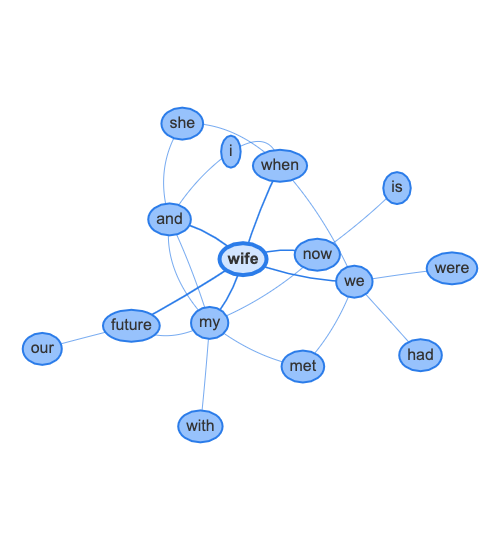
Figure 25. The word network surrounding the word wife.
The word networks for "him" and, "her," are depicted in Figures 20 and 23, respectively. Comparing the words associated with each target word reveals general similarity. Both him and her are most preceded by the phrase "love with" and most followed by the phrases "and I" (or "and she", or "and we"), and "I was" (or, "I knew," or "I realized"), in that unitary order. As long as our model statements follow these orders, then, there is no need to modify their structure based on gender, other than adopting a gender neutral pronoun. If we wanted, on the other hand, to explore diversity across reported genders, then we could also include statements constructed based on the non-shared words that appear (such as by including the phrase "love for," before the word, "him," among females-specific model statements, or "thinking about," or "care about", before the word, "her," in male-specific model statements).
Figures 21 and 24 depict the word networks for "he" and, "she," respectively. Comparing the words associated with each target word again reveals general similarity between the words associated with these pronouns. Both he and she are most preceded by the phrase "me and" and most followed by the phrases "was in" (or "was the", or "was a"). Both he and she are also both secondarily preceded by the phrase, "love when." As with "her," and, "him," long as our model statements include these phrases, there is no need to modify their structure based on gender, other than adopting a gender neutral pronoun. If diversity in model statements is desired, it could be represented by including somewhat less popular statements constructed based on the non-shared words that appear (such as by including the phrase "him when," before the word, "he," among females-specific model statements, or "is the," after the word, "she," in male-specific model statements).
Finally, figures 22 and 25 depict the word networks for "husband" and, "wife," respectively. As with the two previous examples, comparing the words associated with each target word again reveals a general similarity in the most popular words used with these social roles. Both husband and wife are most preceded by the phrase "with my" and most followed by the phrases "and I." Both husband and wife are directly preceded by the word now, and both are directly followed by the word when. As with the two previously discussed pronouns, as long as our model statements include these phrases, there is no need to modify their structure based on gender (other than perhaps adopting a gender neutral social role, such as, "partner," which is found more frequently in our responses than, "spouse"). Gender diversity in model statements could be represented by including somewhat less popular statements constructed based on the non-shared words that appear in these networks.
The interpretation.
Given the foremost model statements, panorama, and mood of the natural language analyzed in this survey, we find its contents to consist primarily of informal self-reflective and other evaluative descriptions of experiences related to being in love, becoming aware of being in love, and how participants come to know when someone else is in love with them. Being in love involves caring about another person, sharing your life with them, and feeling like you want to spend all of your time with them. Becoming aware of being in love primarily involves self-reflective thought (knowing) and feeling, and appears to be a somewhat spontaneous realization about a person with whom one typically dating or in a friendship. Knowing when someone else is in love with you primarily involves evaluating the actions, verbalizations, and desires of another person, and is often concerned with the manner in which they appraise you, direct communication of love for you, or desiring to be in your presence as much as possible.
The questions on being in love and knowing when someone is in love with you produced tendencies to recite a portion of the question itself when participants began their responses. However, the item asking asking participants to describe their last experience becoming aware that they were in love did not tend to do this as frequently—though some indeed did recite a portion of the item in response, it was not as popular of a tendency as found in the two questions. This could be the result of differences in wording: the two questions began with, "tell us," while the item on becoming aware of being in love began with "describe." It could also be an artifact of the the way the items were structured: the items on being in love and knowing when someone is in love with you were caste as questions, while the item asking participants to describe their last experience becoming aware that they were in love was not.
The phrasing in our foremost model statements do not vary in their content across the people, places, and time involved in our survey. Even though there is proportional disparity in female and male participation, because our model statements employ the most popular use of dually-gendered pronouns and social roles, and the phrasing surrounding these pronouns and social roles is functionally equivalent, such disproportionality does not therefore matter to the results reported herein. We can, therefore, generalize these foremost model statements to Americans similar to those participating in our survey.
The horizon.
Our results are bounded by the people, places, and time in which they were produced. For example, our participants were drawn from Amazon Mechanical Turk workers located in the United States. As such, they may have certain characteristics or experiences that vary from that expressed by the typical person in this nation. These characteristics or experiences may, in turn, systematically relate to variation in thoughts about a given topic.
However, there is an increasing tendency among American researchers in the social sciences to utilize Mechanical Turk workers to complete surveys intended for generalization to the U.S. population. Current studies comparing the demographics of Mechanical Turk workers to the background US population indicate that they may be somewhat younger, more educated, less racially diverse, and less affluent than the general US population.
We utilized a high threshold for creating a model statement around a concept in our report. In order for a model statement to be created around a given concept, that concept must have been expressed at a rate that exceeded 15 times its typical rate of use in everyday English3. This cut-off threshold of 15 makes it such that our confidence estimate for our results exceeds the total possible population of available Mechanical Turk workers in the United States at any given time4.
We are, therefore, quite confident that our results can be generally applied to this population, at least at this point in history. Generalization beyond Mechanical Turk workers to Americans at-large would then depend on whether or not the aforementioned differences between in affluence, age, education, and race influence the foremost model statements produced by this survey. Given: (a) the current research on variation in perspectives on love; (b) that we found no need to vary the content of the foremost model statements based on age, gender, location, or time of submission; and (c) that we utilized such a high cut-off threshold to construct a model statement around a given concept, we believe that our model statements can be applied to the general population in the United States at this point in history.
Notes.
1Amazon's Mechanical Turk (mturk.com) is an online marketplace of individuals willing to complete short Human Intelligence Tasks (HITs) for modest payment.
2https://ravens-eye.net Though, since you're already here, you can click on Home in the menu at the top of your browser window to find out more about us.
3To derive our rate of use, we compare the proportionality of a word in the sample to the proportionality of that same word in our 4.8 billion-word corpus of the English language. Based on a nomothetic approach to the lexical hypothesis, the amount to which a word is overrepresented (i.e., found at proportions greater than 1.0) also expresses the degree to which that word is associated with the stimulus (e.g., our open-ended survey questions) by the participants.
4The cut-off threshold that we used for our analysis makes it such that our confidence in the generalization of our results exceeds the average likely total population of Mechanical Turk workers available in the United States at any given time, and approaches maximum estimates. Current published Mechanical Turk population estimates indicate that such employment is transient and fluid. However, best estimates indicate an average likelihood of approximately 1,835 Mechanical Turk workers being available in the United States at any given time, and a maximum likelihood of 5,625 workers at any given time.
An overrepresentation score of 15 means that a given word is found in response to the question at 15 times its rate in the 4.8 billion-word background corpus of everyday English. Setting the overrepresentation cut-off score at 15 then, means that we do not create model statements from words with overrepresentation scores below this score. All else being equal, in order for a given word to be overrepresented by chance, we would need to acquire 14 times our current pool of respondents (980) who never once use the word again.
This would mean acquiring 13,720 more respondents (980 x 14 = 13,720 + 980 = 14,700, or 15 times the original pool of 980 respondents), each of whom would have to refrain from ever mentioning the word again. Given population estimates for Mechanical Turk workers noted previously in this footnote, this additional pool would be 2.61 times the maximum population estimate, and 8.01 times the likely population estimate of the total number of Mechanical Turk workers in the United States at any given time. Moreover, many of the words used to create our foremost model statements exceed the inclusionary threshold of an overrepresentation score of 15. For instance, in the responses to the what being in love means to you, feeling is found at approximately 329 times its background rate, want is found at approximately 36 times its background rate, and care is found at approximately 62 times its background rate. Therefore we maintain a high degree of confidence that the words used to create our model statements were not overrepresented simply by chance, and can be safely generalized to the wider population willing to take a similar survey.
5Fifty-three responses were eliminated because at least one of the answers to an item were copied verbatim from the internet, six responses were eliminated for containing less than three words in any one answer, and two responses were eliminated because their answers contained letters that did not constitute words.

